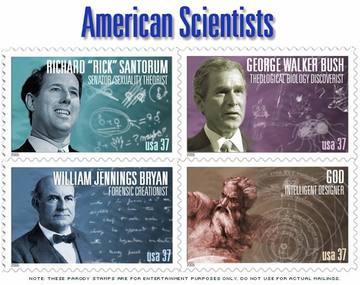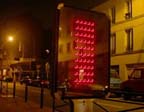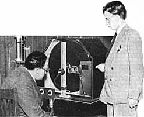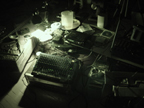« July 2005 | Main | September 2005 »
August 31, 2005
Marcel Duchamp:
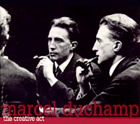
The Creative Act
A luminous text that will set the listener free! This CD is devoted exclusively to Marcel Duchamp and brings some very rare documents, all of which are crucial not only to understand Duchamp’s work but also grasp the rebellious, unconventional, anti-conformist spirit that was Zurich of 1919. Picasso and Duchamp: these two names span the extraordinary iconoclastic adventure of art in the early 20th century. Picasso, the incessant creativity where everything becomes art and Duchamp, ‘former Cartesian’ underminer of every received idea, Dada before Dada, inventor of the ready made and the Big Glass, cool humorist and debunker, creator of a creative universe, constantly being renewed, and creator of the mysterious person called Rrose Selavy.
Tracklist:
1. the creative act - lecture in Houston, Texas - April 1957
2. some texts from à l’infinitif (1912-1920)- lecture in New York, shortly before his death
3. musical erratum (la mariée mise à nu par ses célibataires, même) long before John Cage, the first aleotory composition.
4. an interview by George Heard Hamilton recorded in New York (1959)
5. an interview by Richard Hamilton recorded in London (1959)
6. musical erratum (a score for 3 voices) only score written by Duchamp for his 2 sisters
Visit GPod radio to listen. [via loreto martin]
Posted by jo at 11:59 AM | Comments (0)
Plug
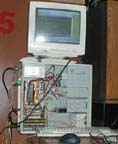
Global Headphone Festival
[Though it looks to be quite dysfunctional, this sucker sends the streaming Plug signal around the globe [Photo: Keith Axline].] "...In some ways Plug, held here Saturday, is just what you'd expect from a music fest: rotating performances in front of a live audience, socializing and plenty of beer. But the headphones (bring your own) replace a traditional concert's amplified speakers, and much of the socializing happens over a computer terminal linked to an IRC chat room, populated by members of the global audience listening to the performances over the internet...
The 13 hours of performances represented San Francisco's turn at the global le placard headphone festival, which hits cities all over the world, including London, Montreal, Paris, Brussels and Nagoya, Japan. Each city hosts a headphone party for a given period, in this case one day, before handing off the feed to the next location. Theoretically, this continues for 97 days in the hopes of providing one nonstop experience, though there are gaps in the schedule." From Fest Rocks With BYO Headphones by Keith Axline, Wired.
Posted by jo at 11:40 AM | Comments (0)
Repercussion.org

Virtual Instruments for Live Performance
Repercussion.org is a collection of on-screen virtual instruments designed for live performance and online user exploration. Rhythms and musical phrases can be dynamically composed and altered based on the arrangement of objects on the screen.
The collection is a showcase for the visual representation of freely-formed musical compositions. The project aims to be engaging enough to encourage the viewer to experiment, while being sophisticated enough to allow for a great deal of variation in the sound being created. The actual musical compositions are generated in real-time from a library of pre-recorded midi-based sounds, employing algorithms to map the on-screen graphics to characteristics of the sound arrangement such as pitch, tempo and volume.
The graphics were designed with a wide audience in mind, such that the concepts represented are accessible to a viewer regardless of his level of musical training, while at the same time matching the artist's idea of a basic kit of musical instruments for “jamming”: some drums, some melodies, a way to create chords, strings, etc. To be available to the largest online audience, Macromedia Flash was chosen as the medium. The piece is a work in progress that will be updated and customized. [blogged on media·teletipos]
Posted by jo at 11:19 AM | Comments (0)
American Scientists + Godcasting
[via Eyeteeth] + Godcasting.
Posted by jo at 11:06 AM | Comments (0)
Tube
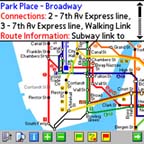
See Your Journeys Come Alive
Transform your PDA into a fully scrollable detailed map of the New York City subway system. See your journeys come alive with a superb animated display of the route tracking around the system map. Save hours by automatically having the quickest routes to hand, with all the details you need including line changes, platform directions and accurate journey times. "Tube, the absolute best subway mapping program for the Palm, has been updated to a significantly new and improved version. Incorporating subway lines and station information with either a system or street view, Tube even includes route planning and timing information to figure out the optimal series of connections during any time of day."- Josh Rubin [via]
Posted by jo at 10:55 AM | Comments (0)
Pink Noise
Urban Noise Pollution Displayed on Street Advertising Boards
Pink Noise by arts collective HeHe.org will be installed in Witte de Withstraat, Rotterdam on Sept. 10th, during the live event Hands On Hands Off organised by V2. Bruit rose (Pink noise in English): The interaction of this work is based on visualising the ambient sounds in the environment aswel as the passerby. The light emmitting panels, usually used to divulge numerically formatted information, are instead détourné from this didatic function and serve as an animated visual, disengaged from all the gloss that usually occupies this urban advertising space. [via URBAN SCREENS 05]
Posted by jo at 10:47 AM | Comments (0)
MINDPLAY:

Extended deadline for submissions
MINDPLAY is a one day conference on the social, intellectual and experiential dimensions of play and interaction in digital media environments. The conference focuses on mindful and playful relationships with digital media environments including mobile and ubiquitous media, new cinema, gameplay, wired performance spaces and networked communities. We encourage submissions of papers, practice-led research, poster presentations, demonstrations and installations. Selected papers may be published in a special issue of the journal Digital Creativity. Conference date: Friday January 20th 2006; Extended deadline for abstracts: Friday 30th September.
Posted by jo at 10:30 AM | Comments (0)
Mediamatic Interactive Film Lab @ Budapest

6-day Workshop
The Intermedia Institute of the Budapest Academy of Fine Arts is going to host a Mediamatic Interactive Film Lab. Intermedia has promoted the contacts of art and technology in the past years, building up an extensive network in Hungary and Europe. As part of its diverse interest in non-linear modes of narration, the Intermedia Institute invites participants to share experiences and create prototypes for online interactive film projects.
The workshop is designed for up to 16 film-, tv-. radio-, or new media makers from all over Europe. You can use your own footage (up to 40 min) to make an interactive film and publish it on- or offline. The approach is interdisciplinary and introduces new media and cross media content production to people with a background in filmmaking.
The workshop focuses on the cinematic aspects of online interactive film and on issues of combining narratives with interactive possibilities. Participants use the ever-evolving Korsakow software to build their new media projects. Developed by the UdK Berlin and Mediamatic, Korsakow is a powerful, elegant, and easy to learn editing tool.
This 6-day workshop takes place from October 3 - 8. It starts with a symposium and ends with a public presentation of workshop projects.
The price of the workshop is 200 EUR for EU citizens of the new memberstates, and 300 EUR for EU citizens of older member states. Mediamatic provides fully equipped Apple Computers for this workshop.
For more information go to www.korsakow.org or call Klaas Kuitenbrouwer: +31 20 6389901.
You can register online.
To prepare for the workshop we provide an online reader with related articles on interactivity and narration.
Posted by jo at 09:10 AM | Comments (0)
Pillow Talk
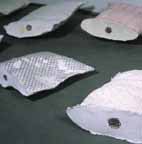
Pillow Secrets
Babs Reingold and Caroline Burton seek participants to reveal a secret by posting one or more on their Pillow Talk website. Pillow Talk is a two-person exhibit that illuminates as object the symbolic pillow and all that it implies. What if pillows could talk? Exposing our intimate secret conversations, obsessions, longings and fears. The concept for Pillow Talk embraces the need to reveal and store our secrets in a safe place.
All secrets submitted on the site will be utilized in the exhibit and in the opening night performance. Their specific use in the exhibit will be disclosed on the site at the start of the show. Before the exhibition, you may continue to view the secrets submitted on the site, the postings will remain on the site until the close of the show.
Posted by jo at 07:56 AM | Comments (0)
Readers for "Mobtagging DisCourse" and "Triggered by RFID" at Mediamatic
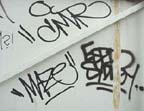
Theory, Projects, Criticism, Resources
Reader for Mobtagging DisCourse: Mobtagging is the practice of a large group of users who freely apply and exchange tags (metadata) to a set of unstructured online information. The aim is to describe content more adequately, personally or pinpoint interesting information faster than a search engine or online directories. Mob – or Social tagging can provide more precise search results for specialized interests and as such is a form of Commons Based Peer Production (CBPP).

Reader for Triggered by RFID: Radio frequency identification is a technology that is now situated in the elevator of technical development. A growing number of logistical companies see the advantages and possibilities of RFID for managing large bodies of objects. But what uses can this technology be applied to that are not in the logistical realm? How can it serve and/or change society and human interaction? How does it change the concept of information and information networks as we know them today? This reader compiles a number of resources on the technical and philosophical aspects of RFID.
Posted by jo at 07:17 AM | Comments (0)
August 30, 2005
Pedestrian:
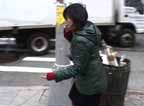
A Walking Tour for Multiple Voices and Portable Phones
Pedestrian: A Walking Tour for Multiple Voices and Portable Phones--by Geek Ink--is a performance piece that takes New York audiences on walking tours in groups of ten on three separate routes led by three actresses through the East Village. It allows the participants to "eavesdrop" on cell phone conversations exploring the topic of loss - from lost tempers and lost loves to lost identities. Pedestrian explores the public airing of private speech, which occurs daily on the streets of New York. Connected by cell phones, the actresses invite the audience to overhear their conversations, confessions, and revelations; in fact, all participants are connected by a conference call service, allowing each tour participant to hear all three tour guides simultaneously. The audience follows these women through the streets, taking a journey through the emotional lives of the tour leaders, while interacting with many East Village landmarks that may have gone unnoticed until now.
Geek Ink is a not-for-profit company dedicated to producing challenging, high-quality entertainment by presenting an examination of ideas with a liberal dose of irreverent humor. It seeks to nurture a diverse theatrical community that includes people of all backgrounds on both sides of the curtain. Toward this goal, Geek Ink is committed to making the cost of theater-going within reach of all New Yorkers.
Posted by jo at 12:25 PM | Comments (0)
Installation

Virtual Constructs Real Space
"Installation is a system designed by Simon Greenwold at the Aesthetics and Computation Group at the MIT Media Lab, consisting of a viewing window and a stylus with which users can create virtual forms and install them permanently into a real space. By tracking the position and orientation of the stylus and the window itself, we are able to calibrate virtual coordinates with real viewing position. Virtual objects created in the system respond as though they were physically in the space of the room. Once objects are placed in the envrionment, they will stay there in perpetuity, changing and growing like plants in the air." View demo. [via]
Posted by jo at 12:15 PM | Comments (0)
Screen-Wall
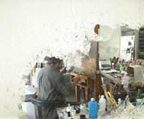
When Bricks Become Pixels
"When bricks become pixels, the tectonics of architecture becomes informational"- Marcos Novak: Screen-Wall--by Ruth Ron--challenges the conventions of public and private spaces in a museum. The 'service' or 'private' parts of the museum, such as the archives, offices or the guard booth, which are traditionally closed to the public, become the subject of the display, reversing the relationship of 'watching' and 'being watched'. Influenced by the expending presence of surveillance in our daily life, we appropriate the panoptic gaze onto concealed parts of the museum to become the content of the exhibition display.
The opaque solidity of physical architecture is challenged by multiple layers of the screen, the image of the wall and the transition to live video feed. The distance between remote spaces in the museum collapses, and digital and visual continuity is created. The network portal extends beyond the properties of the flat digital screen to become a reactive 'window' to unexpected places.
System: Parts of the gallery walls are replaced by small flat monitors. At first, the screens perform as mute, still images of their supporting walls. Once an observer draws near, the image transforms into a live video feed of a remote 'service' location of the museum, streaming via the internet. [via]
Posted by jo at 11:43 AM | Comments (0)
TeleSon: Invention#8 by Chris Brown

Networked reacTables
TeleSon: Invention#8 is composed for four musicians playing two networked "reacTables", one each in Barcelona and in Linz, Austria (ICMC2005). The reacTable is a new electronic music instrument developed at the Music Technology Group in Barcelona by a research team headed by Sergi Jorda. Brown explains: 'I have interfaced my own synthesis engine, written in SuperCollider3, to the reacTable's visual and gestural interface, thus composing my own synthesis environment with its own rhythmic and tonal character. Like the other works in my "Inventions" series (recorded on Pogus CD "Talking Drum"), this piece involves polyrhythms, computer networks, and improvisation. Like "Invention #5" (1999), it also involves musicians collaborating at great physical distance from each other'. See Sounding the Net: Interview with Chris Brown by Peter Traub.
Chris Brown, composer, pianist, and electronic musician, creates music for acoustic instruments with interactive electronics, for computer networks, and for improvising ensembles. Recent recordings of his music are available on Tzadik, "ROGUE WAVE" (2005) and "LAVA" (1992); and on Pogus, "TALKING DRUM" (2001). He has also performed and recorded extensively with "The Hub", "Room", and the "Glenn Spearman Double Trio". As a pianist he has recorded music by Henry Cowell, Luc Ferrari, and John Coltrane; as an electronic musician, he has collaborated with John Zorn and Wadada Leo Smith. He teaches electronic music at Mills College in Oakland, where he is Co-Director of the Center for Contemporary Music (CCM).
Posted by jo at 11:24 AM | Comments (0)
Surface Tension
![]()
Mobile Art Projection Program: Call for Proposals
ANAT is now calling for proposals from South Australian artists or artists groups, for dynamic temporary public projection artwork. Four artists or artist groups will be commissioned to produce projection works that are experimental, conceptual, and respond to Surface Tension's guerrilla-style approach of presentation and use of mobility to take art to the audience. Selected artists will present their Projection Artworks consecutively in the period November 2005 - March 2006. To download a Surface Tension program outline and proposal guidelines, please go to the ANAT website, 'Surface Tension: ANAT's mobile projection project call for proposals' News Item.
Deadline for proposals is: September 2, 2005
Notification date is: September 12, 2005
Successful artists will be required to complete their artwork by late October.
For further information, please contact
Jen Brazier
projection[at]anat.org.au
tel: (08) 8231 9037
m: 0413 564 474
Gus Clutterbuck
m: 0407 721 532
Surface Tension has been made possible through Adelaide City Councils Public Art program, and will be delivered in negotiation with Council by the Australian Network for Art Technology (ANAT).
Posted by jo at 10:02 AM | Comments (0)
Activated Spaces + Crawling through Network Cable
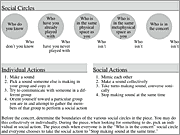
Sounding Jesse Pearlman Karlsberg
"Abstract: Successful political sound art comes in a variety of forms. Interactive sound art can upend entrenched social relations around the consumption of media. Work articulating obscured spacial or social power dynamics can provoke deep thought and discussion. Work incorporating explicit documentary material can dovetail successfully with social movements, enlivening events, and serving as a mechanism for fundraising, awareness raising, or mobilization. These different tracks can be employed, singly, or in combination to make effective political art work for a variety of settings. This thesis follows one sound artists' path through the multiplicity of potentially rewarding approaches to creating artwork with political and social themes." From Activated Spaces by Jesse Pearlman Karlsberg.
Crawling through Network Cable is a framework for group improvisation, exploring the social conditions of live distance collaboration. Musicians and video artists are in two remote locations, connected by networked computers running iChat AV or other videoconferencing software. The performers improvise responding to other performers in their own location and the remote location, paying special attention to the features of improvising with physically remote collaborators.
As source material, performers in Crawling through Network Cable should start with the physical infrastructure that connects the two locations: copper network cable, projectors, computers, routers, firewalls.
Crawling through Network Cable was composed by Jesse Pearlman Karlsberg. Musical performance at Rensselaer by Nik Kanter (keyboards), Pauline Oliveros (concertina, harmonica, goat hooves), Jesse Pearlman Karlsberg (laptop). Musical performance at Wesleyan by Dave Kadden (oboe), Angela Opell (clarinet), Anne Rhodes (voice). Live video by Kathy High and Caterina De Re at Rensselaer and Will Swofford at Wesleyan.
A score for structured improvisation for video artists and musicians in two locations, connected by networked computers running videoconferencing software. View the performance score (PDF). Audio and video from Crawling through Network Cable will be posted in Fall 2005.
Posted by jo at 09:22 AM | Comments (0)
Hard Drive Orchestra
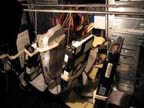
Radio Taking Place Between the Ears and Behind the Eyes
Hard Drive Orchestra--by Fundamental Radio (August Black and Markus Seidl)--is a sculpture and instrument that can be programmed to run autonomously as a stand-alone installation or played live and intuitively in a performance taking control commands via OSC, midi, or some other input protocol.
The hardware component consists of a mobile computer containing 8-16 IDE and SCSI hard drives of various ages of computing history and therefore of various sonic properties. The mechanical sounds of the drives are recorded live with 8-16 separate contact microphones, cleaned by a noisegate, and amplified over loudspeakers.
The software component consists of two objects written in C for PureData. One object performs very specific read-write operations on the various hard disks in order to force the disk's head to move from the innermost part of a drive's platter to the outermost part and back again. This results in an audible grinding click. The second object reads the data being written on each disk and blits it to the video screen. Essentially, the first object allows one to control the sonic activity of each drive while the second object simply displays the data to screen.
With the Hard Drive Orchestra, Fundamental Radio can analyze and present the physical, mechanical, and most importantly, the aesthetic properties of stored information. The HDO has premiered with "The Physical Mechanism of Forgetting" at the Freud Museum in St. Petersburg [Bolshoi Prospekt, Petrogradskaya Storona, 18a] as part of Traumlandshaften festival from October 7-10, 2003. There, the successive versions of the ****soft operating system have been deleted, slowly, over a week cumulating into a live performance of found and submitted data.
Posted by jo at 09:08 AM | Comments (0)
UserRadio
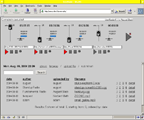
Spreading the Space of Radio Production Amongst its Listeners
"Abstract: Userradio mixes the new technologies of personal communication with "old'' broadcast radio technology. It is a set of tools for collaborative networked audio production, where an unlimited number of individuals can mix multiple channels of audio simultaneously and together from anywhere on-line using a standard flash-capable browser. The audio output of the application is broadcast on terrestrial FM radio and the users are ideally within the broadcast diameter." From Userradio by August Black.
Posted by jo at 08:22 AM | Comments (0)
Community Media:

People, Places, and Communication Technologies
While transnational conglomerates consolidate their control of the global mediascape, local communities struggle to create democratic media systems. This groundbreaking study of community media combines original research with comparative and theoretical analysis in an engaging and accessible style. Kevin Howley explores the different ways in which local communities come to make use of various technologies such as radio, television, print and computer networks for purposes of community communication and considers the ways these technologies shape, and are shaped by, the everyday lived experience of local populations. He also addresses broader theoretical and philosophical issues surrounding the relationship between communication and community, media systems and the public sphere. Case studies illustrate the pivotal role community media play in promoting cultural production and communicative democracy within and between local communities. This book will make a significant contribution to existing scholarship in media and cultural studies on alternative, participatory and community-based media. -- Community Media: People, Places, and Communication Technologies, Cambridge University Press, 2005
Posted by jo at 07:11 AM | Comments (0)
GARY DUSCHL
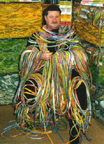
GUINNESS WORLD RECORD GUM WRAPPER CHAIN
The Gum Wrapper Chain is currently--as of AUGUST 11, 2005--1,096,015 WRAPPERS, 46,861 FEET. About the Chain: Began on March 11, 1965; $53,833 Worth of Gum; Weight 633 lbs. or 286 kgs; Volume 54 Cubic Feet; WRIGLEY Wrappers only. Relative Lengths: 8.72 Miles or 14 kms; 153 Football Fields; 230 Hockey Rinks; 25 CN Towers; 31 Empire State Buildings; 2 Rounds of Golf; 3 Hours to Walk the Length; 8 Minutes by Car at 65 mph.
Save, sign and send me your gum wrappers and I will ensure that these wrappers become part of this world record gum wrapper chain. Include your email address so that I can let you know where they appear on the chain. Send your wrappers to: Gary Duschl, Box 65464, Virginia Beach, Virginia USA, 23467.
Posted by jo at 07:08 AM | Comments (0)
August 29, 2005
A Public Fashion Orchestra
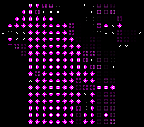
Network Revealed
Temporary networks (ad-hoc wireless networks) are designed to be "visible" to devices only, not to people. Without consulting our devices, we can't tell whether this minute we are participating in a network or not, and we are not asked whether we want to either.
Public Fashion Orchestra--by Alexandra Von Feldmann (with Stuart Wood)-- combines the conservative "wearable" network (e.g. networked wireless enabled mobiles) with an alternative, truly "wearable" and visible network.
The project envisions a fashion house which would sell intelligent clothes and their behaviours. All the clothes are networked with each other and when in range they can share designs and eventually other data; the fashion designer is able to feed new designs and behaviours into the system.
The clothes receive, transmit, transform and show the data, but they can also remember and limit it: once the clothes are "full", they cannot participate in the network anymore unless you get rid of their data with the brush of a hand.
While dressing up, the wearer can activate the clothes. As soon as he/she encounters another fashion network member, communication between the two is triggered by an RFID-Tag embedded into their garments. Once communication is established, data is being transmitted by the devices carried by the users (e.g. wireless enabled mobiles). [blogged by Regine on we-make-money-not]
Posted by jo at 11:56 AM | Comments (0)
denCity.net

Virtual Networks of Real Places
denCity.net--by Kai Kasugai und Philipp Hoppe--examines the enrichment of real urban sites by a virtual dimension of information and networking, being accomplished by localisation of the virtual. It is about moderating between "virtual reality"-networks and the city as physical existence. Places and objects of the city get a virtual identification in the form of a QR(bar)-code. This code contains - in digitally readable form - the most important information of the respective location: its tag-ID and GPS-coordinates. Shot and decoded on the fly using a common camera-cellphone, through the tags one connects to the dataweb, which consists of site-specific information.
denCity.net provides information to the specific place. From there, you can browse through the web of tags. The tag is the key. Once shot, you can always return to the places, virtually. It's the city in your pocket. Anyone can tag places and thus create a new denCity-site. Just log in to denCity.net - create a spot on the map and print the tag to attach it to the real-world location.
One could think of the most different kinds of content. Public an commercial tags for example basically contain information of opening hours, offers, events etc.; they form a dense map of the city's service- and supply-infrastructure. In terms of organisation, denCity.net develops a hybrid structure between the functional mixture in the real urban space on the one hand and the associative zoning / grouping of topics in the dataweb on the other. A contracion of space ist generated, places move closer and build a functionally denser texture. Private tags, in contrast, contain matters of rather informal kind. Everyone can create and attend them, for instance "spots" (virtually anyone can create new spaces by creating a tag at site, thus giving it character/properties/information) which emerge at street corners or trees and mean a personal reference to an urban place. These tags are virtual forums in the actual cityscape and live of comments of passerbies and interested.
denCity.net is a map-based database-system. It links information (on the "virtual" level) and in doing this considers the locality of the tags (on the "real", urban level). All relevant information and data links concerning the particular user-request are released cartographically and depend on the desired degree of locality.
This information exchange layer, through the tags's crosslinkings and referencing among each other, features a multidimensionality which oscillates between the local and the virtual. The tags are digital yet visible marks in the city, at the same time virtual and physical addresses. They establish interfaces between locality and virtuality.
dencity.net not only ties a dense net of information but also directly affects the urban density because of the information beeing site specific. Informational and actual density are strongly interdependent. Fluctuations of density are immediately documented, trends become noticeable much earlier. Through this, flexible planning and interaction is made possible, which for instance facilitates reaction to shrinking processes (mentioned in a recently published spacial planning report (Raumordnungsbericht 2005) of the "German federal office for building and regional planning" (Bundesamt für Bauwesen und Raumordnung). Furthermore, it has to be mentioned, denCity is an emergent system, which could fundamentally question or at least amend urban planning methods. In this context also consider the current debate on "governance" and the "shrinking cities"-design competition.
This internet presence of denCity is a demo version, that simultaneously serves for development as for presentation of the project. The final user interface will principally be the mobile phone, on which all functions are available. The decipherment of a QR-code via a mobile camera phone is a already a common technology in Japan, mainly used in the shopping sector. Through the WAP-compatibility of denCity.net, ie. the direct access on tag information via mobile phone, we intend to demonstrate how the future utilisation will feel like.
denCity.net is an experiment concerning the territorialisation of the virtual and the deterritorialisation of the physical, en route to an augmented perception of urban reality and density. It's about "density", "city", about "den" (which in japanese means "electronic"), and about "nets"...
Posted by jo at 11:38 AM | Comments (0)
August 28, 2005
Improbable Orchestra + Burning Man
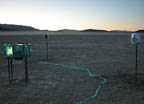
Tribal Knob Twiddling in the Desert
The Improbable Orchestra (IO) is an interactive audio installation designed to make digital music accessible to anyone. It consists of a central control unit surrounded by four speakers designed for up to four users to each control a sound sample using manual controls (knobs and buttons).
This sound installation was designed by our team to accomplish the following goals: 1. to create a tool to allow any user to experiment with working and designing music; 2. to create a visually appealing structure that creates a musical space; and 3. to create a musical tool that allows interaction between different players while they experiment with music.

Burning Man: Laser Harps, Improbable Orchestra Knob Boxes
For some of the most bizarre and unusual music-sound installation art, look no further than Burning Man [Related 1, 2, 3]. Burning, indeed: this desert-based event has in the past featured Eric Singer's Max/MSP-controlled pyrophone, a propane-powered flaming sound organ. (And, incidentally, that installation is making a repeat appearance this year.)
And what better activity when in the middle of the desert than tweaking knobs and producing strange electronic grooves? That's the idea behind improbable orchestra, an interactive table full o' knobs for collaborative soundmaking. Build one yourself: check out the copious design notes. Basic specs: the free Pure Data graphical multimedia development environment is running sounds, gutted Pentium PC with custom power supply, custom circuit board connecting the knobs and fiddly bits thorough a Parallax basic stamp board. (Lots more specs on their site, missing only details of the Pd patch.)
"But," says you, "I hate knobs. Give me lasers, man." Sure! You obviously want the interactive Aeolian laser harp, which suspends a series of laser beams through which you can walk to trigger sound. It's the creation of former NYU ITP faculty member Jen Lewin, now based in Colorado and doing interactive sculpture full-time. She has other fantastic projects like interactive butterflies. [blogged by Peter Kirn on Related.
Posted by jo at 10:22 AM | Comments (0)
August 27, 2005
Obsession
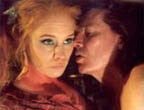
Manuscape: An Instrument for Non-Linear Storytelling
"I have just got back from Helsinki where I saw Pia Tikka's interactive film Obsession at Kiasma Art Museum. This is a four screen work of immense complexity, working with an automated rules-based system of clip selection, influenced by an audience's physiological reactions to what is seen on screen. Swivelling chairs allow the programme to compile data on viewers's gaze direction, while an interactive handprint on the chair arm picks up subtle alterations in skin conductivity and pulse rate and augments the presentation of image according to arousal states. The subject of the film is sexual obsession and attitudes to rape-conflating female desires and fantasies with a semi-documentary narrative. This is an innovative work, using aspects of audience mobility and biology to alter content." [blogged by Martin Rieser on Mobile Audience]
Obsession (2003-), Finland
Project URL: http://crucible.uiah.fi/crunet.nsf/etofilmpages/obsessio
Actor: Media Lab / University of Art and Design
People: Pia Tikka, Rasmus Vuori
Genre: interactive film/ installation and research project
Obsession is an interactive film/ installation and research project by film director Pia Tikka which uses motion sensors, cinematic metadata and generative algorithms. The participant has control over the drama flow in a manner that respects the affective nature of the cinematic media, where the participant may even lose conscious control over the flow of the events. Both conscious actions and unconscious sensorimotor reactions of the participant‘s mind/body can have effect on the narrative. Analyzed images are assigned a position in the narrative story-world map, i.e. the manuscape. The manuscape works as an instrument for non-linear storytelling and allows development of a range of interactive multimedia applications. Interaction and software design by Rasmus Vuori.
From the project web site:
Obsession is an attempt to describe, how the traumatic acts of violence not only affect the individual, but how his or her family and the life-environment are also violated. The narrative level of Obsession, in regard to its subject matter of "sex and violence" in our representational culture, brings this important subject matter to the focus of discussion. Inside the four walls of a self-service launderette, young Emmi and an entrant stranger, Henrik, measure embodied distance. From their interaction, a loaded emotional situation emerges, framed by a trauma that Emmi and Emmi’s mother Jatta share. The distorted mind of Emmi creates an endlessly wandering path of narrative potentialities and interpretations.
The computational core of Obsession is a narrative engine, based on content metadata. Inspired by the Russian film theorist Sergei Eisenstein (1898-1948), the”montage-machine” of Obsession maps spectators’ psycho-physiological states to cinematic elements. Obsession is a kind of enactive cinema: How the narrative unfolds, and how rhythm and soundscape are formed, depend on how the spectator lives by the emotional dynamics between the characters.
Posted by jo at 01:03 PM | Comments (0)
Parasite + Parallel Worlds
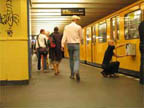
Mobile Movies
Parasite--by Frédéric Eyl, Gunnar Green and Richard The--is part of the Moving Canvas series; it investigates the visual and symbolical importance of trains in an urban context and the possibility of exploiting them as brief communicative moments.
Affordable mobile video-projections could be used to re-conquer public space often only reduced to graffiti and streetart. The tunnels of a subway-system bear something mystic—most people usually have never made a step inside any of those tunnels. Parasite is a projection-system that can be attached to subways and other trains. Using the speed of the vehicle as parameter for the projected content, the projection starts with the train moving inside a tunnel.
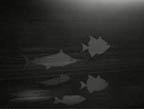
All along their journey, travellers see images mysteriously appearing through the train windows: words, aquatic animals, etc. Confusing the routine of your train-travelling-journey, your habits and perception Parallel Worlds allows you a glimpse into a different world full of surrealist imagery.
Don't miss the video. [blogged by Regine on we-make-money-not]
Posted by jo at 10:25 AM | Comments (0)
wave_scan

Allegorical Mapping of the Liminal
wave_scan, by Brad Todd, is composed of an ELF (extremely low frequency) sensor, an antenna and a projection of a video database of water filmed over the past 15 years in different countries.
The system is centred around the ELF sensor. In paranormal research these electric and magnetic fields are also monitored by people searching for ghosts and other inexplicable phenomena: "cold spots" and other signs of paranormal activity reported by persons who think they are seeing phantoms are in fact closely tied to these EMF fields.
The ELF sensor is attached to an old TV antenna and is transmitting to a computer. Any detection of weak fluctuations of frequencies near the antenna results in the direct manipulation of a soundscape which is generated using a sine wave and white noise to create synthetic oceanic sounds. Any readings are also translated as clicks and pops, thereby creating a minimialist audio environment which gives audible evidence of a "presence" in the space.
Besides, the image slowly works itself from full chroma to blank, depending on the number of "hits" in the space. This sense of effacing the work and rendering the image into a ghostly and finally invisible screen closes a circuit or cycle of the works "life", in an allegorical mapping of our anxiety concerning the unseen or liminal... [blogged by Regine on we-make-money-not]
Posted by jo at 09:15 AM | Comments (0)
August 26, 2005
Residual Data-Cloud
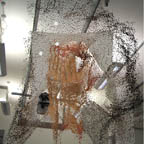
Residual Memory Immersed, Materialized in a Real Environment
The Residual Data-Cloud--by Diogo Terroso--is an application that loads images from a networked source and generates a data-driven three-dimensional form. Images are collected via a digital camera, or a mobile phone, by the author and participants during presentation. The resulting shape, which resembles a cloud of dust, is a metaphor of residual memory immersed and somehow materialized in a real environment.
Digital appears here as a parallel dimension, in which user’s perception is subjected to layers of abstraction and figuration. Its behaviour in the real space, captured by a tracking device, affects data display by revealing different properties of the cloud. Recognizable shapes appear and disappear through interaction. Movie.
Posted by jo at 10:26 AM | Comments (0)
Fibreculture Journal

New Media, Networks and New Pedagogies: Call for papers
It is easy to argue that much of the rhetoric attached to "new media" and the internet in relation to pedagogy has mistaken quantity for quality. It has been a conversation that has confused the qualitative changes that our new conceptions of media, knowledge, and networks afford with the quantitative changes beloved of those who confuse teaching and learning with instruction and consumption. These new qualities are the differences between the vector and commodity, blogs and books.
However, imagine if our universities had been invented now. What would pedagogy be? What form would teaching and learning take? What would count as knowledge? Expertise? What forms would this knowledge take?
Taking this as a departure this issue of the Fibreculture Journal invites those working in new media, internet studies, education, and cognate disciplines to discuss the strengths and celebrate the possibilities that new media and its networks affords teaching and learning. The emphasis in this issue is not on the criticism or description of existing models and paradigms but to invite the exploration and celebration of new possibilities, real or imagined. What new knowledge formations should there be? How would they be taught? How could they assessed (if at all)? What critical academic work, and in what forms, would our students be producing?
Papers are invited for the "New media, networks and new pedagogies" issue of the Fibreculture Journal, to be published in early 2006. This issue will be guest edited by Adrian Miles. There are guidelines for the format and submission of contributions at http://journal.fibreculture.org
Submissions are welcomed in any relevant format, including essay, hypertext, interactive time based media, projects, or imaginary annotated curricula.
Please send abstracts or enquiries to Guest Editor Adrian Miles adrian.miles[at]rmit.edu.au with "fibreEducation" as the subject header. Alternative material (eg interviews, curricula, interactive work, podcasts) are all able to be considered for publication and are welcomed.
Abstracts and proposals should no be no longer than 500 words and must outline the relevance of the key ideas, methodology and format.
Abstracts due: October 14, 2005
Responses to authors: November 14th 2005
Final work due: February 6, 2005
Fibreculture Journal has established itself as Australasia's leading forum for discussion of internet theory, culture, and research. The Fibreculture Journal is a peer-reviewed journal that explores the issues and ideas of concern and interest to both the Fibreculture network and wider social formations.
Posted by jo at 10:02 AM | Comments (0)
Artlink magazine

Ecology: Everyone's Business: Invitation to Submit Ideas
Artlink Magazine: Art and environment, waste and obsolescence, climate change, global warming/wildfires, water/drought, air/pollution and earth/toxicity, now form a subject area for a distinct subgroup of artists around the world. Galleries, websites and many exhibitions are focusing on this work in various ways.
Attitudes are slowly shifting at government level and in the general populace towards a less mechanistic, more humanistic view of the world. Artists, traditionally identified as they are with alternative approaches to living, are now able to collaborate more credibly and successfully with many different sectors to make art on environmental themes.
These sectors include science, technology, farming, water resources, recycling industries, health etc. A little of this work is appearing in the mainstream culture of international biennales and triennials, often in moving image works. Other contexts include recurrent 'artists in nature' events where artists work with communities and in various habitats around the world.
Artists whose work is addressing problems of or solutions for the state of the world's ecology are invited to email us as soon as possible with details of their work. This work is not limited by any particular category or mode. We are looking for inventive, rigorous and richly layered ideas of all kinds. Work which reflects a sense of urgency about helping the world to shift gear towards human beings living in a more sustainable way are of great interest.
Other areas to be canvassed in this issue include the ecological footprint of an artist, and/or of the arts sector as a whole, and the state of eco-building and architecture today.
Authors who are interested in publishing are invited to put forward proposals for essays by 25 August but the sooner the better! (The text deadline for selected articles will be 30 September 2005.)
Author fees are AUD$250 per 1000 words.
Ecology: Everyone's Business will be launched in early December 2005.
Stephanie Britton
Executive Editor
artlinkmag[at]webmedia.com.au
www.artlink.com.au
tel (08) 8356 8511
363 Esplanade
Henley Beach
South Australia 5022
Artlink: the quarterly that links art & society
Posted by jo at 07:08 AM | Comments (0)
August 25, 2005
The Future Internet:
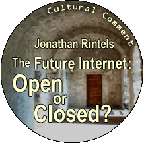
Open or Closed?
"Many in America's creative community have assumed that the rapidly approaching Internet of tomorrow -- high-speed, low-cost, and utterly pervasive -- will empower media creators to directly reach their audience, eliminating the corporate middleman distributor...
That hoped-for panacea of seemingly unlimited creative power and freedom on the future Internet may never come to pass as a result of the Supreme Court's June 2005 decision in the Brand X case. Despite its underwhelming name, according to Andrew Jay Schwartzman of the Media Access Project, a public interest law firm specializing in media issues, Brand X "will, quite literally, determine the future of the Internet as we know it." It is nothing less than the opening shot in what promises to be an ongoing war between media goliaths and independent entrepreneurs, including creative media artists, over whether the future Internet will be "open" or "closed." What's at stake is whether a consumer will retain the freedom to access any website, as is the case today, or whether he/she will be restricted to visiting sites approved by – or in business with -- the "gatekeeper" providing his/her high speed Internet access..." From The Future Internet: Open or Closed? by Jonathan Rintels, Cultural Commons, August 2005.
Posted by jo at 01:32 PM | Comments (0)
StarChild + FlatWorld

Data Sonification
Data sonification has been viewed as a tool with great potential for studying complex sets of scientific data. Sonification can provide the researcher with the ability to perceive variations and trends that are invisible to more established data analysis techniques. However, few have explored the potential artistic applications of sonification. In 1996, Jarrell Pair worked with Alec Robinson to se Matlab and Csound to prototype software to transduce data from various sources such as images, temperature, and light intensity into aesthetically pleasing audio. We used this work to develop the audio effects for StarChild. Using Csound and a custom C program, astronomical data from the Shoemaker Levy-9 comet collision was used as input to create audio for portions of StarChild. Additionally, images of the collisions with Jupiter were transduced into audio effects using Hyperupic, an application running on a NeXT computer. 440k MP3 file (low sample rate) taken from the sample files created from the comet collision.
From July 1995 through June 1996, Pair was extensively involved in the technical development of StarChild, a multimedia opera. The opera was composed and produced by Audio Research Team director, James Oliverio. Alec Robinson and Pair created sound effects for the opera using data sonification methods we had developed as part of an ongoing team project. He was also involved in the installation, testing and evaluation of the eight channel audio steering system used in the opera.
The StarChild production team included visual futurist Syd Mead (designer for the films Blade Runner, Aliens, Tron, and Star Trek: The Motion Picture ), the internationally recognized lighting designer Lloyd Sobel, animator Steve Walker, and scientists and engineers from across the Georgia Tech Campus. Students met and worked with the guest artists in workshops, lectures, and in the production of the opera itself. An internet MBone broadcast of StarChild took place on June 5th, 1996. Two live performances followed on June 6th and 7th.

FlatWorld: The Mixed Reality Simulation Space
Since 2001, Pair has overseen the design and development of the FlatWorld project at the University of Southern California's Institute for Creative Technologies (ICT).
FlatWorld is a mixed reality simulation environment merging cinematic stagecraft techniques with immersive media technology. Current virtual environments have severe limitations that have restricted their use. For example, users are often required to wear bulky head mounted displays that restrict a person’s freedom to physically move as they would in the real world. Furthermore, a person cannot touch or feel objects in the virtual world.
This project addresses these issues by developing an approach to virtual reality simulation which allows individuals to walk and run freely among simulated rooms, buildings, and streets.
Posted by jo at 10:33 AM | Comments (0)
Haque Design + Research:
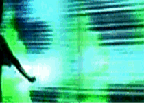
Haunt: Call For Participation
Haque Design + Research is collaborating with Professor Chris French, Goldsmiths College on Haunt. We are about to enter the testing phase of a project to synthesise the experience of a "haunted" space. We are now looking for people interested in participating in the experiment at a venue in North London. By appointment only: Dates: Weekdays, August 29 to mid-September (may be extended); Place: 1 minute walk from Finsbury Park tube station, London N4; Time: Any time between 10am and 6pm.
As a participant you would be asked individually to spend up to one hour in the specially constructed chamber. Participation may involve periods of exposure to infrasound and/or magnetic fields. You may experience mildly unusual sensations and will be asked to keep a record of these.
"Infrasound" is sound at frequencies below approx. 20Hz, which is generally too low for humans to perceive as sound. The magnetic fields will be generated by electromagnetic coils and will be similar to those generated naturally by the Earth. The levels used in the experiment will be at or below levels detected in the natural environment. These too will generally not be perceptible on a
conscious level and are well under ICNIRP guidelines for health and safety.
In some cases, participants will be exposed to neither phenomena, though these participants will not be informed of this until the end of the experiment. In these cases, participants will be given an opportunity to experience the space with all phenomena active, though the results will not be included in the dataset.
If you are interested in participating please let me know by emailing me at (event[at]haque.co.uk) with:
Your name:
Your availability: Day / Date / Time
Any family history of epilepsy?:
I will respond to confirm or suggest an alternative date/time and will include full address and directions for the experiment site.
If you choose to participate, please be aware that you may withdraw from the study at any time and for any reason without being required to provide an explanation. Data will be held securely and in the strictest of confidence. In the final report the results will be presented in such a way that the individual identity of all participants will remain strictly anonymous.
Thank you!
Usman Haque
Posted by jo at 09:21 AM | Comments (0)
Beyond the Disciplines:

Art without Borders
"In Western culture, artists aren't encouraged to be integral to the social, environmental, or spiritual life of the community. They do not train to engage with real-life problems. Instead they learn to be competitive with their products in the marketplace. All our institutions are defined by this market ideology—none have escaped. "Professional recognition" in the form of brisk sales and positive reviews still remains the primary pattern of thought that structures the internal rhythms of art-making. For a long time now, I have been questioning these premises; anyone who has ever read anything I have written will know that my books are meant as a challenge to our reigning paradigms of economic control and domination. They seek to expose the coercive propaganda of capitalism as a form of spiritual and ecological suicide—and they look at the Big Picture, always with a view to recovering from the estrangements of Western civilization. Instead of art-as-commodity, deprived of any useful social role, I believe that art can help us to participate in what geologian Thomas Berry deems the "great work" of our time: moving from a devastating presence on the planet to a more benign presence.
For most of my lifetime, there has been a rigid, dualistic separation between aesthetics and ethics--just as there has been a split between subject and object, and between art and life. In the same way that science aggressively rejects religion, modern aesthetics has rejected ethics, as if the truths of the two realms were somehow mutually exclusive and had little in common. Few people are willing to talk about ethics and aesthetics in the same breath." From Beyond the Disciplines: Art without Borders by Suzi Gablik.
Posted by jo at 08:46 AM | Comments (0)
Radio_Copernicus@Warsaw_Autumn 2005

World Premiere + Open Studio
Radio_Copernicus@Warsaw_Autumn 2005: After the prelude in Stralsund Radio_Copernicus - the German-Polish Artist Radio- is broadcasting for another month in co-operation with Warsaw Autumn 2005, the 48th International Festival of Contemporary Music: September 01-30, 2005 live-stream; September 16-30, 2005 on air: Warsaw FM 92.4.
With its ambitious programme Radio_Copernicus creates a broad discourse and context regarding Warsaw Autumn 2005 - to focus on innovative media concepts and art and culture of the electronic age. Besides regular reports and discussions on Warsaw Autumn the broadcast of Radio_Copernicus-commissioned works is a highlight of the programme: six up-and-coming artists are invited for the world premiere of their productions - Duo Merzouga, Anne Koenig, Michal Jacaszek, Emiter/Aszyn, Group Two, Underwater Agents. Almost daily from 10 pm to midnight Radio_Copernicus - broadcast-studio in Warsaw will be committed completely - as an "Open Studio" - to the artists and their visions of radio.
Further on-air stations of Radio_Copernicus:
Dis_Positionen, Academy of the Arts, Berlin - November 2005
International Radio Art Symposium, Wroclaw - December 2005
Radio_Copernicus is broadcasting permanently and world-wide as an
Internet-live-steam until 31 December 2005 on www.radio copernicus.org.
Further information can be found in Polish, German and English here:
Studio Radio_Copernicus
University of the Arts Berlin
Postfach 120544
D-10595 Berlin
Tel. +49 30 3185-2482
Fax +49 30 3185-2530
Email info@radio-copernicus.org
http://www.radio-copernicus.org
Posted by jo at 07:33 AM | Comments (0)
August 24, 2005
Immersive 3D TV
Watch, Sniff and Feel the Big Game
Almost 77 years after the first demo of stereo TV in 1928 by John Baird, there's evidence of a strong resurgence of interest and research in immersive TV:
"The Japanese Government is quietly throwing huge financial and technical weight into the development of three-dimensional,virtual reality television",reports the Times.It "has obtained an interim report from the Communications Ministry’s "Universal Communications" study group detailing the work in progress.Three-dimensional images apart,the ministry wants to develop the ability to send thousands of different odours through the new television to enhance the sense of reality.Its plans also call for the "recreation of tactile sensations",a hitherto elusive concept that would give viewers the ability to reach out and "feel" what they were seeing.Current projects are working on electrical stimulation for the fingers, ultrasound and air pressure." From The Times Online (via smartmobs) [blogged by sfisher on USC Interactive Media]
Posted by jo at 11:26 AM | Comments (0)
Foo Camp, Bar Camp: smartmobbing ftf meetings

Smart Mobs and the Power of the Mobile Many, Technologies of Cooperation
Open Space Technology is a simple methodology for enabling people to create their own agendas at meetings and conferences. Tim O'Reilly created a version of an open-space conference for invited participants, Foo Camp, and Ross Mayfield describes an open-to-all event, Bar Camp. Combining wikis with Open Space methods is an increasingly popular way to smartmob face-to-face gatherings:
When someone walked in the door, 300 people perhaps in total, over 100 at peak, usually Kit would be there to guide them. People insisted on handing out cash and it would make it's way to the guy with the PayPal account (Chris). A collective sense of who was doing what was achieved before the event in a lively IRC channel (remember Happenings?). If you had an idea, like a sponsored sub-party, it could simply get done.
BarCamp EntranceBarCamp happened where it did because of location awareness. About a week before, after we moved into the neighborhood, I met the Flock guys (knew Termie only through time based media) through Plazes. We chatted a bit. Then I got pinged with this crazy ass idea asking if I had suggestions for space and bandwidth. A wiki was thrown up, the rest is increasingly well recorded history. [Posted by Howard on Smart Mobs]
Posted by jo at 10:59 AM | Comments (0)
Node Explorer

It Knows Where You Are
"This tiny electronic prototype, called an Node Explorer, detects exactly where I’m standing within the 850-acre parkland surrounding Ashton Court, because it’s equipped with an internal Global Positioning System (GPS) based on satellite signals, accurate to within about three yards.
On screen, I see myself as a little red dot moving slowly over the grass. Depending on where I wander, an entirely different heritage or cultural story is presented through a combination of pictures, sound effects and narrative, all related to where I’m standing and what I’m looking at.
I walk to the bottom of the lawn. Ping! With the sweeping façade of Ashton Court spread like a film set, the screen shows me how the building has changed over the centuries, images building upon images as a voiceover explains why the place looks as it does now.
The tone of the script is light, brief but serious - a cross between Radios 2 and 4. (Later, I discover that the material has been written by an ex-BBC producer and narrated by a local radio presenter.)
I move 50 feet towards some flowerbeds and… ping! I’m urged to look up at the fourth window from the left where the 19th-century stunner Emily Smythe - “the most beautiful woman in the West of England!” - once gazed from her bedroom at the rural landscape stretching to the city. The screen shows me her picture. It tells me that men used to swoon at the sight of her. It shows me her bedroom. I walk to the front of the building. Ping! I learn that the writer CS Lewis was a patient here during the First World War, when this became a military hospital." [via It knows where you are... and pasta and vinegar]
Posted by jo at 10:36 AM | Comments (0)
Appendix2
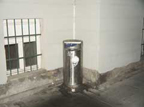
Activated by Passers-by
Appendix2--by Tanja Vujinovic and Zvonka Simcic--features an alternative state of urban landscape. The multimedia exhibition consists of short video works and interactive, computer based works displayed in the Kresija Gallery (Ljubljana, Slovenia) and interventions in the soundscape of the center of Ljubljana.
Small scale mechanisms (automata), made of sensors react to movement and small broadcasting units are hidden at several locations in the center of the city. Sounds are activated by passers-by and intervene into the structure of the town soundscape.
The sensors are attached to the garbage bins and passers-by are then blessed with sounds of Chinese market and rickshaw drivers, laundry machine and parody ads for perfume. Well, I should write "the sensors WERE atached" as they've just been stolen. Fortunately, the rest of the exhibition is still up and running till August 28. [blogged by Regine on we-make-money-not]
Posted by jo at 10:30 AM | Comments (0)
Career Moves
Players Can Create Their Own Semantic Systems
Career Moves--by Mary Flanagan--explores the contradictory world of women in corporate America through an interactive, computer controlled board game. Work is a troubling condition internationally for all women. Women represent 50 per cent of the world adult population and one-third of the official labour force, but they perform nearly two-thirds of all work hours, receive one-tenth of the world income and own less than 1 per cent of the world's property...
This commercial style is intended as a critique of the historical sequence to which the popular board game belongs: many games have traditionally supported social "norms," including heterosexuality, consumerism, and especially non-liberatory positions for women. However, as players progress down the board, it becomes clear that it is they themselves who are determining the rules of the game, and the collective and individual goals become apparent...
To participate in Day of the Figurines, the player must first visit a physical place. Here, they find a large scale model of an imaginary town at table height. The model is 1:100 and extends for several metres in all directions. The image is a mix of computer graphics and photographic collage.
The town has identifiable buildings such as the YMCA, the Big Chef, Video Zone, the XXX Cinema and the Battle of Trafalgar Square. There are other features such as a Cemetery, a Gasometer, a canal, a Level Crossing and an Underpass.
To play the game the visitor selects from a display of one hundred plastic figurines. They give the figurine a name, answer a few questions about him or her and then watch as she or he is placed at a random location into the model town. As they leave the space the player is given a small map of the town and a set of rules for the game.
An hour or so later the player will receive their first text message from the game, asking where their figurine would like to go. By replying to the message with the name of a place in the town the player’s figurine is set on the path towards that destination. Each hour a turn is executed and the invigilator moves each figure a small distance towards their destination. There are 10 turns a day for 24 days.
Intermittently each player receives text messages to alert them to nearby figurines in the model city, to their figurine’s arrival at a destination or to other events in the town. Each destination has a short description. For example, if you arrive at the The One Club you receive the SMS: “Home of the 2 Fs. The lock ins are legendary, the fire escape stairs have seen it all.” The goal of the game is “to help others”. Texting messages to other players may provide opportunities to do this.
The project is deliberately targeting low-end phones: it is playable on any phone that is able to receive SMS. Instead the technological focus is on orchestration and management tools. During the long-term test period, 8 players have been given phones that log Cell ID and upload this information to a server. We aim to use this data to assess when players are engaged, when they are most likely to play and how the game fits into their daily activity pattern. We will also carry out phone interviews with selected players at key moments, to study the interaction between game play and daily life.
Posted by jo at 10:12 AM | Comments (0)
Schema
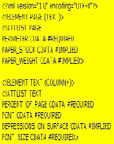
Instructions + Thought Experiments Made Tangible, Now Machine-Readable
XML Translation of Dan Graham's "Schema" by matt_butler: In 1966 conceptual artist Dan Graham composed a language-based work entitled Schema. The artwork consisted of a formal procedure for how to describe a document, or a "set of pages," with no real reference to the content of that document. This schema, as he called it, shares a remarkable similarity with XML, invented over 30 years later.
The conceptual artists of the late 1960's and early 1970's were interested in the nonvisual abstraction of art and how artworks might be represented as information. Using language in a non-literary and non-poetic manner, they sought to continue the tradition of visual artists in a search for abstraction and minimalism. Many conceptual works of this time were simply words on paper, instructions, or thought experiments. Schema allowed the viewer to be aware of the material nature and structure of the document they were holding — as well as any document they might hold. Using XML, I have created a machine-readable translation of his 1966 work. Schema was originally published in issue 5+6 of Aspen magazine. It is now being archived at UbuWeb.
Biography:
m.f.a. university of iowa (intermedia art). ph.d omega university (unaccredited parapsychology). maybe logic academy (robert anton wilson instructor).
matt is currently employed at the iowa city public library where he produces television programs for the library channel. he also teaches digital art at coe college in cedar rapids, ia.
matt has participated in a variety of art and technology events including versionfest at the m.c.a. chicago. his published books can be found at printed matter, inc. new york. [via Rhizome]
Posted by jo at 09:52 AM | Comments (0)
160 Characters
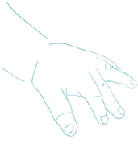
U Pt Yr Rt Ft In...
"How did you learn your first rhyming games? From other kids, right? As children we entertained ourselves by combining words, rhythm, and rhyme. Now we're big kids with grown-up toys, and Anita Bacic has built a new playground for us. 160 Characters is an exhibition of nursery rhymes, songs, and games gathered from all over the world, via mobile phones. People can contribute to her archive by text messaging lyrics and stanzas to a centralized phone number. The collected messages will form part of a multimedia installation, with a selection chosen for viewing with a retro slide viewer. Contemporary text messaging abbreviations and multi-lingual submissions are encouraged, thus opening the lid on a whole new toybox of ideas for those linguists and cultural studies buffs who like to play with notions of digital storytelling in the global village, the hybridization of culture through technology, or the role of mobile communication in creating new diasporas. So come on out and play--after all, isn't the 'Hokey Pokey' really what it's all about?" - Peggy MacKinnon, Net Art News, August 24, 2005, Rhizome.
Posted by jo at 09:27 AM | Comments (0)
August 23, 2005
[-empyre-] clothing [and/as] technology

Clothing as Interface
From: Empyre/Felix Sattler
Sent: Sunday, August 21, 2005 8:24 PM
Subject: [-empyre-] clothing [and/as] technology
hi Heidi, Katherine Moriwaki, Floyd & empyreans,
just a few quick and maybe too loosely connected thoughts on wearables, clothing and technology. at the same time as the whole debate about the fusion of clothing with technology (high fashion colliding with high technology, etc...) is fascinating, it unfortunately is likely to cover its own cultural history.
in the past, clothing had not been enhanced by [digital] technology but itself had been rather synonymous with technology. together with the development of language the use of materials to cover the human body (i.e. the naked animal life) had been the primary cultural operation by which man (indeed physically) established a border between himself and the animal world, hence becoming human at all.
interestingly enough, the german word for this "border" between the naked body and the environment "grenzflaeche" (grenze=border, flaeche=surface) translates as "interface" in english, which makes the quality of clothing-as-technology quite apparent.
from this point of view, it becomes obvious that clothing/wearables fulfill several cultural tasks at the same time which even seemingly contradict each other. their function as a cover/shield/border for/of the human body "seamlessly" interacts with the one as a means of communicating/ exposing the body to the outside world. fashion has largely understood this ambivalence (being the original concept of an interface) for a long time and basically works on this principle.
the idea that wearable technology is something that is rather hidden while at the same time used to communicate with the outside world is therefore found at the beginning of the development of wearable computers. claude shannon and ed thorpe developed the first wearable computer in 1961-66 in order to "predict" roulette wheels, i.e. cheat casinos in las vegas. the computer (that was later famously labelled the "eudaemonic shoe computer" after the group of MIT-students called the "eudaemonics") was a small device hidden in the sole of a shoe. it was controlled by the movement of the toes and its feedback consisted of acoustic information via an almost invisible headphone connection.
anyway, before going too much into technical detail (i'm always trying to avoid that, but you can check out the links below for more info) i'd rather stop here.
i guess when we are dealing with wearable computer technology and especially with those that is able to establish [physical] connections between users we should be aware that clothing is way more than just a second skin (in fact it is (culturally) entirely different from skin and never a mere skin-extension). performing/transmitting data/language/touch/etc... through clothing as an interface therefore should imply a sense for the cultural function clothing inherits from the past.
best
felix
links to the history of wearable computing/MIT-shoe comp:
http://en.wikipedia.org/wiki/Wearable_computer
http://www.media.mit.edu/wearables/lizzy/timeline.html#1966a
http://wearcam.org/historical/node2.html
http://physics.ucsc.edu/people/eudaemons/layout.html
http://www.eyetap.org/wearcam/eudaemonic/
Felix Sattler Research Project: *Mapping the Casino - A Curatorial Adventure Into The Postindustrial Paradigmatic* Faculty of Media Bauhaus University Weimar Ernst-Kohl-Str. 2 D-99423 Weimar Germany phone: +49-3643-815968 mobile: +49-160-4155881
Posted by jo at 05:04 PM | Comments (0)
Trans Siberian Radio

Mobile Lab for On-Air Experimentation
Trans-Siberian Radio is a low-power FM station that will operate on the train from Moscow to Beijing via Novosibirsk, during the conference Capturing the Moving Mind: Management and Movement in the Age of Temporary War, September 11–20.
The station will be a mobile lab for on-air experimentation, featuring music and ideas created collaboratively by passengers on the train and accessible to everyone along the Trans-Siberian route. As curator Natilee Harren writes, the ever-moving symbol of the train fits the conference's theme: "The spirit of the conference is to cross fixed boundaries and to create an environment that is open to the 'contaminating influences' of the communities through which the train will pass. In fact, the point of having the conference on a train is to escape any restrictions relating to a particular time or place." Visit the project's site when the train is rolling to contribute with audio works or hear—and manipulate—audio clips from the ride. [blogged by Regine on we-make-money-not]
Related: "Last year, artists Jennifer Allora and Guillermo Calzadilla used micro-radio transmitters to create a re-volt. That is, by helping community members build nearly 500 micro-radio transmitters, they initiated a process by which power was redirected from the corporations who most profit from the publicly owned airwaves to individuals who can express a diversity of commercial-free viewpoints. Their project Radio Re-volt , created during a residency at the Walker Art Center, culminated in October with a narrowcast the length of University Avenue in Minneapolis. More than 50 micro-radio stations aired from homes and businesses along the route for the benefit of their neighbors or anyone driving the avenue with their radio on." ...More on Radio Re-volt at WiredNews. Click here to read an interview I did with Allora and Calzadilla last spring. [posted by Paul Schmelzer on Eyeteeth: A journal of incisive ideas]
Posted by jo at 10:35 AM | Comments (0)
Mobile Journeys
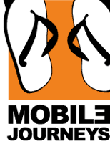
Exploring the Creative Potential of Mobile Devices
Mobile Journeys is a national arts initiative dedicated to exploring the creative potential of mobile devices and to fostering the development of Australian mobile culture. Works include games, video, social networks, interactive installations, Bluetooth and infrared. Learn more about your phone and the creativity it’s capable of. Games + Social Networks + Video + Wallpapers + Contribute + Works by artists.
Mobile Journeys is a national consortium of partners dLux media arts, ANAT, and AIMIA, and is proudly supported by Samsung Mobile.
Posted by jo at 10:18 AM | Comments (0)
GilbertandGrape
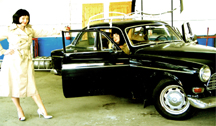
By the Way
In their performance By the Way GilbertandGrape park their Volvo Amazon alongside café’s, galleries and car parks, put up a fake sunset and place a stuffed moose in front. They invite people into the car to choose a nostalgic song to listen too whilst watching the fake sun set. They make a fictional frame from a cliche and within this generate texts and exchange information together with the audience. GilbertandGrape re-present the cliché elg I solnedgang (moose in sunset) and ask what kind of relation do we have to it in contemporary rhetoric?
26 August: Talk Blog as public space. Introduction to performance By the Way; Kl 19:00 Atelier Nord, Oslo, Lakkegate 55 D. www.anart.no
27 August: Performance By the way in collaboration with Atelier Nord. KL 20:00-22:00. Kuba Pavilion, Fyrhuset ved Maridalsveien 19.Oslo
29 August: Talk Networks for performance artists/Introduction to Taoh residency in Stavanger. Video Lone Ranging Romance. UKS Oslo, Kl 19:00 Lakkegata 55 C.
02-03 September: Performance By the way at Kunstbanken Hamar, performance weekend, Hedmark, Kl 14:00-16:00, KUNSTBANKEN - Hedmark Kunst senter - Parkgt. 21, Hamar.
Posted by jo at 09:28 AM | Comments (0)
August 22, 2005
KISSS
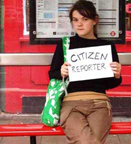
KISSS Project launch and Press Conference
August 25, 2005, 6-8pm
The Auditorium
Whitechapel Gallery, London, UK
80 - 82 Whitechapel High Street
London, E1 7QX
+44 (0)20 7522 7888
Admission Free
This KISSS: Kinship International Strategy on Surveillance and Suppression event will feature a series of performances, video screenings and presentations from Coco Fusco, Anne Bean, Deej Fabyc, Joanna Callaghan, Paula Roush, Raresonick, Camilla Brueton, Season Butler and Maxine Hall. Due to high demand bookings are advisable: kisss[at]elastic.org.uk. Related.
Posted by jo at 04:38 PM | Comments (0)
Ambient Computing and the Disappearing Computer
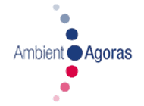
Dynamic Information Clouds in a Hybrid World
"ABSTRACT: There are three parts of my presentation. It starts with a review of (a) previously developed concept of cooperative buildings and Roomware® components as a new approach for designing the work environments of the future and its first example i-LAND. This is followed by presenting the EU-funded proactive intiative "The Disappearing Computer" (DC), a cluster of 17 related projects designing new people-friendly environments in which the "computer-as-we-know-it" has no role. Finally, a specific example of DC-intiative is presented, the project "Ambient Agoras: Dynamic Information Clouds in a Hybrid World." Here, we move beyond the more productivity-oriented support as, e.g., in i-LAND to a more experience oriented approach communicating atmospheres of social architectural spaces. Ambient Agoras aims at transforming places into social marketplaces ('agoras') of ideas and information, providing situated services, and feeling of the place ('genius loci') via a combination of ambient displays and mobile devices." From Ambient Computing and the Disappearing Computer by Norbert A. Streitz.
Posted by jo at 11:16 AM | Comments (0)
MobZombies
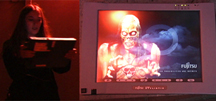
Mixed Horror
MobZombies is a zombie-fleeing game where a player's movement controls an avatar in the game space. Players run away from virtual zombies by really running. You have to stay alive as a horde of the undead slowly moves towards you. The longer you survive, the more zombies appear and the better they get at following you.
Just because there are no obstacles in the virtual world doesn't mean that there aren't obstacles in the real world. Imagine running away from a zombie and realizing that the only way you can continue to evade it is by somehow negotiating a brick wall in the physical space or running through the football practice field during a scrimmage.
MobZombies is inspired by mobile games such as Botfighers or Mogi, where the player's movement in the physical world correlates to the game space. Because we carry mobile devices with us everywhere, it becomes fun to think about a version of MobZombies that kicks in at random times during the day, forcing you to stop whatever you were doing and try as hard as you can to avoid the undead.
Developed at at USC Interactive Media Division by William Carter, Todd Furmanski, Kurt MacDonald and Tripp Millican. [blogged by Regine on we-make-money-not] [Related]
Posted by jo at 09:20 AM | Comments (0)
Masaki Fujihata
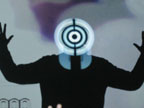
Innovative Public-Led Expedition
bodydataspace (b>d>s) have created a Multi-Media Design Studio with 3-D Exhibition Space for the newly renovated Jaywick Martello Tower. The premiere exhibition for the inaugural opening will be Mersea Circles by Masaki Fujihata. It is a 3-D interactive installation that emerged from an innovative public-led documentation process in August 2003. Taking place on Mersea Island, just off the Essex coast, some 150 people participated all using DV cameras and GPS. As they explored the terrain and its people they captured, with position data, their discoveries and experiences of the landscape, talks and interviews. From the myriad of data gathered, internationally renowned artist, Masaki Fujihata created his latest work.
In addition to the above exhibition, the event on Saturday, 17th September will include a live performance of Soft Ices by artist Mark Storor and composer Jules Maxwell at 3pm. There will also be a site-specific exhibition from the photographer John Kippin.
[b>d>s] is a design unit that delivers artist-led projects into architectural applications and uses interactive technologies to enable people to learn, develop and extend within intelligent data spaces, ultimately enabling the public to have a direct impact on the content of the space they inhabit. It combines the specialist knowledge and creative direction of its founders Ghislaine Boddington (body technology artist) and Armand Terruli (architect/video artist) in a unique collaboration that explores the artistic and technical opportunities present in the fusion of body, data, and space.
Masaki Fujihata / Mersea Circles / COAST: Masaki Fujihata is one of nine artists who have produced artworks for COAST, Essex County County’s ambitious art project celebrating the Essex coast. Mersea Circles is housed permanently at the Jaywick Martello Tower as well as the Ars Electronica Museum in Linz.
Saturday, 17th September 2005
12.30-3pm (invite only)
3-6pm (open to public)
Jaywick Martello Tower, Jaywick,
Clacton-On-Sea, Essex CO15 2LF
Entrance is FREE
Jaywick Martello Tower is the latest digital arts venue to open in the UK and one of the most unusual. This heritage project has transformed the Napoleonic tower’s first floor into a state-of-the-art environment where b>d>s have created a multi-media studio for exhibitions, events and workshops. It includes a floor to ceiling curved projection screen for immersive three-dimensional and audio-visual installations. This unique tower will act as a national resource for commissioning and presenting digital art from regional, national and well-known international artists.
The venue is the accomplished result of a 3-year collaborative venture between Essex Council, Bishops Park College and bodydataspace bringing together the arts, community and education. The Jaywick Martello Tower is managed by Bishops Park College, one of the brand new pioneering schools built under the Labour Government.
DIGITAL ARTS VENUE OPENS
Saturday, 17th September 2005
12.30-3pm (invite only)
3-6pm (open to public)
Jaywick Martello Tower, Jaywick,
Clacton-On-Sea, Essex CO15 2LF
bodydataspace (b>d>s) have created a Multi-Media Design Studio with 3-D Exhibition Space for the newly renovated Jaywick Martello Tower, featuring the work of international Japanese artist Masaki Fujihata.
Jaywick Martello Tower is the latest digital arts venue to open in the UK and one of the most unusual. This heritage project has transformed the Napoleonic tower’s first floor into a state-of-the-art environment where b>d>s have created a multi-media studio for exhibitions, events and workshops. It includes a floor to ceiling curved projection screen for immersive three-dimensional and audio-visual installations. This unique tower will act as a national resource for commissioning and presenting digital art from regional, national and well-known international artists.
The venue is the accomplished result of a 3-year collaborative venture between Essex Council, Bishops Park College and bodydataspace bringing together the arts, community and education. The Jaywick Martello Tower is managed by Bishops Park College, one of the brand new pioneering schools built under the Labour Government.
The premiere exhibition for the inaugural opening will be Mersea Circles by Masaki Fujihata. It is a 3-D interactive installation that emerged from an innovative public-led documentation process in August 2003. Taking place on Mersea Island, just off the Essex coast, some 150 people participated all using DV cameras and GPS. As they explored the terrain and its people they captured, with position data, their discoveries and experiences of the landscape, talks and interviews. From the myriad of data gathered, internationally renowned artist, Masaki Fujihata created his latest work.
In addition to the above exhibition, the event on Saturday, 17th September will include a live performance of Soft Ices by artist Mark Storor and composer Jules Maxwell at 3pm. There will also be a site-specific exhibition from the photographer John Kippin.
Entrance is FREE.
For b>d>s Press Invites, additional INFO and IMAGES contact Jamie McLaren:
Tel: 07949 111 871 or 020 7357 0823 / Email: jamie@bodydataspace.net
Partners of the renovation project include Essex County Council, the Heritage Lottery Fund, European Union through the Intereg IIIB programme, English Heritage, the Essex Rural Renaissance Fund, Essex Environment Trust, Park Resorts, EEDA and Tendering District Council.
NOTES TO EDITORS:
bodydataspace
b>d>s is a design unit that delivers artist-led projects into architectural applications and uses interactive technologies to enable people to learn, develop and extend within intelligent data spaces, ultimately enabling the public to have a direct impact on the content of the space they inhabit.
b>d>s combines the specialist knowledge and creative direction of its founders Ghislaine Boddington (body technology artist) and Armand Terruli (architect / video artist) in a unique collaboration that explores the artistic and technical opportunities present in the fusion of body, data, and space.
Masaki Fujihata / Mersea Circles / COAST
Masaki Fujihata is one of nine artists who have produced artworks for ‘COAST’, Essex County County’s ambitious art project celebrating the Essex coast. To find out more about the COAST project go to http://www.coastart.org
Mersea Circles is housed permanently at the Jaywick Martello Tower as well as the Ars Electronica Museum in Linz.
Managed by the local secondary school, Bishops Park College, it is planned that the Jaywick Martello Tower will be a catalyst for change, developing digital vocational skills. It will provide inspiration for the local community and attract interest and visitors from around the country and overseas to this unique location.
The site provides public access during the summer for environmental and historical groups, schools, tourists, walkers and visitors from overseas.
A permanent on the ground floor for a series of specially-commissioned permanent artworks by artist John Kippin on the theme of Essex coastal landscapes and the history of its military installations, linked with sites abroad.
A base for community arts projects with links to local schools.
Observation facilities on the on the roof, including a purpose-built look-out station, to be used by the National Coastwatch Institute (NCI). Visitors will also be able to use this facility.
The National Coastwatch Institute is a charity run by volunteers (principally retired people), who provide a visual watch to back up HM Coastguard.
European Interreg is a trans-European body which supports and finances international cross-border projects to achieve balanced regional development.
For information on the centre including the performance event Soft Ices and the work of John Kippin, contact: Keith Watson, Digital Arts Development Officer (c/o Bishops Park College):
Tel: 07802 748 484 / Email: mailto:keith@deluxe-arts.org.uk
Bishops Park College is not so much a school in the community but the community in a school with public library, family support day centre, cyber café, early year’s office and a purpose built neighbourhood nursery. The idea of community was a guiding principle in the overall design of the school, funded by the Private Finance Initiative.
The Head Teacher is Mike Davies.
LINK to Guardian Unlimited Feature on Bishops Park College: http://education.guardian.co.uk/egweekly/story/0,5500,1510479,00.html
Posted by jo at 09:14 AM | Comments (0)
Asterisk*: Artists Residencies

The Centre for the Study and Development of Narrative
Asterisk*, (the centre for the study and development of narrative) is based at Shandy Hall in North Yorkshire where Laurence Sterne wrote The Life and Opinions of Tristram Shandy, Gentleman. It is a concept developed by The Laurence Sterne Trust that aims to use the spirit and intellectual resources of Shandy Hall to inspire artists and the public to explore and experiment with nonlinearity, and to examine and develop the convergences between art forms within our contemporary culture. It aims also to illustrate how new technology can, in the hands of artists, be used to deliver entirely new artistic opportunities. In the autumn and winter of 2005, Asterisk* will offer two residencies of three weeks duration each. These will provide exceptional opportunities for artists keen to experiment with current practice in diverse media, specifically exercises in non-linearity, with an emphasis on interactivity and audience participation. Intersections with technology are encouraged and technology specialists will be available for collaboration. Deadline Friday 26 August.
Posted by jo at 07:24 AM | Comments (0)
August 21, 2005
The Ministry of Reshelving
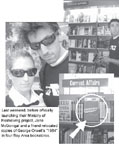
Secretly Reshelving 1,984 Copies of 1984
Last week, Danah Boyd blogged about the Reshelving Project. In today's Boston Globe, the project was reviewed in The Ministry of Reshelving by Joshua Glenn.
"EARLIER THIS SUMMER, Jane McGonigal and three dinner companions were chatting about doublespeak, censorship, and surveillance when someone idly commented that George Orwell's dystopian novel ''1984" should be reclassified as Non-Fiction, or even filed under Current Events. ''Five seconds later, I said, 'Wait--we could actually do that,"' recounts McGonigal. So last Monday she took the lead in launching the Ministry of Reshelving project, an ambitious, opt-in performance piece whose goal it is to secretly reshelve 1,984 copies of Orwell's book in bookstores in all 50 states.
Though such an undertaking sounds daunting, it's child's play for McGonigal, a doctoral candidate in performance studies at UC-Berkeley who earns a living working as a designer and ''puppetmaster" for 42 Entertainment, an Emeryville, Calif.-based outfit that creates elaborate ''alternate reality games"--played by thousands via chatroom, cell phone, e-mail, even billboards and want ads--in order to drum up excitement for various new products.
But McGonigal's true passion, she said via e-mail from San Francisco, is ''making games that give people a platform for changing social norms and public policy." As of this writing, she reports, some 55 ''ministers"--from California, New York, Idaho, Kentucky, Wisconsin, North Carolina, and a half dozen other states--have relocated over 100 copies of ''1984." Evidence of these hijinks is being posted around the clock to the photo-sharing website Flickr (flickr.com/groups/reshelving).
Is Boston behind the curve? By no means! On Thursday morning, McGonigal said, a Bostonian ''minister" informed her that a copy of ''1984" had just been moved from the Fiction section of the Borders in Downtown Crossing to the Political Science section, where it was reshelved next to a book titled ''Inside the Mind of Bush."
How to Serve the Ministry of Reshelving
1. Select a local bookstore to carry out your reshelving activities.
2. Download and print "This book has been relocated by the Ministry of Reshelving" bookmarks and "All copies of 1984 have been relocated" notecards to take with you to the bookstore. Or make your own. We recommend bringing a notecard and 5-10 bookmarks to each store.
3. Go to the bookstore and locate its copies of George Orwell's 1984. Unless the Ministry of Reshelving has already visited this bookstore, it is probably currently incorrectly classified as "Fiction" or "Literature."
4. Discreetly move all copies of 1984 to a more suitable section, such as "Current Events", "Politics", "History", "True Crime", or "New Non-Fiction."
5. Insert a Ministry of Reshelving bookmark into each copy of any book you have moved. Leave a notecard in the empty space the books once occupied.
6. If you spot other incorrectly classified books, feel free to relocate them.
7. Please report all reshelving efforts to the Ministry. Email your store name, location, # of 1984 copies reshelved, and any other reshelving activities conducted, to reshelving @ avantgame.com. Photos of your mission can be uploaded to Flickr, tagged as "reshelving", and submitted to the Ministry of Reshelving group.
Posted by jo at 12:09 PM | Comments (0)
August 19, 2005
Embrace
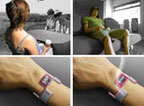
Seamlessly Connected
Embrace--by Lisa Thomas and Jonathan Fitch--is a concept bracelet that enables the user to be seamlessly connected to their significant other over periods of separation. It consists of five nodes: an LCD screen displaying images sent via Bluetooth; battery; technical components that fuel this device; a camera lens that constantly records images until the user specifically shoots an image by gently grasping each side of the lens node, which uses "touch sensitive" technology; and a scent palette that emits one of five odors chosen by the owner of the device indicating an incoming image from their significant other.
For example, when you receive the scent of pina-coloda, others may be able to smell it as well, but only you will really know why it smells like pina-coloda. The shape of Embrace allows the bracelets to unite with one another. Related: Fragrance delivery brooch set, Digital fragrances. [blogged by Regine on we-make-money-not]
Posted by jo at 10:51 AM | Comments (0)
UpStage
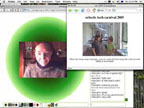
Cyberformance Bug Party
hi everyone,
we're having an UpStage bug party on sunday 21 august. 11am western europe time, 9pm new zealand - find your local time here.
we'll use the introduction stage as our starting and meeting place, and the aim of the party - apart from having a good time - is to identify and prioritise bugs, and hopefully allocate some to people who can work on them.
if you want to join us, email helen varley jamieson: helen[at]creative-catalyst.com; creative catalyst .
This year, the Eclectic Tech Carnival took place from 11-15 July in Graz, Austria. During the festival, UpStage workshops were taught remotely by Helen Varley Jamieson in New Zealand. Participants created their own avatars and backdrops, and improvised a short cyberformance.
A theme of the festival was open source chat and streaming video. In the screen grab at top left, Helen's web cam appears in UpStage with an overlay of the live web cam feed from Graz.
Posted by jo at 10:35 AM | Comments (0)
G-Link
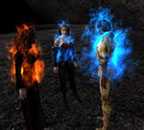
Real World Activities Effect Your Game Character
G-Link by Ross O'Shea is a student project where your real world activities effect your game character. This hip pouch and badge is full of electronics and as you wear it throughout the day, it senses and records data; how many steps you have taken, how much you speak, size, temperature and brightness of your environment.
This device has currently been prototyped using the RPG Morrowind. In usual circumstances, a player might make an avatar that is a fitter, stronger more attractive version of themselves. The G-Link reverses this and says if you sit in and play games all day, your character will be weaker, yet if you go out for a walk then your character will be stronger. Also if you go out in the sun your character will be light aligned, yet stay indoors and it will go over to the dark side. Recently part of the CoEDD graduate exhibition. [blogged by Chris on pixelsumo]
Posted by jo at 10:18 AM | Comments (0)
Hypersonic Sound
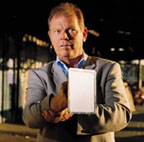
Getting Inside People’s Heads
"...Unlike traditional speakers, which scatter sound, Norris’ device streams it in a precise, laser-like beam for up to 150 yards with almost no degradation in quality or volume. (…) How does it work? The piezoelectric transducer emits sound at frequencies above the human ear’s 20,000-cycle threshold. Unlike low-frequency waves, the high-frequency signals don’t spread out as they travel through air. Yet they do interact with the air to induce a related set of ultrasonic waves. These waves combine with the original waves, interfering to create an audible signal, focused into a beam.
The applications are numerous, if not apparent: Thousands of soda machines in Tokyo will soon bombard passersby with the enticing sound of a Coke being poured, and several U.S. supermarkets will promote products to shoppers as they walk down corresponding aisles. Eventually HyperSonic Sound might enable a nightclub to play disco on one side of the dance floor and salsa on the other. Ambulances equipped with hypersonic sirens could clear the streets without waking the neighbors. Norris’ company, American Technology, sells the devices for $600." From Woody Norris has a way of getting inside your head… by David Sparrow, Popular Science.
Posted by jo at 10:12 AM | Comments (0)
Platial
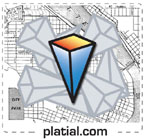
space place is the place!
Platial is a rapidly developing application and community pivoting on the anchors of user annotation, layerability, collaborative mapping, social networking and real world publishing. We are a team of 3 based in Portland, Oregon: di-ann eisnor, jason wilson and jacob olsen; getting advice from many great people, including clay shirky, anselm hook and arturo duran.We'd love to hear from you.
Want to be notified when we actually have something to play with? Join the list.
Posted by jo at 10:04 AM | Comments (0)
A Measure of Anacoustic Reason
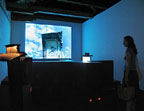
Turning a Deaf Ear
A Measure of Anacoustic Reason--by Raqs Media Collective--is an installation that registers a process of thinking about forms of reasoning that insulate themselves from listening. The installation sees the act of 'turning a deaf ear', as the unwillingness or inability to listen to the voices that refuse to be accommodated into the master narratives of progress, of instrumental reason and the domestication of space through the geomancy of corporations and nation-states. The visitor is invited to undertake his/her own audit of anacoustic reasoning through a meditation on a series of dialogues and rebuses that encrypt a set of paradoxes about the grandiose follies of seeking to rule the world by not listening to it.
A Measure of Anacoustic Reason is an installation consisitng of 1 projector, 4 screens, 4 dialogues, 4 lecterns and a lightbox. It was shown at ICon: India Contemporary at Venice Biennale 2005 (14 June-31 July, 2005)
Raqs Media Collective is produced at the Sarai Media Lab, Delhi and
at Montalvo Arts Center, Saratoga.
Additional Credits
Sound Editing: Iram Ghufran
Print Design: Mrityunjay Chatterjee
Production: Ashish Mahajan
For images of the installation please see
http://www.raqsmediacollective.net/anacoustic.html
http://www.universes-in-universe.de/car/venezia/bien51/eng/ind/img-
02.htm
Posted by jo at 09:02 AM | Comments (0)
BLUEVEND

Films on the Move
BLUEVEND is a new purpose-built vending machine with touch screen and Bluetooth technology designed for the wireless distribution of creative mobile phone content. BLUEVEND will present Pocket Shorts at its EIFF debut in August 05. Pocket Shorts gives new filmmakers the opportunity to experiment with new platforms. Look out for news of the second commissioning round in the Autumn 05.
Pocket Shorts Scotland will also be commissioning this year. All Pocket Shorts films are either 60 seconds or 4x15 seconds in length and will be freely available to everyone with a Bluetooth enabled videophone. So if you are in Edinburgh between 17th and 28th August come and try it out - we will be in the EIFF Delegates Centre at The Point Hotel on Lothian Road.
We will also be sharing our practical research into making original content for mobile phones at a presentation at The Filmhouse, Lothian Road, Edinburgh on Tuesday 23rd August at 5.30pm. Book your tickets now www.edfilmfest.org.uk.
Pocket Shorts is a NESTA funded initiative devised and managed by Blink.
Posted by jo at 08:34 AM | Comments (0)
I-F-E-A-R
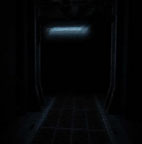
Linked Experiences
I-F-E-A-R (infrasound fear emotion audio reverb) is a project by Jodie Hancock, part of the CoEDD graduate exhibition. "This project is an exploration of emotion as a physical force and how that force can define an environment, often with more intensity than is defined by the senses. Fear is a dark and physical emotion which lends itself perfectly to conscious spatial composition."
Jo is using infrasound to see if specific emotions can be triggered. Just like walking down a dark corridor in a game can envoke fear, an installation was built for the exhibition which consists of a corridor. Outside the game Doom 3 is played by another participant. The two event are linked, as the player is controlling the infrasound played to the person in the dark corridor. As Doom is played, the video signal is sent to Max/MSP. The level of light as you walk around the game is monitored by Jitter video. Each time the player shoots in the game, the frequency of the infrasound is changed based on the darkness of the game, creating a linked experience. project website / development blog. [blogged by Chris on pixelsumo]
Posted by jo at 08:24 AM | Comments (0)
Toward a Global "Internet of Things"

Evolution or Revolution?
"...Most industry observers agree that the next wave of growth in the technology sector will be outside the realm of the traditional PC desktop. But many think of that growth in mundane terms -- with such things as cell phones and PDAs. In reality, we stand on the verge of an era that will see previously unimagined networked devices and objects. There are already some exciting applications that span the technology spectrum. NASCAR.com offers a Java applet-driven virtual dashboard that displays real-time wireless telemetry from cars during a race -- registering location, speed, RPM, braking, and more. The race cars have effectively become networked devices. Meanwhile, NASA, with the assistance of GE Medical, is now able to monitor real-time medical data (such as blood pressure, respiration, and heart rate) from its Space Shuttle astronauts. Even trees are on the network. Fifty battery powered "micromote" sensors now dangle from UC Berkeley's Mather Redwood Grove, part of a pilot program to monitor the health of groves of redwoods. The sensors register light, moisture, and temperature, enabling scientists to continuously monitor the microclimates surrounding given trees.
Such diverse networked "devices" offer concrete evidence of Metcalfe's Law. Robert Metcalfe, one of the developers of Ethernet, formulated that the usefulness of a network increases by the square of the number of nodes (users or devices) connected to the network. (Imagine how useful the telephone system would be if there were only two phones in the world!)
"In the future, everything of value will be on the network in one form of another," says John Fowler, Software CTO of Sun Microsystems. "And once they're on the network, we can aggregate data from those diverse devices, and then deliver that data to equally diverse devices -- in informative and compelling ways." And that's exactly what we're seeing today. "Most people think of a PC or a PDA as things connected to the network," continues Fowler. "But here we are connecting trees, race cars, and astronauts to the network. It's going to become a much more seamless spectrum."..." From Toward a Global "Internet of Things" by Steve Meloan, November 11, 2003.
Posted by jo at 07:45 AM | Comments (0)
Lua Player
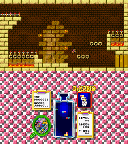
PSP Homebrew
Whilst we wait for the PSP release here in England, ps2dev user Shine is developing Lua Player. This is good news for the homebrew community as it enables beginners to create their own games using the Lua programming language. No need to compile any code, simply edit the text file, drop your grahics and sounds into the folder and copy to the PSP.
The Lua Player site has recently been born and budding creators can download the software, see other peoples games in the gallery (including source) and read tutorials. Lua Player can also handle sound and all of the button inputs. A PC version of the player is in the works that will enable you to test the games before loading on to the PSP. I am interested this from an art mod point of view, but I can see it becoming a very big resource in the future. Unfortunately for us Europeans, Sony has put firmware 2.0 on the release PSP, so no homebrew for us yet. [blogged by Chris on pixelsumo]
Posted by jo at 07:29 AM | Comments (0)
Lucid Touch
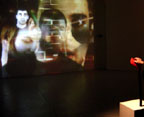
Emotion-Inducing Sculpture
Lucid Touch--by Lynne Sanderson--is a bioreactive sculpture that induces emotion using an affective feedback loop to control the flow of a dream. Through the sense of touch, bio-electrical arousal levels from the human body are altering the stream of a dream experience. The participant controls the mood of a simulated dream and the digital dreamer controls the participant's emotional state.
When a participant touches the interface with the hand, her/his biological data is detected through skin conductance response, heart rate and body temperature. The information is presented to the participant in the form of a dream, simulated using images, animation, digital video and sound. The dream is influenced and controlled by the participant whose psychophysiological state modifies the mood of the dream. His/her emotional / electrical energy controls video effects and sound. Which will in turn potentially have a direct influence on the participant's mood. Hence, the feedback loop.
A secondary feedback is that the interface physically alternates between warmth/cold and vibration. This will provide the participant with an eerie experience of something alive in the machine. An entity with the ability to sense emotion. The more excited you become, the more the entity "warms" to you.
The participant can learn how to "play" Lucid Touch with their bio-state. Once the participant is aware of this, she/he can learn to control their own emotional state by lowering stress levels or relieving boredom by raising arousal levels. [blogged by Regine on we-make-money-not]
Posted by jo at 07:21 AM | Comments (0)
August 18, 2005
Whew!
We're back! We'd been experiencing technical problems since Monday but thanks to DOUG GOODWIN we're back.
Posted by jo at 07:57 PM | Comments (0)
KORSAKOW-SYSTEM
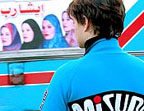
Films with a Twist
The Korsakow-System is an easy-to-use computer program for the creation of interactive films, or better: interactive database narratives. Korsakow-projects are films with a twist. They are interactive - the viewer has influence on the film. They are rule-based - the author desides on the rules scenes relate to each other, he does not create a fixed order. They are generative - the order of the scenes is calculated while the viewer looks at a Korsakow-project. Korsakow-projects can only be viewed on a computer. They can delivered via internet-streaming, DVD-Rom or CD-Rom.
The Korsakow-System was invented by Florian Thalhofer in 2000 for the making of the nonlinear documentary the [korsakow syndrom], his final piece at the University of the Arts, Berlin. It is being improved an developed by him and Prof. Willem Velthoven.
In March 2003 the Korsakow-Foundation was founded in Amsterdam. The Korsakow-Foundation organizes workshops and takes care about the further development of the Korsakow-System.
TEACHING & WORKSHOPS
Mediamatic, Amsterdam organizes Korsakow-workshops at Film- and Media-art-festivals and at Filmschools in Europe. More than 15 one-week-workshops have taken place in the Netherlands, Germany, Italy, Czech Republic, USA, Finland, Estonia and Portugal. Find out more about Korsakow-workshops at korsakow.org
From 2001 - 2004 the Korskow-System was the students' main working tool in the class "Interactive Narration", led by Prof. Willem Velthoven and Florian Thalhofer at the University of the Arts, Berlin.
From autumn 2005 on, the Korskow-System will be used at the German Literature Institute in Leipzig in a class led by Guest-Prof. Florian Thalhofer.
The Korsakow-System is also used at a number of Film- and Media-Art-Schools all around the world.
We know of approximately 250 projects that have been made with the Korsakow-System so far. Projects done with Korsakow were shown at Galleries and Festivals worldwide.
Posted by jo at 07:30 PM | Comments (0)
Psychnology

How Space Affords Socio-Cognitive Processes during Collaboration
"ABSTRACT: This paper reviews the literature about social and cognitive functions of spatial features used when collaborating in both physical and virtual settings. Those concepts come from various fields like social, cognitive as well as environmental psychology or CSCW (Computer Supported Collaborative Work). We briefly summarize the social and cognitive affordances of spatial features like distance, proxemics, co-presence, visibility or activity in the context of physical and virtual space. This review aims at grounding in an explicit framework the way human beings use space to support social interactions. This review can be used as a starting point to design efficient applications that take spatial context into account." From A Review of How Space Affords Socio-Cognitive Processes during Collaboration by Nicolas Nova, Space, Place & Technology: Presence in Mediated Experiences (#2),
Psychnology.
Posted by jo at 06:49 PM | Comments (0)
Location-Based Gaming

Industry Does Not Understand Location Technologies
In a Mobile Games Analysis, Kurt Uhlir says that the industry has still many false impressions about LBG. They must understand the complexities, strengths, and weaknesses of location technologies. They need to move past the “all or nothing” belief. Each positioning technology (GPS, WiFi, GSM, …) has its own complexity that is mainly underestimated by developers and publishers. The difficulties involve with integrating spatial data, and the accuracy that are needed in various games situations. When designing games, writing storylines and setting expectations, the industry must think about how accurate the average location will be, how often the player’s location can be updated, how the game will deal with the occasional inaccurate location reading and what the benefits are ton incorporating location into game play. [blogged by fabien on 7.5th Floor]
Posted by jo at 06:26 PM | Comments (0)
Center for Tactical Magic:
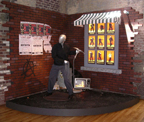
Tactical Ice Cream Unit
Grand Arts is pleased to present the latest project from the Bay Area-based Center for Tactical Magic, the Tactical Ice Cream Unit. Combining a number of successful activist strategies (Food-Not-Bombs, Copwatch, Indymedia, infoshops, etc.) into one mega-mobile, the TICU is the Voltron-like alter ego of the cops’ mobile command center. Incorporating an alternative strategy of utopian potlatch, the Tactical Ice Cream Unit is envisioned primarily as a mobile distribution center for free ice cream and information produced by local community groups.
Although the TICU appears to be a mild-mannered vending vehicle, it harbors a host of high-tech surveillance devices, including a 12-camera video surveillance system, GPS with satellite internet, and a media center capable of disseminating live audio/video. More than creating an undercover Mission: Impossible aesthetic, the TICU’s full surveillance suite provides grassroots access to mobile communications technologies. Whether used to produce independent community news or to monitor corporate dumping or police activity, the TICU will investigate the limits of “neutral technologies”.
At various times the TICU will invite visitors to explore the interior, view documentation of the street operations, or collaborate on “missions”. In addition to it’s regular cruising of local neighborhoods and streets, community groups may suggest uses for the Tactical Ice Cream Unit such as beach clean-up, block parties or supporting a strike. The Unit is prepared to augment any event and should the TICU wander into the vicinity of a rally, protest or civil uprising, the Unit is equipped to serve as a mobile oasis, where the activists can quench their thirst, reload their cameras, document unfolding events, and protect themselves from various airborne dispersants.
In short, the TICU seeks to protect, provide, energize, invigorate and educate its audience. Whether lurking in a corporate park or chillin’ in a neighborhood park, the Tactical Ice Cream Unit promises to attract people from all walks of life, thus serving as a mobile nexus for community activities while providing frosty treats and food-for-thought.
The Center for Tactical Magic is an organization dedicated to the extensive research, development, and deployment of the pragmatic system known as Tactical Magic. A fusion force summoned from the ways of the artist, the magician, the ninja, and the private investigator, Tactical Magic is an amalgam of disparate arts invoked for the purpose of actively addressing Power on individual, communal, and transnational fronts.
The Tactical Ice Cream Unit would like to extend an invitation to you to join an elite corps of embedded journalists during our ground operations in Kansas City. A few, select journalists will be permitted to ride along with the TICU crew as we begin our civic tour of duty. Participating members of the TICU Embedded Journalist Corps (EJC) will gain a behind-the-scenes and in-the-streets look at the Tactical Ice Cream Unit. This revolutionary, new project designed by the Center for Tactical Magic is preparing to take to the streets by August 20. Contact us if you feel you are up to the challenge!
For further information, contact:
April Calahan-McDonald
Grand Arts Assistant Director
(816) 421-6887
gallery@grandarts.com
Posted by jo at 06:03 PM | Comments (0)
FIVE HOLES:
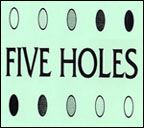
A Matter of Taste
FIVE HOLES--curated by Paul Couillard--is an ongoing series examining the significance of the body and the senses. Fado invites artists to submit proposals for a matter of taste, the final installment in the FIVE HOLES series. We seek performance art works, including conceptual, site-responsive and installation-based performances, that deal with the sense of taste. Approximately seven proposals will be chosen to create a simultaneous ensemble of events to be held in the summer of 2006 in Toronto. The focus will be on Canadian artists (i.e. at least four of the projects will feature Canadian artists).
Taste is perhaps the most 'personal' of all the senses. It is both primal -- providing the impulses that drive consumption -- and individualized: one person's desire is another's poison. While the word 'taste' is often associated with the concept of aesthetic discernment, a matter of taste places its emphasis on a specific, visceral definition of taste: the perception of flavour (and perhaps texture) that takes place inside our mouths. This series will focus on projects that explore the implications of a sense that operates through the placement of foreign material inside one's body.
A matter of taste is not concerned with the familiar social terrain of banquets and dinner parties so much as the links between physical sensation, unconscious/conscious drives, and our mouths as a point of contact with the external world. How does one orchestrate a performance for another's mouth? What are the dynamics that seduce, persuade or convince others to put things in their mouths? What intentions are bound up in the impulse to stimulate one's taste buds? What does our sense of taste reveal about our internal desires and external projections?
TORONTO.... Fado Performance Inc. announces two calls for proposals for performance art projects.Fado is a non-profit artist-run centre for performance art based in Toronto, Canada. Fado present an ongoing international programme of conceptual and site-specific performance art, and pays professional fees to the artists it presents.
CALL FOR PROPOSALS
Deadline for submissions: August 26, 2005
Please include:
*1-page proposal
*c.v.
*documentation of previous work
[NTSC video in VHS, mini-DV or DVD format; Mac-readable CDs; URLs; and/or slides]
*e-mail submissions will not be accepted except with prior approval (no large digital files!)
*press material optional
*only submissions with self-addressed stamped envelope or funds to cover shipping and packaging costs will be returned
Send proposals to:
Fado
"FIVE HOLES proposal"
273B Carlton St.
Toronto, ON
Canada M5A 2L4
info: http://www.performanceart.ca or email info@performanceart.ca
Posted by jo at 05:54 PM | Comments (0)
What Comes After: Cities, Art & Recovery
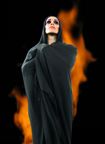
Remembering and Rebuilding after Tragedy
What Comes After: Cities, Art and Recovery: An International Summit September 8-11, 2005. Registration begins August 22. Thirty cultural leaders from 19 countries will come together for three days of roundtable discussions, performances, films, and art installations in all media. Cities, Art and Recovery will consider how people remember and rebuild after tragedy and how the arts have been crucial to such recovery.
Including: The New York Premiere of Diamanda Galás: Defixiones, Orders from the Dead and Political Cabaret with Danny Hoch, Rennie Harris, Carl Hancock Rux and Suheir Hammad.
Exhibitions:
After Effects After the World Trade Center residency, LMCC artists look at what comes next.A Knock at the Door... Is it art or is it dangerous? Homeland Security Garden transforms the Winter Garden into a participatory sculpture that reveals our notions of safety and freedom. book A sketchbook travels between Brooklyn and Belfast.Greetings Without Flowers Large scale photo-portraits taken in Iraq.Chat the Planet Young people in NYC and around the world connect by video chat in real time conversation.
Panelists:
Ammiel Alcalay, USA
Sultan Barakat, UK
Elazar Barkan, USA
Gillian Caldwell, USA
Clifford Chanin, USA
Craig Dykers, Norway/USA
Horst Hoheisel, Germany
Vannak Huy, Cambodia
Suada Kapic, Bosnia
Avila Kilmurray, UK
Robert Kluyver, Afghanistan
Duma Kumalo, South Africa
Gerald McMaster, Canada
Semezdin Mehmedinovic, Bosnia/USA
Ana Miljanic, Serbia & Montenegro
Dijana Milosevic, Serbia & Montenegro
Vasuki Nesiah, Sri Lanka/USA
Brigitte Oleschinski, Germany
Maysoon Pachachi, Iraq/UK
Leo Rubinfien, USA
Biljana Srbljanovic, Serbia & Montenegro
Jad Tabet, France/Lebanon
Lyonel Trouillot, Haiti
Patricia Tappata de Valdez, Argentina
Clive van den Berg, South Africa
Camilo Jose Vergara, Chile/USA
Eyal Weizman, Tel Aviv/London
Lebbeus Woods, USA
James Young, USA
Posted by jo at 05:48 PM | Comments (0)
Video Traces
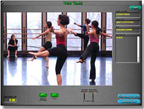
Capturing and Annotating Media both Visually and Verbally
Video Traces was conceived and designed by Dr. Reed Stevens of the College of Education and has been developed and studied in collaboration with PETTT. Video Traces is a system that makes it easy to capture a piece of rich digital media, such as video or a digital image, and to annotate that media both visually (using a pointer to record gestures) and verbally. The resulting product is a "video trace": a piece of media plus its annotation--in essence, a recorded "show & tell". Traces can be viewed by their creator, exchanged with others, and further annotated for a variety of teaching and learning purposes. Video Traces provides a unique opportunity to capture embodied knowledge and educational interactions by supporting the most common ways people communicate their ideas--through talking, showing, and pointing.
The Video Traces project serves PETTT goals in a number of ways:
· Explore the interplay of technology and pedagogy in real settings: We have collaborated with individuals both within and outside of the University, and have explored educational uses of Video Traces in settings such as dance studios, architectural sites, and science museums.
· Facilitate thoughtful and innovative educational technology uses: We have found that using Video Traces prompts reflection on the part of both learners and instructors, and in several cases has inspired instructors to adopt innovative new strategies for teaching their courses and for assessing student learning.
· Make strong connections between research, design, and practice: We have used our observations about how people use Video Traces and our interviews with learners and instructors to inform the redesign of the software and generate further questions for research.
Video Traces: Rich Media Annotations for Teaching and Learning by Reed Stevens, Gina Cherry, and Janice Fournier
Posted by jo at 05:39 PM | Comments (0)
August 17, 2005
MATISSE & SMS
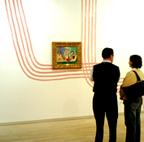
Different takes on Matisse
MATISSE & is the title and framework of an experimental exhibition currently running at the Danish National Gallery (Statens Museum for Kunst) in Copenhagen. Works by three contemporary artists - Malene Landgreen, Jesper Just and Aino Kannisto - are practically and conceptually intervowen with the work of Matisse and visitors can access a sub layer of information via their mobile phones.
More precisely, by sending an SMS to a phonenumber situated next to the individual artworks, visitors recieve a text message - a thought or a statement - formulated by Landgreen, Just or Kannisto. Furthemore, visitors can also submit their own thoughts as well as recieve messages submitted by previous visitors, thus enabling them to interconnect via their feedback. [via guerrilla innovation]
Posted by jo at 05:29 PM | Comments (0)
R&Sie(n)’s Dandy & Mutant A-life Architecture

I’ve heard about…©
R&Sie(n)’s Dandy & Mutant A-life Architecture by Joseph Nechvatal: R&Sie(n)’s exhibition “I’ve heard about…©” opened on the 6th of July at the Musee d’Art Moderne de la Ville de Paris‘s temporary space at the Couvent des Cordeliers - and I think it is one of the most relevant exhibitions to what is going on in art today that is of importance. R&Sie(n) is an investigational architectural firm consisting of François Roche, Stéphanie Lavaux, and Jean Navarro; working here with Benoît Durandin. Together, they utilize generative heterogeneous mutations in the creation of proposed utopian city spaces. In fact what they propose at the Musee d’Art Moderne is the artificial growing of extruded urban housing (generative & robotic) - where new cities are constructed via robotic processes by feeding off the carcasses of older dying cities. Very viral. Envisioned is an approach to city planning based on growth scripts and open algorithmic procedures. Towards these ends the show itself includes some subtle audio tracts, model-sculptures, a fully immersive hypnosis chamber with video monitors, booking services, 3D movies and robotic drawings/plans that reveal the source code of the generative program at the heart of their work.
There is a definite tangled and intertwined approach to the city vector that reminds me of the dithyrambic visual hyper-logic which has manifested in all modes of decadent artistic periods; from the Hellenistic and Flamboyant Gothic, to the Mannerist, Rococo, and Fin-de-Siècle - as they all opposed dogmatically imposed ocular paradigms with hyper-engendering strategies of form. The multiplicity of its interwoven experiences challenges the now bogus idea of simplicity – a modernist-minimalist idea which has taken on the intensity of a righteous injunction in many cities where the implied equation between simplicity, surveillance and goodness obscures a less evident function: that of cognitive constraint. Such constraint runs counter to what Georges Bataille considered to be the non-hypocritical human condition, which he took as being roused non-productive expenditure (threshold excess) entangled with exhilaration. For the finest comprehensive overview of Bataille's thought in this regard, see his book Eroticism - but also Denis Hollier's book on Bataille's general postulates, Against Architecture.
Given the organic-like, biomorphic architectural forms R&Sie(n) spawn by their generative program, I could not avoid thinking about the Palais Idéal of Ferdinand Cheval (1836-1924) - which to my eyes appeared to be one huge budding edifice when I visited it a few years ago - as if the stupendous mannerist grotto-façade at villa Borromeo had been left to grow untrimmed and run amok. However, the Palais Idéal was constructed by the postman Cheval alone and by hand in the Hauterives (Drôme) (near Lyon) between the years 1879 and 1912; the result of 93,000 man hours of hard labour. R&Sie(n) rightly prefers the work to be accomplished through a computer programmed emergence via artificial intelligence which directs robotic execution. Why should humans physically work when we might better be playing and dreaming?
The other inescapable reference for R&Sie(n)’s work is the visionary city-planning put forth by the Situationists. One thinks immediately of Guy Debord’s essay On Wild Architecture, for example. Like the Situationists, for R&Sie(n), the urban form no longer depends on the arbitrary decisions or control over its emergence exercised by the elite few. Ultimately R&Sie(n) leads us towards juicy Situationist-like complexities and engagements by way of immersion into an open-ended multiplex conceivable as a virtual environment: the Virtual Reality experience.
As R&Sie(n) say themselves, “Many different stimuli have contributed to the emergence of “I’ve heard about…©” and they are continually reloaded. Its existence is inextricably linked to the end of the grand narratives, the objective recognition of climatic changes, a suspicion of all morality (even ecological), to the vibration of social phenomena and the urgent need to renew the democratic mechanisms. Fiction is its reality principle…” Ahhhhh, the domain of decadent art, VR and artifice. Against Nature.
What has been somewhat poorly determined however is the degree a dweller feels totally immersed in an optically excessive space. And this depends to a large extent on personal psychological need and adaptability in accord with the proposed spatial depth cues. Cognitive-aesthetic space has to be coordinated phenomenologically with the proprioceptive space of the eye - and R&Sie(n)’s only failure is in maintaining the evident structural seams of the immersive faux-hypnotic chamber (the only enterable structure and the highlight of the show) because what the entire show is proposing is a seamless immersion into generative totality, and the visual seams take us out of that exquisite fantasy. So they are denied the loveliest of triumphs.
A pity, as one might otherwise imagine oneself totally immersed there somewhat like a 21st Century dandy. As at the birth of the 20th Century, this new hyper-dandy constantly might affirm his or her originality down to the decorative details of the home. In that the robots are doing the algorithmic planning and building, this work definitely proposes a new form of dandyism - if dandyism’s defining characteristic is remembered to be the making of one’s person a work of art while extolling laziness and displaying contempt for work. Evident here are the Baudelairean/Duchampian dandy ideals of impassivity, nonchalance elegance, and inscrutability. What matters are the triumphs of a radical contempt for one’s “hand”.
Indeed one can say that “I’ve heard about…©” favorably extolled artificiality, indifference, impassiveness - the reign of an ironic causality and knotted ambivalence, while staying open to all transactions. Most importantly, a-life forms are embedded within it and its growth is artificial and synthetic. So R&Sie(n) maintains a version of transcendental phenomenological idealism, but they do not disavow the extant actuality of the material sphere. Instead they seek to elucidate the sense of the world-as-is today - that is viractualized – by stressing the embodied nature of human and artificial consciousness and bodily existence as the original and originating material premise of sense and signification.
All told, the show is well done – as proposition. However this proposition inevitably turns the mind to the actualized imposing suavity of Antoni Gaudí’s fully realized wavy architectural shapes in Catalonia. Although he did not travel about Europe, Gaudí was aquatinted with fin-de-siècle Belgium/French avant-garde movements because of the intimate relationship between Barcelona and France and with the pre-modernistic movements of Arts and Crafts, Gothic Revival, and Impressionism which were discussed in the intellectual proto-modernist circle which he frequented. But it was Victor Horta's Art Nouveau movement that influenced Gaudí the most, stimulating him to experiment with new materials and new fluid shapes that appear grown. Gaudí's version of Art Nouveau is characterized by an overwhelming proclivity for the organic nature of women, beasts, and plants which he translated into immersive utility.
Antoni Gaudí is a chief exponent of R&Sie(n)-type open algorithmic building procedures precisely with his 1906 building Casa Batlló located at 43, Passeig de Gràcia, Barcelona - noticeable for its organic tactility of bones and shells within, and its external cocked surf façade and chimerical roof. With Casa Batlló, Gaudí accomplished an astute transformation of an existing building, transforming it into an enchanting immersive gesamtkunstwerk as Gaudí thoroughly undertook the design of every single element of the building, from the extravagantly protuberant façade to all aspects of the interior, including the gracefully gnarled furniture. On the exterior Gaudí was able to combine a flamboyantly surging façade (in an ingeniously cool-color orchestration) while maintaining a dialogue with the neighboring Casa Ametller (1900), built by Josep Puig i Cadafalch (1869-1956) four years earlier. Powerful pillars which resemble the substantiality of mammoth elephant legs accost the visitor at street level, protruding into the sidewalk, nigh tripping up an unaware pedestrian. These legs are bordered by a craggy vertebrae-like tier and the wavy façade extends upward between these two biologically evoking forms, culminating at the roof in a gargoylesque humping crescendo. The façade itself, coated in a layer of Montjuïc stone, shimmers seductively under the sun in multifarious chameleon-like colors; fraught with a scattering of small roundish plates resembling fish or reptilian scales. Affixed to this seething mass of swelling construction are a number of small, elegantly curved balconies with oval shaped portholes.
The entire structure feels unsharpened, flowing and smooth in opposition to the street itself on which the arrangement sits, with the exception of a few square windows up top. Even the walls are gently rounded in strained undulation and contraction, as if they too have entered into the oceanic female throws of a fluttering uteral orgasm. The walls appear to be made of a soft, smooth, supple, leathery material and this illusion of softness is carried through by the roundness of the inside forms of the building where one has the feeling of being pleasantly encased in an expanse of hardened dripped honey. Turning, lunging stair railings are met, engulfed and supplemented by softly heaving honey-colored walls and wooden biomorphicly shaped carved doors and irregularly shaped windows. There are no right angled corners or straight lines, which offers an impression of being wrapped up in one continuous fluid wave motion, complimentary with the exterior. By comparison, R&Sie(n) still has a ways to go in achieving a like sensuality of its avant-garde stance. But one only hopes for them an immediate success in doing so.
Credits:
R&Sie(n) = François Roche, Stéphanie Lavaux, and Jean Navarro with Benoît Durandin
With the production and authorship of :
-Berokh Khoshnevis (Contour Crafting Process, USC, LA)
-Francois Roustang (Hypnosis specialist, Paris)
-Chris Delaporte (Film director, 3D effect, Paris)
-Christophe Berdaguer & Marie Pejus (Artist, Marseille)
-Mathieu Lehanneur (Designer, Paris)
-Laurent Genefort (Science Fiction writer, Paris)
-CNRS Grenoble, Laboratoire de Spectrometrie (Nano Particules)
-M/M (Graphic designer, Paris)
-Gilles Schaeffer (mathematicien, Paris)
-Michel Boulcourt (Landscape architect, Paris)
-Alexandra Midal (Author, Paris)
-Matthieu Kavyrchine (Video artist, Paris)
-Sebastien Szczyrk (Sound designer, Paris)
-Alexandre Merlet (Video producer, Paris)
-Stephan Henrich (Architect, Germany)
-Providence (Singer)
Prototype / installation / publishing
-Ufacto, David Toppani (prototype scale 1)
-One Star Press (neighbourhood protocole publishing)
-Christian Hubert Delisle (prototype)
-Thibaut Boyer (installation)
-Jean-Michel Castagné (electronic driver)
Sponsors, partnership
MAM Paris-Musée (F), MUDAM (L), De SINGEL (B), USC (USA), KANAZAWA 21st century museum (J), CNC / Dicream, (F), LAFARGE (F), Materialise (B), Next Limit Technologies (SP), DAPA (F), University of Architecture Innsbruck (OST), New-Territories (F)
Show closes the 9th of October. Musee d’Art Moderne de la Ville de Paris / Couvent des Cordeliers / 15 Rue de l'ecole de Medecine / 75006 / Phone : 0156813321
Images and more info available at: www.mam.paris.fr
Even more info available at: www.new-territories.com
Posted by jo at 08:06 AM | Comments (0)
Nicolas Schöffer
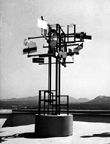
The Father of Cybernetic Art
Review of Nicolas Schöffer Exhibition by Joseph Nechvatal: Espace EDF Electra, 6, rue Recamier, 5007 Paris; Until September 11th, 2005.
"If one discounts the existence of László Moholy-Nagy’s Bauhaus Light Space Modulator (1923-30) (rebuilt in 1970 and now in the collection of Harvard University's Busch-Reisinger Museum) – a visionary multimedia artwork that helped inaugurate the artistic dialogue between machines, light, shadow and motion - there is something to the claim that the Hungarian-born French artist Nicolas Schöffer (1912-1992) is 'the Father of Cybernetic Art'. At the very least this premise may now be entertained while viewing actual work (mostly mobile sculpture under theatrical lighting effects) and an incredible amount of documentation now on view in Paris at the museum of the French electricity company Espace EDF Electra.
What is immediately evident in this exceptional historic presentation is that Schöffer’s career touched on painting, kinetic sculpture, architecture, urbanism, film, TV, and even music (he collaborated with Pierre Henry) – all in the pursuit of a dynamism in art which was originally initiated by the Cubo-Futurists and then intensified and solidified by the Russian Constructivists such as Naum Gabo, Anton Pevsner, Moholy-Nagy and Ludwig Hirschfeld-Mack. All were concerned with opening up the static three-dimensional sculptural form to a fourth dimension of time and motion, and this was Schöffer’s intention as well. Schöffer however, coming well after, benefited pleasingly from cybernetic theories (theories of feedback systems (interactivity) primarily based on the ideas of Norbert Wiener (1894-1964)) in that they suggested to him artistic processes in terms of the organization of the system manifesting it (e.g., the circular causality of feedback-loops). For Schöffer, this enabled cybernetics to elucidate complex artistic relationships from within the work itself.
His CYSP 1, from 1956 (top), is considered the first cybernetic sculpture in art history in that it made use of electronic computations as developed by the Philips Company. The sculpture is set on a base mounted on four rollers, which contains the mechanism and the electronic brain. The plates are operated by small motors located under their axis. Photo-electric cells and a microphone built into the sculpture catch all the variations in the fields of color, light intensity and sound intensity. All these changes occasion reactions on the part of the sculpture.
Consequently Schöffer’s kinetic sculptural compositions were able to parallel Warren McCulloch's adaptation of cybernetics in formulating a creative epistemology concerned with the self-communication within an observer's psyche and between the psyche and the surrounding environment. This is cybernetics’ primary usefulness in studying the supposed subject/object polarity in terms of artistic experience. That is the theoretical premise, at least.
In actuality we are treated here to dramatic light shows (some on the trippy side) that come whirling out of his spinning mechanical metal sculptures. Colored lights bounce off revolving polished metal towers - casting ever-changing lights and shadows onto huge wall screens and into our eyes. There also is a very basic interactive room consisting of a group of smaller whirling sculptures which respond to the presence of a viewer and a large prismatic triangle structure containing infinity views. This work brought to mind Lucas Samaras, Room 2 and other mirrored immersive works such as Getulio Alvani’s Cubic Environment and Luc Peire's Environment – all of which similarly offered the viewer a pervasive reflective arrangement where mirrored surfaces rebound amplitude to an indefinite degree.
In Schöffer’s triangular structure, my image was being ceaselessly mixed and reflected within spinning lights as I was made to feel an integral part of an exploding expanse. In general, this infinity experience bided me to view myself in infinity and so to feel space not in the traditional passive Euclidean custom - but in a conceptually operative and viractual (viractive) manner.
In addition, the exhibition demonstrates Schöffer’s three period styles. First is his “spatio-dynamic” constructions from 1948 on: attempts at a synthesis of spatial and dynamic elements. Next come the “lumo-dynamic” constructions of 1957, which connect light projections to music. In his “chrono-dynamic” works of 1959, word and tone, movement and space, light and color form together a totality of space-time.
Also well documented is Schöffer’s 52 metres high Cybernetic Tower from 1961, which was constructed in Liege with 66 revolving mirrors.
Given the period-piece nature of the exhibition, I found it stylistically engaging - and not overly retro looking. Indeed, the show surprisingly did not appear that dated, even though of course it recalled the early Paris 60’s and the futuristic 'space age' designs of Paco Rabanne which involved the use of moving metallic discs or plates. Yet my subject/object polarity never shifted much.
But given that, shouldn’t Nicolas Schöffer work be considered something other than an art object per se? Perhaps it is more appropriate to think of it as a means of transforming static perspective vision into a luminous motion study. We might just as well consider it then as stage props. Or better, an apparatus for painting with light. With his video works of 1961, Schöffer is additionally regarded as an early representative of video art – so perhaps it all funnels into special effects broadcast TV (which he did).
For me, the final interest of this show (which I have seen three times now) is in its allowing me to better position Schöffer in a certain art-tech artist-engineer intellectual history – a living history which has not yet exhausted itself. Indeed it is touching to consider that László Moholy-Nagy’s Light Space Modulator – which was driven by a motor and equipped with 128 electric bulbs in different colors - was finally demonstrated at the 1930 Paris Werkbund exhibition. So we see Nicolas Schöffer here not only as a pioneer of cybernetic art, kinetic sculptor, town planner, architect and theoretician of art - but as a key player in the middle of the art-tech intellectual narration – a narration which increasingly defines artistic achievement in the beginning of the 21st century." --Joseph Nechvatal. [Video]
Posted by jo at 08:00 AM | Comments (0)
August 16, 2005
TECHSTYLE NEWS: Issue #52 - August 15, 2005
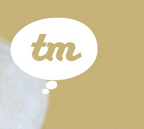
Next Generation Mobile Technology
Techstyle News is a free monthly newsletter providing summaries and commentaries on stories related to the next generation of mobile technology and style, produced by Thinking Materials.
In this issue: (1) Hardwear News: Motorola and Oakley announce cellphone sunglasses; Texas Instruments launches mobile single-chip solution; MP3 sunglasses from Global American Technologies; Digital locket from Beatsounds; Digital picture pendant from Spectare; (2) Softwear News: IBM software lets you carry your PC around your neck; and (3) Events: Mobicom 2005 in Cologne; Ubicomp 2005 in Tokyo; Wearable Futures in Newport.
HARDWEAR NEWS
MOTOROLA AND OAKLEY ANNOUNCE CELLPHONE SUNGLASSES
Motorola and Oakley has announced the expected availability of RAZRWIRE Bluetooth eyewear in early August. The Bluetooth module is designed to complement the overall look of the sunglasses, creating truly wearable technology. The controls include two volume buttons and a single button used to handle incoming and outgoing calls. RAZRWIRE allows you to carry on phone conversations while up to 30 feet away from your compatible Bluetooth-enabled cell phone. Bluetooth Sniff Mode technology increases the battery life of RAZRWIRE, offering continuous talk time of more than five hours and standby time of up to approximately 100 hours.
http://oakley.com/about/razrwire/
TEXAS INSTRUMENTS LAUNCHES MOBILE SINGLE-CHIP SOLUTION
TEXAS Instruments has announced the launch of its single-chip mobile solution. Manufacturers such as Nokia, Motorola, and Ericsson are expected to launch handsets based on the solution in nine months. Mr Tom Engibous, Chairman, said: "The single-chip solution will bring down power and space consumption by 50 per cent and cut costs by 30 per cent". With this, he said, there is the possibility of $20 cell phones on the horizon. The small chips can be easily integrated, bringing phone technology to all kinds of products.
http://news.com.com/Is+a+20+cell+phone+on+the+horizon/2100-1039_3-5823239.html
MP3 SUNGLASSES FROM GLOBAL AMERICAN TECHNOLOGIES
Global American Technologies have launched the Fio MP3 sunglasses. The retail prices are $200 to $400 at storage capacities of 128MB up to 1GB, include 3D stereo sound earbuds in each arm, support MP3/WMA/ADCPM and have a reported battery life of 8.5 hours. Transfer is via USB 2.0 to either a Mac or a PC, with an integrated microphone providing digital voice recording capabilities.
http://www.techtree.com/techtree/jsp/article.jsp?article_id=5284&cat_id=505
DIGITAL LOCKET FROM BEATSOUNDS
The Digital Locket EMP-Z II Plus from BeatSounds tries to be more than just a wearable MP3 player. This tiny music player has a small, oval color screen that can display a photo. The Digital Locket measures 2 inches by 1.8 inches, weighs 0.9 ounce and has a battery that lasts up to 16 hours before it needs recharging. It can play digital audio files in the MP3 or Windows Media audio formats and comes with its own software for transferring photos and music from a computer over a USB connection. An FM radio tuner and a voice recorder are also tucked inside. Prices start at $80 for the 256-megabyte version and go up to $150 for the model with a full gigabyte of memory.
http://beatsounds.com/Pb/index.asp?CurrentCatID=C1035889862578133
DIGITAL PICTURE PENDANT FROM SPECTARE
The Pixi Digital Picture Pendant is a necklace with a 1-inch, 96 x 64 pixel LCD screen and enough memory (512 KB) for storing up to 54 extremely low-res digital photos. For viewing up to 2 hours in slideshow mode, or longer in manual mode. The pendant is USB 1.1 compatible and compatible with photos in JPEG format.
http://chipchick.blogs.com/chip_chick/2005/08/pixi_digital_pi.html
SOFTWEAR NEWS
IBM SOFTWARE LETS YOU CARRY YOUR PC AROUND YOUR NECK
Researchers at IBM are testing software that would let you tote your home or office desktop around on an iPod or similar portable/wearable device so that you could run it on any PC. The virtual computer user environment setup is called SoulPad, and consumers install it from a x86-based home or office PC. SoulPad uses a USB or FireWire connection to access the network cards for connecting to the Internet, the computer's display, the keyboard, the main processor and the memory, but not the hard disk. After the person disconnects the system, SoulPad saves all work to the device, including browser cookies or other digital signatures that a PC keeps in its short-term memory.
http://www.research.ibm.com/WearableComputing/SoulPad/soulpad.html
EVENTS
MOBICOM 2005 IN COLOGNE
ACM MobiCom 2005 is dedicated to addressing the challenges in the areas of mobile computing and networking. This single-track conference serves as an international forum addressing networks, systems, algorithms, and applications that support the symbiosis of mobile computers and wireless networks. It will be held August 28 through September 2 in Cologne. Speakers include representatives from Bell Labs, Daimler Chrysler, NTT DoCoMo and MIT. Particularly interesting could be the panel on Wearable computing with, among others, Steve Mann.
http://www.sigmobile.org/mobicom/2005/
UBICOMP 2005 IN TOKYO
UbiComp 2005, the Seventh International Conference on Ubiquitous Computing, will be held September 11-14, 2005 in Tokyo. The conference provides a forum in which to present research results in all areas relating to the design, implementation, application and evaluation of ubiquitous computing technologies. Papers include submissions from Intel, NTT, Nokia, Microsoft and IBM. There are also thirteen workshops to participate in.
http://ubicomp.org/ubicomp2005/
WEARABLE FUTURES IN NEWPORT
Wearable Futures is an interdisciplinary conference, to be held in Newport on 14-16 September, which aims to bring together practitioners, inventors, and theorists in the field of soft technology and wearables including those concerned with fashion, textiles, sportswear, interaction design, media and live arts, medical textiles, wellness, perception and psychology, IPR, polymer science, nanotechnology, military, and other relevant research strands. We will be examining how some broad generic questions will be explored in relation to wearable technology including but not restricted to: aesthetics and design, function and durability versus market forces; the desires, needs and realities of wearable technologies; technology and culture; simplicity and sustainability; design for wearability.
http://artschool.newport.ac.uk/smartclothes/wearablefutures.html
Posted by jo at 09:57 AM | Comments (0)
MAY YOU LIVE IN INTERESTING TIMES
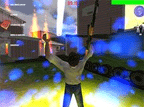
Exploring Digital Technologies in the Context of Public/Shared Spheres
MAY YOU LIVE IN INTERESTING TIMES is Cardiff’s inaugural festival of creative technology - a three-day programme of events being held across the capital. The festival is being developed between Chapter and Bloc (Creative Technology Wales) and includes a two-day conference, new commissions, residencies, screenings, and artists’ projects in public sites across the city.
Artists are increasingly engaged with or inspired by digital technology - exploring consumer and communication technologies such as the worldwide web, mobile networks, file sharing, and computer gaming. Because digital technology is a participatory medium with global reach, artists tend to explore digital technology in the context of public and shared spheres. Often digital art is situated somewhere between public art and street culture where the technology itself is used as a ‘site’ for the production and presentation of art works. Although digital technology is often claimed to go beyond physical limitations, engagement with technology is always embedded in real spaces, whether this is explored from a user or network perspective.
Artists include: Blast Theory, Anri Sala, Grennan & Sperandio, TJ Wilcox, Jen Southern & Jen Hamilton, Scanner, Sarah Morris, Michelle Teran, Eddo Stern, Stefhan Caddick, Nina Pope & Karen Guthrie, Tim Davies, Rosalind Nashashibi, Tenant Spin, Andy Fung, Paddy Jolley, Mircea Cantor, STAR Radio, Valérie Jouve, Chris Evans, Mike Mills, Artstation, and many more.
Conference day 1: 28 October - Locative media and emplacement Speakers include: Prof Michael Corris, Head of Art & Photography, University of Newport; Claire Doherty, Director, Situations; Nina Pope, artist; Heath Bunting, artist; Giles Lane, Proboscis; Steve Benford, Professor in Collaborative Computing, University of Nottingham; Dr Sarah Green, Social Anthropologist, University of Manchester; Jen Southern & Jen Hamilton, artists.
Conference day 2: 29 October - Gaming Speakers include: Ju Row Farr, artist, Blast Theory; Stuart Nolan, researcher; Christopher Sperandio, artist; Eddo Stern, artist; David Surman, Lecturer in Computer Games Design, University of Newport; Alex Mayhew & Emma Westecott, Games Producers & Directors.
Conference Prices: £50 per day / £90 weekend ticket – organisations; £30 / £50 – early bird booking before 7 October £20 per day / £30 weekend ticket – individuals /concs; £15 / £25 – early bird booking before 7 Oct Party, The Point, Cardiff, 29 Oct, 8pm: Special Guests Scanner, Michelle Teran, Proober Glombat, Cymbient, Christopher Rees DJs.
The site will feature live streaming, artists’ projects, downloads, full biographies and images, conference booking and travel details, press section and the chance to receive regular updates on festival activity.
For further information about the programme and conference please contact: Gordon Dalton, Festival Coordinator: gordon@mayyouliveininterestingtimes.org 44 (0) 29 2031 1059 / 0779 234 1654
The festival is a Cardiff 2005 event and is presented with the support of: Cardiff County Council, Millennium Commission, the Arts Council of Wales, WDA, Cywaith Cymru . Artworks Wales, BBCi, Creative Mwldan, Millennium Stadium, Mute, G39, The Big Sleep, Elfen, Zenith Media, UWN, National Museums and Galleries of Wales, Sequence, Coolpants, Ping Wales, Oriel Mostyn and @Wales. http://www.bloc.org.uk/cgi-bin/showbig.cgi?id=55
Posted by jo at 09:51 AM | Comments (0)
Dance Dance Immolation
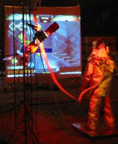
Lighting up the Burning Man Festival
So, what’s better than video games? According to the good people at Interpretive Arson, video games with fire, of course. If you don’t risk your life enough by slipping on dance pads (or by embarrassing everyone you love who’s watching you), then this Dance Dance Revolution hack, called Dance Dance Immolation, might be just the thing for you. What happens in DDI is that you dance like in any iteration of DDR, but when you do poorly, instead of simply losing points or possibly failing a level, you get blasted in the face with flamethrowers while in the protective suit you see here. (Though, to tell the truth, they’re using a DDR PC “simulator” to actually run the game.)
If you’re ready to step to the beat, and step into a full aluminized proximity suit (like the ones used to fight fires at airports), then stop by the 2005 Burning Man festival in Nevada, scheduled for the week leading up to and including Labor Day weekend (August 29-September 5), and give this hot twist on an already niche genre a spin. And if the author of the got-next.com article (linked below) which interviews the DDI Project Leader is to be believed, then you may be able to catch the crew as they’re testing in West Oakland each weekend prior to their big Burning Man debut. The original test run was held at the Crucible’s Fire Arts Festival in Oakland back in July.
Disclaimer: I try not to bother my downstairs neighbors by dancing furiously above them, but please (for the love of God), don’t try this mod at home. If DDR doesn’t get you hot enough under the collar already, just wait till the fire department has to clean up after you. Don’t say I didn’t warn you. [posted Dan Choi on joystiq]
Posted by jo at 09:49 AM | Comments (0)
Do we have an Image Problem?

Performance and Media Art caught between Art History and Visual Culture Studies
The first Media Art Conference in Osnabrück will take place from the 15th to the 17th of May 2006 as a three-day specialist symposium at the University of Osnabrück and is sponsored by Department of Kultur- und Geowissenschaften. It will be held immediately following the 19th European Media Art Festival (EMAF, 10th to 14th May 2006), one of the largest media art events in Europe. This conference in will direct attention to timely questions confronting art history, in particular the multimedia aspects concerning the production, critical appraisal and dissemination of performance and media art. Thus the following aspects will be addressed:
1. art history’s repositioning itself in relation to Visual Culture Studies, Media Studies and Cultural history; 2. the development of a modus operandi which takes into consideration a wide range of methodologies and the interpenetration of different genres; 3. the description and analysis of media art in the face of the instable status of the work concept in Media Art, and art in general.
The key issues to be addressed by the first Media Art Conference in Osnabrück can be summarised by the following question:
Given the increasingly complex demands which the wide range of visual, media, critical, performance, cultural and gender studies exert on the teaching and research environment, how can the history of art maintain its ability to deal aptly with representations, new media and art and simultaneously incorporate interdisciplinary strategies?
By focussing on time- and action-oriented art forms, the traditional discourse will be broadened to include the following questions: Can an (inter)active beholder play an integral role in the making of a work of art without jeopardising its intrinsic artistic value or reducing the “autonomy of the work of art” to a mere attribute? Where exactly do performance and media art fit into the already inflated body of terminology for denoting images?
A glance at the large number of university graduates dealing with art and visual culture (Berlin, Frankfurt, Karlsruhe, Basel) documents the current popularity of the image-discourse. Similarly, the flood of specialist literature in recent years as well as related conferences (e.g. Art Historians Day, Bonn 2005) confirm this trend.
If we take a look at the origins of performance and media art in the 1960s and 1970s and the subsequent development of the iconic/pictorial turns, the suspicion arises that recent efforts to expand the boundaries of art history to absorb current visual culture occurred in part to circumvent the challenges posed by these new art forms.
By investigating art forms which defy traditional definition while exploring the definitions themselves, this conference will attempt to graft these two ambivalent discourses. At the same time it will lay the foundations for a reinterpretation of the relevant academic fields. An impressive series of arguments presented by artists, art historians and experts in media studies address the need to conjoin these conflicting fields of study.
Call for Papers
The conference will focus on the growing affinity between art forms produced, experienced and distributed by the media on the one hand and the highly debated iconic or pictorial turn on the other. One of the central issues will be to question whether the recently developed aesthetic terminology can sufficiently deal with the time- and action-oriented art forms of performance and media art.
In addition to a number of distinguished experts invited to present papers, the speakers will include young scholars as well as contributors selected on the basis of the abstracts they submitted to this call for papers.
Enclosed you will find further information concerning the background and objectives of the conference. Please do not hesitate to ask us questions at any time.
We would be very pleased to include you among the speakers or authors for our planned publication.
Topics for Talks and Articles
1. Performance and media art in the context of the contemporary debate between art history and Visual Culture Studies and where art history is positioning itself in relation to Visual Culture Studies, Media Studies and Cultural History.
2. Media art, art history’s cultural orientation and the scientific modus operandi given the wide range of methodologies and the overlap of genres.
3. Examples of art historical and media studies descriptions and analysis of performance and media art.
In addition to a description of content, the abstracts for papers (c. 400 words) should clearly demonstrate both their relevance to the theme of the conference and their originality.
A publication of the conference findings is planned. All contributions will be considered.
Please submit your abstracts by 30 October 2005 to the EMAC office:
Media Art Conference Osnabrück
http://www.media-art-conference.com
Universität Osnabrück
Fachbereich Kultur- und Geowissenschaften
Kunstgeschichte
Katharinenstraße 5
49069 Osnabrück
Germany
Junior professor Dr. Slavko Kacunko (Organisation)
skacunko@uni-osnabrueck.de
Priv. Doz. Dr. Habil. Dawn Leach (Organisation)
dr.leach@kunstakademie-duesseldorf.de
Björn Brüggemann (Büro)
bjbruegg@uni-osnabrueck.de
Phone: +49 (0)541 969-6041
Fax: +49 (0)541 969-4103
Posted by jo at 09:47 AM | Comments (0)
From database and place to bio-tech and bots:

Relationality vs Autonomy in Media Art
Two predominant theories have emerged in the discourse surrounding new media: autonomy and relationality. On the outset, these notions seem to contradict each other. The theory of autonomy focuses attention on the discrete elements involved: individual pieces of information, individual artists or viewers, and separate components/artworks. Relationality puts the emphasis on interconnectedness: data, artwork, artists, and viewers are inextricably intertwined, without a single predominant object or viewpoint and no fixed, absolute form.
While these theories may seem to be contradictory, contemporary media art relies on a notion of autonomy and, yet, suggests that no information is autonomous—while discrete variables exist, nothing can be separate and complete in itself. The same is true of the relationships between viewers, artists, and their work constructed in the context of media art. While the topics of autonomy and relationality have long lineages in art history, this panel will discuss their contemporary status from the perspective of media art practice and theory.
Papers can address a range of topics including but not limited to: hacktivism and parasitic media, appropriation/sampling/remixing, open source theory and culture, locational media, biotechnology, video games, narrative, net art, software art, networked performance, video, sound art, and VJ/DJ practice. Consideration will be given to more "traditional" academic papers as well as artist talks that introduce artistic work and practices that contribute to the discussion of autonomy and relationality in media art.
CALL FOR PAPERS: The New Media Caucus panel at the College Art Association's 93rd annual conference.
DATES: February 22-25, 2006, Boston, Massachusetts
DEADLINE: Proposals must be e-mailed to
marisaso(at)gmail(dot)com by Friday, September 16, 2005.
NOTE: Panelists are NOT REQUIRED to be members of CAA.
Panel Chair: Marisa S. Olson, Artist; Editor and Curator at Large, Rhizome.org; UC Berkeley, Rhetoric/Film Studies.
PROPOSAL FORMAT:
* Proposed paper title
* An abstract of 300-500 words
* A note on presentational format: will you present a "traditional" paper, will you emphasize visual materials, and what—if any—audio/visual equipment will you need? (Please minimize.)
* Confirmation of ability to attend the CAA conference, Feb 22-25, 2006, in Boston
* A current CV with full contact information
Posted by jo at 09:45 AM | Comments (0)
The Crystalpunk Workshop for Soft Architecture
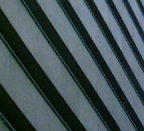
Evolved from Nothingness
September - December 2005, Utrecht, generated by socialfiction.org, hosted by impakt.nl: Hidden in the former utility area of a vacant 13 floor office in Utrecht, the Crystalpunk Workshop for Soft Architecture will evolve an empty room from nothingness into unknown states of technological enhancement. Unlike the alphabet that always knows where it is going, this workshop does not.
A Room of a Crystalpunk's Own: The Headmap manifesto, the Coleridgian masterpiece of independent software development for spaces and places, observed: "Every room has an accessible history, every place has emotional attachments you can open and save". New technologies can associate places with layers of free and editable content from which the past can be re-enacted, like a murder at the scene of the crime is re-enacted, to re-experience and stir vanished memories.
Little minds living in software can eat any piece of data, extract meaning from it and email it to you when the right criteria has been met. Our Crystalpunk Manifesto famously drew connections between disconnected fields of knowledge and explained to the world our intention to program minds and matter simultaneously. This workshop marshals these manifestos of inspiration into real practises with scars of happy absurdi(r)ty engraved on their souls.
Lexicon
Crystal: The inorganic strategies of the crystalpunk are both chemically and metaphorically informed by the lessons learned from the transformation from moleculline mayhem into crystalline order. Crystal growth is adaptive, particle-noise disrupts tessellation but the crystal works its way around it softly. Roomology as crystallography? The analogy with crystals finding form permeates every aspect of this workshop: the room is filled with latent possibility, the workshop seeds these powers laying dormant, what remains after 4 months is outward form pushed and moulded and beaten into shape by events and persons working inside the room with the material produced by their own every moves inside the room.
Punk: Despite appearances this workshop is not technology-driven but propelled forward by social interaction and a healthy disrespect for specialists of all kinds. Punk is not a style or a genre but a principle of self-education: taking up a technology (an electric guitar, a sensor, a programming language) ignoring all good practise, refusing to draw a line between student and teacher. Punks don't spend years practising: they immediately start a band with the intention to change the world.
Workshop: Knowledge is generated collectively, collectives generate their own special flavours of knowledge. This workshop creates a social situation by providing resources to those persons unknown curious enough to come round and actively encourage those people whose past work we like. Different interests, backgrounds, talents, skills will mix, seek alliances and run amok; rapidly the room enhanced starts to generate data, ad-hoc collaborations find challenging ways for this data to be interpreted. Within the workshop countless micro-workshops will focus on specific topics, introducing high-level ideas and technologies to the uninitiated or to keep everybody up to date on the workshop's output, helping each other to make sense of the magic properties of technology. This workshop is a sustained stream of consciousness you can wash your mind/sharpen your capabilities/empower your potential with.
Soft + Architecture: Buildings learn, rooms have memories, design does not need its designers, the language of time (piecemeal extensions, reinventions, rephrasings, accidents, entropy) rewrites their script. A room, by implication, refuses to be belittled into the function of a radio, it wants to be a broadcaster too. Continuous sending information to the world, a room can have a virtual identity and under this guise live a secret life. For instance: a crystalpunk moves his leg for comfort, a crystalpunk shakes her head in disagreement, sensors pick up on it, triggering a wide range of reactions known and unknown, local and faraway. To paraphrase Ezra Pound: in soft architecture each gesture creates content that has form as water poured into a vase has form. Content is recyclable, routed multiple times, finally ending up back where it initiated: causing a sound closing a door illuminating a cryxal on-screen. A crystalpunk walks through the room and, like in a crappy disco, the floor lights up underneath her feet, too bad he is not feeling very much like a dancing queen tonight. Soft Architecture is a home grown architectonic freak show: what the Elephant Man is to the Athletic Body, the Crystalpunk Room will be to the Smart House.
Now that we have found data, what are we going to do with it?!
Technologists have for decades been playing with the idea of the supposedly smart home: the entire house adaptive and responsive and proactive, providing conveniences like that resurfacing dystopian killer-app: the refrigerator that makes sure the milk never runs out. No matter how device-centric and profit-inspired these efforts are, and as such divided by a royal mile from the super-serendipity of Crystalpunk roomology, this workshop is moving in the same problem-space of obvious possibilities and unresolved puzzles of making sense from the surplus of automated data production. Everybody can generate a source of water by opening the tap, few are given to come up with conceptually stimulating ways to process the output.
On Being Soft
Knowledge, so it is said, is the agitator of economic growth, a good education the only insurance against unemployment. Self-education in this respect is a scrapyard challenge: without any experience you can master the use of a jet engine, but when announcing yourself at the job centre it will be back to washing plates or carrying big things if you know what I mean. But self-education is part not of the world of schools and jobs and financial solvency and mortgage opportunities, but an involuntary by-product of the personal creative urge of the kind that start with one innocent question: "what if....?".
What if I make a lot of noise?
From the small but liberating gesture of doing so, its miracle usually diminishing quickly, you may be inspired to find a way forward in a process easily labelled crystalline. Learning to control the machine that makes the noise proposes new questions that need further understanding to be answered. In a different context Sherry Turkle suggested that self-education is rooted in the curiosity in finding out if, by playing around with it, you can make things work for the sake of it. This way to deal with problems, she says, is at odds with the goal oriented alphabetic way of making things as taught at schools. This 'soft mastery' over problems relies in a very real sense on the fact that answers will come to you. A 'lazy' and very unprofessional approach, as you can never explain what you will do beforehand. The Crystalpunk Workshop for Soft Architecture is really entirely very splendidly softly unprofessional indeed.
On Participating
The Crystalpunk Workshop of Soft Architecture workshop lives in 2 distinct spheres: in the corner of a gigantic building in a tiny Dutch city and online where as much realtime roomness is broadcasted as possible. Participation is local, you are invited to bring your laptop and start making noise, to join a workshop or to come listen to a presentation. To those faraway we must mention that, apart from this workshop, there are very few reasons for visiting Utrecht and the more we admire you for doing so. From the deepest Africa you are encouraged to turn yourself into a soft architectonic bootlegger: to render on-line data into representations formal and fluid, in monotones or RGB, spatially exact or rolling like a wave. Or perhaps you are more philosophically inclined and prone to profound reflections, or perhaps breaking things only to rebuild them is the tea you drink: the social infrastructure will be in place to work and think along wherever you are.
We do not care if participants don't know anything useful, and likewise we will welcome you with as much enthusiasm if you do know something useful. We are not like an alphabet but we are neither a cheap bar: we do ask from our participants the desire to unwind their own what-if soft scenarios. If you only want free internet access Beelzebub will bite your head off and create content that has form as a main artery needing urgent medial attention has form.
For a workshop that wants to shake the language and experience of roomness, 4 months is little time, but like with every education, it is never finished A fact learned can reveal itself useful only years after. Come as you are: you can be crystalpunk too.
crystalpunk |at| socialfiction |dot| org
Posted by jo at 09:43 AM | Comments (0)
August 15, 2005
SUIRIN:
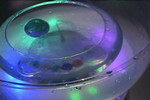
Computer-Augmented Healing
SUIRIN, by Satou Tokuhisa and Masa Inagake, is an installation that in a sense demonstrates how Augmented Reality technology could help people relieve stress. The device looks relatively simple at a glance – a container with water and floating glass balls called “ukidama.” Just play with the water and the balls, then you'll be rewarded by calming, ambient light, sound and smoke. You might eventually get immersed in the feedback-control loop that may make you forget about your stressful day.
The key of this installation is the sophisticated sound augmentation mechanism using four microphones, FFT-based sound processing, and four surround speakers. What you hear from the speakers is something similar to suzumushi (bell-ring cricket)'s sound. This auditory experience is enhanced by the lighting, smoke and tactual sensation.
This is what I would call an Iyashi-kei installation. Iyashi-kei is a Japanese word meaning “a genre related to healing.” This word is relatively new but now very popular and used to describe everything including music, films, things, places, and people. Electroplankton is an Iyashi-kei game, Jennifer Aniston is an Iyashi-kei actress, and so on.
Anyway, I shouldn't forget to mention that this installation was shown at SIGGRAPH2005! [blogged by manekineko on we-make-money-not]
Posted by jo at 12:30 PM | Comments (0)
Eavesdripping
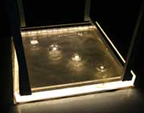
Rendering Communication Visible and Experienceable
Eavesdripping, by Sascha Pohflepp, uses water as medium and display to render invisible communication visible and experienceable. A matrix of magnetic nozzles opens a valve when current is applied. To add some controllability to the setup, a computer running MAX-MSP/Jitter processes information and connects to two relay-boards which are controlling the individual nozzles.
To increase the visibility of the splashes on the ground, the water surface sits in a container made of clear acrylic. From one side, light is being pumped in by an array of super-bright LEDs. Since the acrylic and also the surface of the water is subject to the effect of total reflection, the water stays perfectly black. However, when a drop of water breaks the surface, the light brightly lights up the spot.
Because the way of displaying is physically so present, it would be best to initially use it to visualize something and make it sensually experienceable which is equally present, but not perceptible. The metaphor of the installation would be to wash something from the air and make it visible on the ground in front of you. The idea of visualizing internet wireless conversations emerged. For achieving this, the packages were successfully "sniffed" from the air, parsed to readable text, processed for being output in the form of drops and then displayed on the ground for everyone to read. Video. See also Erez Kikin-Gil's Water Play. [blogged by Regine on we-make-money-not]
Posted by jo at 12:24 PM | Comments (0)
Roomology

Rooms as Psychogeodynamic Objects
Drinking whiskey laced with vodka can not not produce drunkenness: a room first entered evokes in you an immediate involuntary mental sensation. The human mind senses environments by instinct, scans and evaluates them for properties like ambience, lines of sight and darkness. The horror genre, invented by the partisan architect Horace Walpole, thrived on the discovery that rooms can scare you to death. The grassroots study to this little understood effects of space on mind that transpires through everything humans undertake, as after all you are always somewhere, is called psychogeography.
Psychogeodynamic objects are defined as those blurry-edged entities from which strong psychogeographic 'rays' emanate. The history of landscape representation is one overflowing with anecdotes about the psychogeodynamic demanding its reproduction by the overwhelmed artist or snapshoteer. Roomology, the subdomain of psychogeography that studies rooms as psychogeodynamic objects, can retrace a similar but more covert tradition of artistic studies and observations about the ways rooms and minds work together.
The Gothic Cathedrals are an obvious example of the fact that long before the word psychogeography was invented the thereby described effects were recognised and consciously manipulated to achieve psychological patterns in its spectators. The solitary confinement/sensory deprivation tactic used by certain regimes to put pressure on prisoners is another example of psychogeodynamic engineering in need of urgent analysis from psychogeographic angle.
On a more common level, rooms are ideal environments for the psychogeographers scrutiny because most people have one, and most of them have very precise and immutable ideas of the how their room should look, or to be more precise: should 'feel' like. The vagueness of expression shows the elusiveness of the stuff psychogeographers try to deal with and what makes it the rocket science of poetry.
Roomology and art have a long intertwined history. In her essay "A Room of One's Own", Virgina Woolf explained to woman aspiring to become writers that securing a room for themselves was the one prerequisite they could not do without. Lee 'scratch' Perry's Jamaican studio was called the Ark for a reason. Pictures shows its with leaflets, gear and memorabilia overcrowded walls: conveying the room as a sacramental shrine channelling the bogeyman away from his head and into the record. Perry eventually burnt the Ark down.
The mind-room feedback loop (a psychogeonic system if you like) creates a stream of consciousness that makes it impossible to separate interior design from creative production. Every change in the room indicates/creates/reinforces in many different ways, impossible to untangle, some mental change. The Yellow Room by Vincent van Gogh, the famous painting of his room in Arles with the furniture frenzied by absinthian voodoo, is ample evidence of the fact that artists and rooms are an unbreakable psychological tandem. When Andre Breton during the second world room had to vacate his room, his production faltered dramatically because of it.
Our rooms are part of our intelligence. From notebooks, biographies, diaries and other sources we can analyse the roomologic faculty in others, constant monitoring of our own room-sized spaceship as part of the self is another way to go. Related: The Taxonomy of my Room
Posted by jo at 11:56 AM | Comments (0)
This Spartan Life
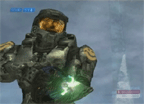
A Talk Show in Game Space
This Spartan Life's Damian Lacedaemion is not your average talk show host. He lives inside an online game where daily existence is a struggle against overwhelming odds (and other, much better players). So he has taken it upon himself to create a little oasis of sanity where he can talk to people who aren't bent on his destruction. He invites guests to join him in a live game where he can walk about and discuss some of the finer aspects of life, music, art, sex, movies and yes, even games.
But he is finding it easier said than done. When other gamers join the game and don't know they shouldn't be shooting at his guests, Damian is sadly forced to revert to his old lethal self and clear the map of these brutes with their curt utterances and barbaric tactics. But once the fighting is done and the guests are blue in the face, the fine Solid Gold Elite Dancers are there to shake their avatars to the latest chiptune music.
Posted by jo at 07:33 AM | Comments (0)
August 13, 2005
KISSS
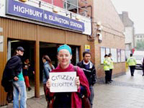
The Kinship International Strategy on Surveillance and Suppression
Are you seeing what we're thinking? The Kinship International Strategy on Surveillance and Suppression | KISSS is a series of performance events and interventions addressing surveillance and suppression.
KISSS is happening at an important moment. In the current political and social climate, surveillance has become an accepted and unquestionable part of everyday public life. Suppression of behaviour, information and desire occurs both privately and publicly. What is the relationship between surveillance and suppression? Consequence or reason for? How do issues of surveillance and suppression affect the work we make as artists and the way in which we work? How can we as artists, living in different countries, engaging in multi-platform possibilities and utlising varied perspectives, respond to these issues in a cohesive and powerful way?
A KISSS Policy Briefing will be held on August 19, 2005 at Elastic residence from 1500 to 1800.
This is an opportunity to meet the team, see work in progress and find out more about KISSS and how you can contribute and be involved. If you are interested in proposing a performance or contributing work, please come prepared to discuss it with a member of the team.
For further information on some of the strategies identified for KISSS visit:
http://www.elastic.org.uk/KISSS/strategies
KISSS Policy Briefing will take place at: Elastic residence, 22 Parfett St, Whitechapel / Aldgate East t: 0207 247 1375 e: kisss[at]elastic.org.uk
KISSS is supported by the University of Wales, Resonance 104.4FM and Concial Gallery, Australia.
Posted by jo at 10:15 AM | Comments (0)
DOUBLE VISION:
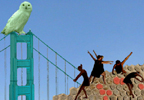
Evolutionary Patterns and the Lonely Owl
Bay Area intermedia performance group DOUBLE VISION is presenting a new work combining elements of dance, music, video, and installation in an immersive evening of cellular struggle, oscillating flesh and digital drama. Adapted from John Conway’s Game of Life, performers and technology dynamically respond to one another creating unusual and sometimes beautiful patterns within the vast gallery space of WORKS/San José.
Cast of performers include: Liz Bootz, Sean Clute, Amanda Crawford, Dorsey Dunn, Dave Holton, Marielle Jakobsons, Pauline Jennings, Jason B Jones, Amy Leonards, Amy Nielson, Sonia Reiter, Isabelle Sjahsam, Max Stoffregen, Agnes Szelag, Bill Wolter and Nicole Zvarik.
DOUBLE VISION is a collective of performers, musicians, dancers, video-artists, and technology aficionados. Together, the group creates events and immersive environments utilizing unconventional spaces or transforms conventional spaces through unconventional means. One of their primary objectives is creating links between the physical world and digital worlds using computers, sensors, networks and custom-designed software interfaces.
When: September 24 [Sat] 8PM
Cost: 8-10$
Where: WORKS/San José, 30 North 3rd St, San José, California
510-535-2504
Posted by jo at 10:03 AM | Comments (0)
CALL FOR PARTICIPATION ISEA2006

TRANSVERGENCE
This is an invitation by the ISEA2006 TRANSVERGENCE Symposium and ZeroOne San Jose: A Global Festival of Art on the Edge to groups and individuals to submit proposals for exhibition of interactive art work and projects reflecting on the thematic of the transvergence.
Creative interplay of disciplines to catalyze artistic, scientific, and social innovation is evidenced by decades of multi-/ pluri-, inter-, and trans-disciplinary discourse and practice. Emphasis on the dynamics subtending this interplay has led to the notion of transvergence, a term coined by Marcos Novak which overrides discipline-bound issues and demands, and serves as the focus of the present call. Proposals are sought that address but are not limited to themes outlined below, challenging the boundaries of disciplines and conventional (art) institutional discourse, and indicating creative strategies for overriding them. Proposals may consist of art projects, residencies, workshops, standalone conference papers, or group conference sessions.
"While convergence and divergence are allied to epistemologies of continuity, transvergence is epistemologically closer to logics of incompleteness, to complexity, chaos, and catastrophe theories, dynamical systems, emergence, and artificial life. While convergence and divergence contain the hidden assumption that the true, in either a cultural or an objective sense, is a continuous land-mass, transvergence recognizes true statements to be islands in an alien archipelago, sometimes only accessible by leaps, flights, and voyages on vessels of artifice.
"Central to transvergence is speciation. We want to draw proposals that constitute new species of effort and expression and that both enact and reflect on our construction of new species of cultural reality -- not by being merely novel mutations within known areas, but by boldly challenging known areas and yet being potentially viable to the point of becoming autonomous entities -- not dancing about architecture or architecture about dancing, for instance, but dancing architecture... or, better still, something else, as yet alien and unnamable, but alive and growing."--Marcos Novak
ORGANIZATIONAL MODELS OFFERINGSETTINGS FOR TRANSVERGENCE
Transvergence is conditioned by exodus and invention. New idioms of expression do not happen in isolation. Although creativity is a resource that works best when shared, there is no clear form of revenue or infrastructure for the practices of collaboration that characterize transvergence. Collaboration in this context does not arise from democratically disseminated, proportionally allocated property, but from the permanent re-appropriation of shared resources, and resultant re-territorialization of production, creation and artefacts. The models of the think-tank, media lab and research centre have shown their limits since the 80s and 90s, as have tactical media activism tied to the logic of events, and NGOs facing the donor system's arduous accountability requirements; university research is often encumbered by best-practice driven managerial culture, and "creative industries" clusters are subject to economies of scale and uneven divisions of labour. As a technics of expression immanent to media of communication, transvergence requires settings that instantiate structures of possibility. Such settings might derive from models offered by ecologies, fields and membranes, and from the emergent institutional forms of organized networks, whose constant configuring of relations between actors, information, practices, interests and socio-technical systems corresponds to the logic of transvergence.
ISEA seeks new visions of organizational and participatory models as structures of possibility for transvergent practice.
TRANSVERGENT ETHICS AND REDEFINTIONS OF ART
Institutions which purportedly back new art practices are not always the bravest when it comes to work which challenges basic assumptions about what art is, what the artist is, what the relationship between artwork and audience might be, and what the outcome of an artwork might be. Counter intuitively, business corporations can be much quicker to support radically new ways for artist, artwork and audience to speak to each other: every time a viewer/player engages with an interactive creation, a kind of commerce occurs - a series of transactions, a litany of offers and purchases. Similarly, organizations devoted to healthcare, social well-being and political activism may more readily recognize exchanges that privilege the contingent yet compelling "we", and the urgency of the encounter. Art and cultural institutions remain reluctant to take on these new forms because they destabilize old views of the artist as a person making a proposition about the world and of the audience as consumer/ interpreter of this proposition, whereas transvergent work instates audiences as key f/actors in communication processes. This implies a shift in – but not necessary the demise of - the artist's role, and a change in the nature of artworks, formulated as public experiments raising questions as much to do with ethics, as with aesthetics and poetics.
ISEA encourages proposals querying the role and relevance of art in public arenas that are being redefined by interactive, inclusive ambitions and tools.
BIO-TECH-BIOINFO-BIOART-ECOART
Over the past 20 years, biotechnology has revolutionized the pharmaceutical and agricultural industries, and the fields of animal and human medicine. Biotechnology implementations direct areas such as food production and consumption, global trade agreements, human and animal reproduction, environmental concerns as well as biosecurity and biodefense. The Human Genome Project and stem cell research have stimulated the merging of computational research with areas of the life sciences. Disciplines such as bioinformatics and ecoinformatics currently enjoy broad public attention and funding. Although artists have long been engaged with depictions of "nature", BioArt, which includes the use of biological matters as part of artistic production and context creation, and EcoArt, where artists attempt to influence the ecologies in which we live, are relatively young areas demanding new exploratory and creative strategies.
ISEA is interested in projects engaging with the materials and broader ecology of life sciences, rather than simply their symbolic representation.
TECHNOZOOSEMIOTICS AS AN EPISTEMOLOGICAL PLATFORM & PLAYGROUND
Technozoosemiotics is the study of signs elaborated by all natural or artificial living species to communicate in intra- or extra-specific ways (zoe = life). Humans and their more-or-less intelligent artefacts ignore the quality and singularity of information elaborated and emitted through the myriad channels and networks which traverse terrestrial, celestial, marine and intergalactic spaces. As art forms migrate from institutional sanctuaries to other areas of experience – the everyday, public, intimate/private, the biosphere, the universe – they must tune to the diverse communications that animate the technozoosphere. This means inventing interfaces that favour interactions of like and unlike kinds of intelligence, and emergence of new species of conversational agents. It means creating epistemological platforms and playgrounds for the transduction and translation of codes that open up novel ways of thinking and domains of knowledge.
ISEA is soliciting art that extends beyond human-centred design, to questions of living systems and new species of cultural reality.
TRANSVERGENCE CALL COMMITTEE:
Chair, Sally Jane Norman, Louis Bec, Andy Cameron, Beatriz da Costa, Bojana Kunst, Maja Kuzmanovic, Anne Nigten, Marcos Novak, Ned Rossiter.
Timeframe:
Announcement August 1, 2005
Submissions due October 3, 2005
Jurying due December 1, 2005
Accepted proposals announced December 15, 2005
http://isea2006.sjsu.edu/transvergence/index.html
If you have questions contact transvergence[at]yproductions.com
Sign up for the ISEA2006 mailing list: http://cadre.sjsu.edu/mailman/listinfo/isea2006
Steve Dietz
Director, ZeroOne: The Network
Director, ISEA2006 Symposium +
ZeroOne San Jose: A Global Festival of Art on the Edge
http://isea2006.sjsu.edu : August 5-13, 2006
stevedietz[at]yproductions[dot]com
http://isea2006.sjsu.edu/index.html
Posted by jo at 09:12 AM | Comments (0)
The Handydandy
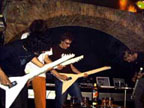
Rocking the stage with mobile phones
The Handydandy consists of five media artists from Austria (Bauch Bernhard, Gross Luc, Kirisits Nicolaj, Savicic Gordan, Waldner Florian) using their mobile phones as musical instruments. The mobile phones are used only as interfaces and they are connected, via Bluetooth, to a computer network.
"The entire instrument played by the musicians, is thus divided into the mobile phones, the Bluetooth connections and the laptops acting together over WLan. Thereby different Feedback systems on social and digital level, which are used for the compositions, develop. The selection of this configuration makes possible to use not only the movement in space as temporally akusmatic category but also to connect the powerful aesthetics of a Rock performance with the intellectual requirement of the electronic music. The Handydandy is at the same time a RocknRollband and a computer network - music group." Video. [blogged by Regine on we-make-money-not]
Posted by jo at 08:54 AM | Comments (0)
HARVESTWORKS

ARTIST IN RESIDENCE PROGRAM: New Works
The Harvestworks Artist In Residence Program offers commissions of up to $4000 to make a new work in our state of the art digital media facility. Each artist receives a $700 fee with the balance of the award posted in a' "facilities account" which is used to manage and produce the work. The artist works with a team comprised of a project manager, engineer and programmer (if required). Work produced in the program is premiered in the Harvestworks' 5.1 Presentation Lab. Residents are also included in Creative Contact, an Internet compilation of digital art work on the Harvestworks website. Deadline: Tuesday, November 1, 2005.
New works may include the creation of a new video work with a surround sound audio mix, audio recording and mastering of a surround sound piece, the creation of a new web art work and the development of a live interactive music/video/installation system using Max/MSP/Jitter.
Up to 12 residencies will be selected (depending on project size and funding) along with two alternates in the event any resident artist cannot participate. Priority will be given to the creative use of the Harvestworks' production facility and the innovative use of sound and/or picture. Emerging artists and artists of color are encouraged to apply.
How to apply: Instructions on how to apply and application forms can be found online. Application seminars may be held in late September to assist artists in the development of their projects. Check our website for dates and times.
Questions: Questions can be directed to Hans Tammen at 212.431.1130 ext. 13 or by email at hanst[at]harvestworks.org.
Harvestworks Inc. is a non-profit arts center in Lower Manhattan. Funding for our programs has been provided by the New York State Council on the Arts, the National Endowment for the Arts, the NYC Dept. of Cultural Affairs, LMCC/ADNY, the Booth Ferris Foundation, the Mary Flagler Cary Charitable Trust, the James E. Robison Foundation, the Aaron Copland Fund, the Greenwall Foundation, the Andy Warhol Foundation for the Visual Arts, the Jerome Foundation in celebration of the Jerome Hill Centennial, the Rockefeller Foundation, Foundation for Contemporary Performance Arts, the Experimental TV Center and mediaThe foundation inc. Additional support by Tekserve, Digidesign, Inc., NHT Pro, Waves, Propellerhead, Ableton, MOTU, Universal Audio, Antares.
Carol Parkinson
Director
Harvestworks, Digital Media Arts Center
596 Broadway Suite 602 NYC 10012
212-431-1130 x 12
Posted by jo at 08:34 AM | Comments (0)
August 12, 2005
If I Can’t Dance – I Don’t Want To Be Part Of Your Revolution
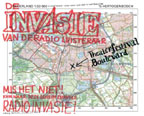
Performative Thinking and Practice as Understood Today
If I Can’t Dance, I Don’t Want To Be Part Of Your Revolution--curated by Frederique Bergholtz, Annie Fletcher and Tanja Elstgeestis--is a visual art project which travels throughout 2005 in different forms from Utrecht (Festival a/d Werf), to ‘s-Hertogenbosch (Theaterfestival Boulevard) and Leiden (de VeenFabriek).
"If I Can’t Dance – I Don’t Want To Be Part Of Your Revolution" takes as its point of departure this famous quote of Emma Goldman (b. Lithuania 1869). By using Goldman’s exclamation as a title for our programme, we contend that art has the power to position it self politically, determinedly and critically in the world, but also to be celebratory. Performativity contests the notion that the self is stable or separable from the context within which we operate. Identifying this heightened awareness is perhaps a way of analysing or even contesting the conditions in which we live. If I Can’t Dance… asks artists to engage with both the legacy and continuing importance of performative thinking and practice as understood today.
The Structure: We intend to use the vitality and event-based context of these festival platforms to explore the legacy and on-going developments of performativity as a rich philosophical trajectory through which to produce contemporary art practice. This is perhaps particularly appropriate within a theatre festival, where the whole dynamic of performance as a conscious act can be directly contrasted to the more subtle and critical sense of the performative, which also occurs in non- prescriptive and unconscious ways.
The Programme: At Theatrefestival Bouelvard we launch the second phase of If I Can’t Dance... This August we will present the latest developments in the performances and on-going projects of these five international artists namely; Johanna Billing - You Don’t Love Me Yet, Matti Braun - The Alien, Gerard Byrne, 1984 and Beyond, Yael Davids - End On Mouth, Ligna -Invasion of the Radio Listeners. By working with people and places in ’s-Hertogenbosch, we directly relate ourselves via the arts with the existing (artistic) structures of the city. With the piece of Johanna Billing the local music scene is presented. The group Ligna examine the functioning of the social and public space in the city through the medium of radio. Both Yael Davids and Gerard Byrne generate live performances, which explore the apparatus of theatre and notions of acting in very specific locations in and around the city. The project of Matti Braun exists of a series of staged present ations that together form part of his new project. The context of the festival gives us the opportunity to programme in a concentrated way for five intensive days, each day is defined by the work of one artist. Further, a documentation centre will be installed at the artists’ initiative space Artis dealing with the developments, ideas and the research during the development of these project from when we began in Utrecht last May until now.
If I Can’t Dance, I Don’t Want To Be Part Of Your Revolution - the publication documenting the ideas and work developed during this three-stage project is forthcoming in March 2006.
For further information see:
http://www.ificantdance.org / http://www.festivalboulevard.nl
Or call 00 31 73 613 7671 for reservations and information
Phone lines open daily from 15.00
The project is generously supported by Mondriaan Foundation and the Netherlands Foundation for Visual arts Design and Architecture. Theatrefestival Boulevard is structurally subsided by the Ministry the Province of Noord Brabant and the municipality of S-Hertogenbosch
Posted by jo at 04:03 PM | Comments (0)
HINGES ON
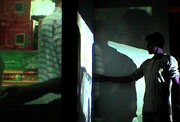
Adaptation, Access, Regulation, Open Source
HINGES ON is an interactive film installation on the informal and formal economies of India's "ICT capital", Bangalore. Visitors enter through a sparsly lit sound tunnel, where they are exposed to an audio experience of failed efforts to retrieve information. (The sound works can be downloaded from the site.) Finally, one is released into the room hosting the video installation. Multiple door-shaped screens in the centre of the space serve as projection surfaces for the four simultanous projections. The screens are on hinges and invite the visitors to turn them into the angel required to catch the projection they wish to watch. (You can find information on the themes and issues in the backdrop section). A switch board provides the interface to the speakers featured on video. (In depth documentation of the process including a list of interviewees and the 'making of switch board, doors and software patches is accessible here!'
HINGES ON at Ars Electronica, opening September 1, 2005, 15:30, Campus / Kunstuniversität Linz. The work was realized by ambientTV.NET during the Tactical Media Lab at Srishti School of Art, Design and Technology, Bangalore, India; with Thomas Abraham, Salam Hidish Singh, Ishan Ghosh, Nishita Kavadia, Siddharth Muthyala, K.T.Thomas, Pratima Kalmadi, Divya Viswanathan, Umang Razdan Bhattacharrya, Ramyah Gowrishankar, and Priyanka Dilip. Lab led by Manu Luksch and Mukul Patel.
Posted by jo at 09:19 AM | Comments (0)
Phones Make Korea a Silent Society
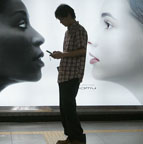
Living Without Saying a Word All Day
"The mobile phone bill of college student Oh Su-hyeon (21) for the month of July lists 648 text messages and four hours and 55 minutes of talk -- an average of 21.6 text message a day and an average nine minutes and eight seconds of conversation. ”I used to spend about two hours on the phone every day, but now I send text messages. All you need to do is state your business, there's nothing superfluous and it's convenient." [...]
If in an age of near-ubiquitous communication people have become paradoxically quiet, it is because means of communication that replace the spoken word, like chat programs and text messengers, are cheap, convenient to use and accessible everywhere. There are people who say they could live comfortably without saying a word all day, and who send so many SMS and chat online so much that sometimes they find it awkward to talk. Yet it is the telephone that is at the heart of these changes, a device that is rooted more than anything else in the attempt to allow people to talk. [...]
Cell phones with GPS navigation systems have also created a world where no one needs to ask directions, and DMS systems allowing people to watch TV on their phones have replaced gossip as a way to kill time. But the changes are taking place elsewhere too. Manned subway ticket booths are being visited by much fewer people. Cho Dong-hwan, the manager of Gwanghwamun Station on subway Line 5, says of the 28,000 passengers who use Gwanghwamun Station daily, over 80 percent use transport cards. ”The overwhelming majority of passengers using the ticket window are asking for senior citizen tickets.“
There are concerns that the silent society could aggravate alienation and isolation. But experts say there is no need to expect the worst: it is merely that communication is changing, from face-to-face to other forms, yet the flood of communication itself has not stopped. [...]
Yonsei University sociologist Kim Ho-gi says young-generation ”cool“ means a preference for writing over speech. ”Speech is loaded with feeling, and because young people prefer communication styles that convey meaning simply and clearly while keeping their own emotions in check, they like communicating through text messages." Link [via ratchet up]
Posted by jo at 09:09 AM | Comments (0)
Orchestra of Anxiety

The Concept of Security
In Orchestra of Anxiety, London-based artists Manu Luksch and Mukul Patel expand their ongoing explorations of the concept of security. While 'security' can be seen as desire, as ideology, as illusion but never as a guaranteed status quo, socio-political measures of control, ... have been implemented in the name of security. The security industry is one of the fastest growing sectors this decade, and is worth hundreds of billions of dollars annually. A participative installation piece--to be shown at Watermans Gallery--Orchestra of Anxiety deploys security and surveillance technologies in an unusual and playful context, prompting visitors to reflect on their personal sense of security and their relationship with public fears (of petty crime, terrorism, etc.).
The central focus of the installation at Watermans is a harp, traditionally regarded as a sacred or metaphysical instrument associated with tranquillity, love and goodness. However ambientTV.net’s harp differs from standard harps as it is strung with razor wire, requiring the harpist to wear protective gloves while playing. The protective gloves complete data circuits when a string is touched, triggering multiple projections and sound sources in the gallery. Before playing, the harpist must first overcome the instinctive anxiety the instrument provokes.
Orchestra of Anxiety is produced by inter-disciplinary arts production company ambientTV.NET. ambientTV.NET highlights models of networked and collaborative practice. Techniques and effects of data transmission provide theme, medium and performative space for works spanning installation, performance, documentary, dance, gastronomy, and live sound and video art. Much of the film and music production is freely disseminated through the website.
Posted by jo at 08:45 AM | Comments (0)
ASK THE ROBOT:
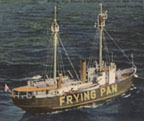
CELEBRATE MECHANIZED LABOR DAY: CALL FOR PARTICIPATION
An Official Robot Holiday to be Celebrated on the THE FRYING PAN: Pier 63 North River, NYC; 12th Ave, Between 22ND & 23RD; Wednesday, August 31, 2005.
ROBOT: derived from Czech robota, "servitude, forced labor," from rab, "slave." Czech robota is also similar to another German derivative of this root, namely Arbeit, "work" (its Middle High German form arabeit is even more like the Czech word). Arbeit may be descended from a word that meant “slave labor,” and later generalized to just "labor." (www.answers.com)
ASK THE ROBOT is a platform that gives artists working within and across different media a chance to present their work on an open stage. Whether you use your body, your voice, or strange technical gadgets to perform – all analog, digital and just plain human media are welcome!
A CALL TO ALL WHO LABOR to create
PERFORMANCES
VIDEOS
INSTALLATIONS
and WRITTEN PIECES
that shed light on the mechanics of being human.
submission deadline: August 25
PLEASE FORWARD TO FELLOW LABORERS!
submission guidelines:
Live Acts: 3-12 minutes long... email a link to a sample of your work to ophra@pursuethepulse.org (if it is available online) or send a short video/audio sample to: Pursue the Pulse, 369 St. John’s Pl #15, Brooklyn, NY 11238
Videos: are being curated by Kelly Shindler. Please direct all video submissions to Kelly by either sending a link to an online version of the movie with the subject heading 'Ask the Robot submission' to kmshindler@earthlink.net (no large attachments please!), or mail a CDR or data DVD to 191 Court St #3R, Brooklyn, NY 11201
Installations: email a clear description of what you intend to do to ophra@pursuethepulse.org, including how much space and set up time is required, and photos of the work if available. Site specific installations are especially welcome!
Written Work: email the document to ophra as a pdf or word attachment.
brought to you by Pursue the Pulse.
Posted by jo at 08:17 AM | Comments (0)
August 11, 2005
YUCEF MERHI
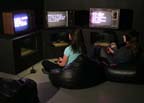
Poetic Engineering
Poetic Engineering: Poetry and electronic media merge in this solo exhibition of works by new-media artist Yucef Merhi. An artist, poet, and programmer, Merhi engages electronic devices-computers, video games systems, and other machines-in the presentation of his written words. The resulting artworks expand the limitations of language and the traditional context of poetry, proposing a bold new role for the poet in our culture.
By the time Merhi began writing poetry at the age of ten, he was already familiar with the languages of computer programming and had become highly skilled at manipulating computers and other complex machines. Since then, much of his artistic practice has involved exploring what he describes as "the bond between natural languages (English, Spanish, Hebrew, etc.) and programming languages (Basic, C, Java, Assembler, etc.)." Through works that explore the connections between technology and language, Merhi presents new ways of experiencing poetry and, in turn, proposes a more humanistic view of technological advances.
Poetic Engineering is organized by the Orange County Museum of Art and curated by Irene Hofmann, Curator of Contemporary Art. Through August 28, 2005
ORANGE LOUNGE,
a New Media Satellite
of the Orange County Museum of Art
South Coast Plaza
3333 Bear Street # 303
Costa Mesa, CA 92626
949-759-1122 X272
http://www.ocma.net/orangelounge
Artist-in-Residence
In conjunction with Poetic Engineering, Merhi will be in residence during the month of August conducting a series of intensive teen workshops. Working with Orange County high-school students, he will engage participants in an exploration of poetry and new media and will involve the students in the art-making process.
About the Orange Lounge
The Orange County Museum of Art ‘s Orange Lounge at South Coast Plaza, is the first museum space on the West Coast to regularly present digital art and video and the only space of its kind in the United States located in a major retail complex.
The Orange Lounge presents solo and group exhibitions and special events featuring artist demonstrations, performances, and discussions that investigate the impact of digital media on contemporary visual culture. From real-time computer-generated moving images, to room-sized video installations, to artworks based strictly on the Web, the Orange Lounge is a dynamic site for exploring and interacting with new media art. Catalogues, CDs and other products related to video and new media are available in the Orange Lounge.
Exhibition Sponsors
The Orange Lounge design and construction was funded by the Segerstrom Foundation. Major support for Orange Lounge programs is provided by The James Irvine Foundation and technical support is provided by Integrated Media Systems.
Photo credit: Christopher Bliss
Press contact: Kirsten Schmidt, kschmidt@ocma.net
Posted by jo at 04:04 PM | Comments (0)
PERFORMA05
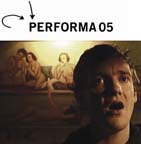
First Biennial of New Visual Art Performance in NYC
PERFORMA, the nonprofit organization committed to new visual art performance, is pleased to announce PERFORMA05, the first biennial of new visual art performance in New York City. More than 20 venues throughout New York will present a multidisciplinary program of live visual art performances, exhibitions, film screenings, and lectures from November 3 through 21, 2005. Ten major new works will be premiered and more than 60 artists will participate in the three-week program. PERFORMA05 is organized under the artistic direction of its founder RoseLee Goldberg.
Programming Highlights
To launch PERFORMA05, Danish artist Jesper Just will premiere his first multimedia live performance at Stephan Weiss Studio, with The Finnish Screaming Men’s Choir and 3-D set design by VISION4. Visual artist and composer Christian Marclay will present a moving image musical score interpreted by live musicians at Eyebeam. The Music of Regret, a movie by Laurie Simmons, will incorporate puppetry, and elements of musical theater in three tales of regret at Salon 94. “24-hour Incidental,” a performance program at the Swiss Institute – Contemporary Art will feature works by ten artists, including Peter Coffin, Jason Dodge, and Karl Holmquist. Anthology Film Archives will present live performances by Ei Arakawa, Jutta Koether, Emily Sundblad/ Reena Spauldings, and the world-premiere of a film retrospective on Bas Jan Ader. Art in General will exhibit a three-channel video installation by Sharon Hayes documenting five imaginary protests throughout New York City. Art P roduction Fund will present Free Play—a public jukebox interactive artwork by Christian Holstad. Other participating artists include Tamy Ben-Tor, Coco Fusco, Pablo Helguera, Paul D. Miller, Michael Smith, Sislej Xhafa, among many others.
WPS1.org is the Internet radio sponsor of the biennial and will feature live recordings and interviews, while PERFORMA RADIO will expand the field of performance into radio space with new projects by artists in the Biennial broadcast on FM radio. LISTEN UP! Lectures as Performances at The Kitchen, is a series highlighting artists who use the formal lecture as an art form. PERFORMA05 will also introduce the next segment of NOT FOR SALE: Writing about Performance and New Media at New York University, a symposia on the art of writing about multimedia and performance art, which will include Katy Siegel, John Rockwell, and Philippe Vergne, among other leading artists, curators and critics.
PERFORMA05 is organized in collaboration with some of New York City’s leading museums, arts organizations, galleries, and independent curators, including Anthology Film Archives, apexart, Art In General, Artists Space, Eyebeam, The Kitchen, Lower Manhattan Cultural Council, New York University, Participant, Inc., Swiss Institute – Contemporary Art, and White Box. Participating galleries include Leo Koenig Inc., Paula Cooper Gallery, Salon 94, and Yvon Lambert.
Concurrently with PERFORMA05, the Solomon R. Guggenheim Museum presents Marina Abramovic: Seven Easy Pieces, seven consecutive nights of performances in the museum’s rotunda from November 9 through 15. The works include a new piece by Abramovic created specifically for this project, as well as her renditions of seminal performances by Vito Acconci, Joseph Beuys, VALIE EXPORT, Bruce Nauman, and Gina Pane.
About PERFORMA
Established in April 2004 by art historian, critic, and curator RoseLee Goldberg, PERFORMA is a nonprofit interdisciplinary arts organization committed to the research, development, and presentation of performance by visual artists from around the world. PERFORMA will commission new performance projects in visual arts, establish a dedicated performance biennial, and provide year-round educational programming for this critical area of visual art and cultural history.
A full program of events will be available online at http://www.performa-arts.org in September 2005.
Media Contact
Blue Medium, Inc.
T: (212) 675-1800
F: (212) 675-1855
E: info@bluemedium.com
Posted by jo at 12:09 PM | Comments (0)
INTERACTIVA 05
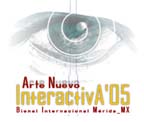
THE POSTCOLONIAL DILEMMA OF INTEGRATION VS. OPPOSITION
"Western thought is a particular metanarrative that has been heavily criticized by postcolonialism. Technology is considered by many an extension of Western thought and something that must be resisted or at least be critical of. This is the case with Balanquet. He considered InteractivA 05 a space where people could move towards a "post-technological" period, when the fetish for the machine would no longer exist, and the current models would be no more.[5] In his curatorial statement he contextualizes all of the participants as struggling with the inequalities that emerging technologies bring about in particular localities.[6] Balanquet's position actually resonated in every presentation, given that he would introduce everyone. Like most curators, Balanquet has a vision, an agenda that came into conflict with some of the works that he selected." From INTERACTIVA 05: THE POSTCOLONIAL DILEMMA OF INTEGRATION VS. OPPOSITION by Eduardo Navas, Net Art Review.
Posted by newradio at 09:59 AM | Comments (0)
August 10, 2005
Skin Control
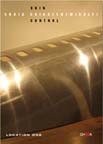
Everyday Drama Enacted Moment by Moment
"My goal as an artist is to understand and intervene into the production of material power and technologies. My day job as MIT professor involves doing that at a very literal level. "Skin" and "Control" do this at a more symbolic level, in the form of installations that operate as immersive environments, walk-in tableaux with everyday drama being enacted moment by moment." –Chris Csikszentmihályi
On Skin Control by Chris Csikszentmihályi--shown at Location One--Csikszentmihályi is conceptual and scalar ambitions locate him within a specific generation that has its own characteristic forms of artistic practice. For artists coming of age since the 1980s, (Damien Hirst, Matthew Ritchie, and Anselm Kiefer come to mind), science and technology are not truth as much as culture they form the mythic structures of our time. –Caroline Jones
What Csikszentmihályi offers is a way of visualizing a certain kind of power at work in the world. The power of control, of telemetry, of the ways and means of speed. It is a surprisingly abstract art. –McKenzie Wark.
Posted by jo at 10:44 AM | Comments (0)
Personal, Portable, Pedestrian:
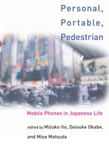
Mobile Phones in Japanese Life
The Japanese term for mobile phone, keitai (roughly translated as "something you carry with you"), evokes not technical capability or freedom of movement but intimacy and portability, defining a personal accessory that allows constant social connection. Japan's enthusiastic engagement with mobile technology has become -- along with anime, manga, and sushi -- part of its trendsetting popular culture. Personal, Portable, Pedestrian, the first book-length English-language treatment of mobile communication use in Japan, covers the transformation of keitai from business tool to personal device for communication and play.
The essays in this groundbreaking collection document the emergence, incorporation, and domestication of mobile communications in a wide range of social practices and institutions. The book first considers the social, cultural, and historical context of keitai development, including its beginnings in youth pager use in the early 1990s.
It then discusses the virtually seamless integration of keitai use into everyday life, contrasting it to the more escapist character of Internet use on the PC. Other essays suggest that the use of mobile communication reinforces ties between close friends and family, producing "tele-cocooning" by tight-knit social groups. The book also discusses mobile phone manners and examines keitai use by copier technicians, multitasking housewives, and school children. Personal, Portable, Pedestrian describes a mobile universe in which networked relations are a pervasive and persistent fixture of everyday life.
About the Author: Mizuko Ito is Research Scientist at the Annenberg Center for Communication, University of Southern California, Los Angeles. Daisuke Okabe is Lecturer at the Graduate School of Media and Governance, Keio University, Shonan Fujisawa Campus, Japan. Misa Matsuda is Assistant Professor of Sociology at Chuo University, Tokyo. Mimi posted a draft of the intro chapter as well as the table of contents [via apophenia]
Posted by jo at 09:45 AM | Comments (0)
Netznetz
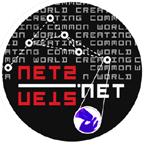
Encouraging Project-Based Collaborations
Vienna net.art community to distribute its own grants using social software Former BB guestblogger Johannes Grenzfurthner reports on an unusual development in how the Vienna government funds net.art/culture projects. The Commissioner For The Arts, a member of Vienna's Social Democratic Party, is supporting a consortium of more than 100 net.art groups, called Netznetz, in the development of a reputation-based software system that the group will then use to help decide how to distribute the grant money it receives from the government. From Johannes's post at the monochrom blog:
The new funding system strives for guaranteed and dispersed distribution of funding in the sector while the parameters of the distribution are meant to remain flexible, providing a dynamic scope. The aim is to encourage project-based collaborations by distributing various smaller grants. Therefore, everybody who is involved in the sector is subject to the principle of permanent reconfiguration of the system and the network...
The beneficiaries of the so-called 'network grants', a yearly spending account for approximately 20 groups, is to be evaluated with the aid of a social software tool -- a reputation system currently under development. Even before it has been coded, criticism as well as scepticism and fear start pouring into the media sphere. While even computer veterans criticise the alleged blind trust in a 'computer program', so-called left circles brand it as 'too neo-liberal' as the structure strives for 'collaboration instead of institution'.
netznetz is preparing a protoype in the course of a programming 'sprint' this week and is inviting international experts for an upcoming symposium in autumn 2005 in Vienna. [posted by David Pescovitz on boingboing]
Posted by jo at 09:30 AM | Comments (0)
Exploring the Content Network
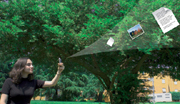
Interactions Within a Personal Network of Devices
In the future, our electronic devices will be networked together and all our digital content will be available when we need it. We'll have thus ever more data to sift through. Exploring the Content Network, Thomas Stovicek's thesis project, is a a set of screen-based software and hardware interactions between devices that looks at new ways to access, view and filter this growing store of information.
Devices are physically manipulated and keywords used to make a more intuitive way to access content- text, photos, videos etc. The coordinating system, called Content Network, connects a group of devices and gives them access to each others' content. One of its elements, Navigation Through Related Tags, lets people find their content based on keywords instead of folders.
Combining Devices to Navigate Content uses very short-range wireless between the devices to detect how they are interacting and triggers data transfer and shared actions: placing one person's mobile phone over another's, for instance, bring up, on both screens, a combined calendar highlighting available times for a proposed meeting.
"Related tags allow to sort and organize your content by keyword. Physical interactions helps by using intuitive actions to interconnect the devices of a group of people, to show only data relevant to, and organized for, the task in hand. These concepts, which apply to both work and social groupings, demonstrate new potentials in navigating your content without the fear of information overload normally associated with it." [blogged by Regine on we-make-money-not]
Posted by jo at 08:51 AM | Comments (0)
Presence

Monitoring the Flow
Presence is a responsive lighting installation that represents the flow of individuals in Parsons School of Design MFA Design +Technology through real-time feedback of activity on the school's 10th Floor. The project consists of two parts: data-gathering through motion detectors and IR sensors distributed in the environment and a light installation, which responds to the signals transmitted from the sensors. The data from sensors influences the dimmers of the light installation, creating optical illusions of colorful shadows in the elevator lobby on 2 West 13th. The effect is also augmented by the subtle changes in mood, generated by the various combinations of cool and warm light.
A sculptural relief wall piece is surrounded by RGB lights, which combine together to create a rainbow of tonalities. Each light is connected to a dimmer which is influenced by the signal received in real time from the sensors. By changing the intensity of the lights, new colors emerge and the perception of the white relief and its shadows is altered, indicating changes in the flow of people converging on the Design and Technology floor. Developed by Mary Behr, Lisa Daly, Ivy Feraco, Margarida Garcia, Maria Ioveva, Ernesto Klar, Gabriela Lopez, Nattapol Suphawong. [blogged by Regine on we-make-money-not]
Posted by jo at 07:47 AM | Comments (0)
August 09, 2005
16Beaver

Continental Drift Seminar with Brian Holmes
We are pleased to invite you to participate in a Seminar with Brian Holmes this September and October online and at 16Beaver. There are two possible ways of joining: 1. to physically attend in NYC and 2. to participate via webcast. We will give more information about the online version, as we have details, so for this email, we focus on the physical participation.
Continental Drift is a modular and experimental seminar that will attempt to embark upon the "impossible" task of articulating the immense geopolitical and economic shifts which took place between 1989-2001, the effects of those changes on the emerging bodies of governance (i.e., the formation of economic blocs like EU or NAFTA) and in turn the effects on subjectivity. Having witnessed the incredible vibrancy of social movements which took hold in that same period, the seminar acknowledges that new modes of control and channeling of various flows have merited a shift in tactics and strategies. The question of "what now?" is precisely at the core of our study.
"The goal, then, is to map out the majority models of self and group within each of the emerging continental systems, to see how they function within the megamachines of production and conquest – and at the same time, to cross the normative borders they put into effect, in order to trace microcartographies of difference, dissent, deviance and refusal."
We hope you will be able to join us in what should be an open and critical discussion.
1. Dates
Part 1 of the seminar will be September, (12) and (15-18): We have spent the last year coordinating and developing the format and context for this event. The seminar is open to all who are interested, however, for practical reasons we want to limit enrollment. Please see directions for enrollment below.
Part 2 will take place in October (20-24). (details forthcoming), if you already know that you are interested in part II please let us know.
2. About Seminar Format and Schedule
It has been 6 years now since we have been initiating various events, activities and discussions. We have over this time sought opportunities to find partners in organizing small colloquia, workshops, and seminars which take on a subject in a more focused manner. This collaboration with Brian is further development of this desire for a more concentrated involvement and discussion around a specific set of questions.
The schedule will be the following:
Monday September 12 -- Introduction / Conversation with Brian -- 7:30 PM
Thursday September 15 -- Lunch -- 12:00 PM -- Participant Introductions
Thursday September 15 -- Session 1 -- 6:30 PM
Friday September 16 -- Lunch -- 12:00 PM -- Participant Introductions II
Friday September 16 -- Session 2 -- 6:30 PM
Friday September 16 -- Dinner Event -- 9:30 PM
Saturday September 17 -- Session 3 -- 1:00PM -5:00PM
Saturday September 17 -- Social TBA -- 6:00PM
Sunday September 18 -- Session 4 -- 1:00PM -5:00PM
Sunday September 18 -- Social TBA -- 6:00PM
Participants who are traveling to NYC can of course attend from Thursday to Sunday.
We should also note that we are making arrangements to stream the seminar online, so those who are not able to attend can follow and hopefully still participate.
3. How to Enroll? + Funding
To enroll in this seminar please send an email to: seminars[at]16beavergroup.org
The participation fee is 25-50$ (sliding scale). We will waive the fee for those who have great difficulty in paying but have a strong desire to participate.
Last year, we were given $700 by RepoHISTORY as they officially closed their bank account. We will be applying all of that money towards Brian's airfare. We would like to extend a thanks to their assistance in realizing this event.
4. Continental Drift - An Overview by Brian Holmes
Continental integration refers to the constitution of enormous production blocs – and particularly, to NAFTA and the EU (while awaiting the emergence of a full-fledged Asian bloc around Japan and China).
But continental drift means you find Morocco in Finland, Caracas in Washington, "the West" in "the East" – and so on in every direction. That's the metamorphic paradox of contemporary power.
The continental blocs are functioning governmental units one scale up from the nation-state. They represent specific attempts to articulate and manage the vast constructive and destructive energies that have been unleashed by the last four decades of technological development, from the introduction of the worldwide container transport system in the sixties, all the way to the emergence of widespread satellite transmission in the eighties and the Internet in our time. Military strategies, the competitive rush for markets, but also the uncertainty and turbulence of the neoliberal globalization process itself has led capitalistic elites to seek forms of territorial stabilization – however violent this "stabilization" may be. This means re-organizing, not just spaces and flows, but also hearts and minds, whether in the centers of accumulation or on the peripheries. We are all affected, wherever we are living.
The main hypothesis I want to put out here is that the two really-existing blocs – NAFTA and the EU – are both developing not only a functioning set of institutions, but also a dominant form of subjectivity, adapted to the new scale. This form of subjectivity is offered to or imposed upon all those who still live only at the national level, or on the multiple edges or internal peripheries of the bloc, so as to integrate them. At the same time it serves to rationalize – or to mask – the concomitant processes of exploitation, alienation, exclusion and ecological devastation. In what different ways does this integration of individual and cultural desire take place? How is it resisted or opposed? How to imagine an excess over the normative figures of continentalization? Where are the escape hatches, the lines of flight, the alternatives to bloc subjectivity? And what types of effects could these exert on the constituted systems?
To answer such questions in any meaningful way requires several different levels of investigation. First, the driving forces of the globalization process – including neoliberal doctrine, the globalized financial system, the transnational institutions and Imperial infrastructures such as the Internet or the GPS satellite mapping system – have to be identified and observed in operation. Second, the evolving forms of territorial governance and the constantly shifting territorial limits of the major continental blocs have to be described and differentiated from each other. Third, the dominant forms of subjectivity in each bloc - the models of success and jouisssance - have to be characterized, using the tools of social psychology. But the most interesting and probably the most urgent thing is to conduct singular and transversal investigations on the margins of these majority formations, to see how people are reacting, innovating, resisting and fleeing.
The goal, then, is to map out the majority models of self and group within each of the emerging continental systems, to see how they function within the megamachines of production and conquest – and at the same time, to cross the normative borders they put into effect, in order to trace microcartographies of difference, dissent, deviance and refusal. For that, it's necessary to travel and to collaborate, to invent concepts and also set-ups, ways of working. One tactic is to juxtapose sociological arguments with activist inventions and artistic experiments. Another is to crisscross the languages, and even better, the families of languages, and to reside in the gaps between their truth claims and sensoriums. But still another is just to drift and see what happens. The ideas of Felix Guattari, particularly in Chaosmosis and the untranslated study, Cartographies schizoanalytiques, can provide a kind of crazy compass for these attempts to articulate something subjectively and collectively, outside the existing frames.
Obviously, this kind of project is scientifically "impossible." No conceivable group of researchers, and certainly not an ad-hoc operation, could possibly synthesize the varieties of knowledge needed at these scales. This is where a de facto censorship begins to operate, with all kinds of consequences. To accept the impossibility is to condemn oneself to ignorance, not only of the contemporary macrocosm (the world-space), but also of the dynamics of your own microcosm (what happens in your head, what pulses in your veins). So we're gonna try the project nonetheless.
Modularity and experimentalism will be the strategies for eluding any tacit censorship of this irrational desire to know. Modularity, because it refuses the totalizing construction and always leaves room for an extra module to be inserted in a line of questioning, completing it, problematizing it, or opening up a new bifurcation. Experimentalism, because the existing rationalities and protocols of truth are simply not enough to make a world, and only the undiscovered form or order holds a chance of breaking the deadlocks that confront everyone, at the micro and macro scales of disaster in the twenty-first century.
This project stems from the geophilosophical desire of an individual, but demands only to multiply. The research will be done through the opportunities of various collaborative projects, on location and over the net. The seminars in which the major hypotheses will be formulated and explored, and certain case studies presented, will be carried out with a series of mostly non-institutional partners, beginning with the 16 Beaver group in New York, for a seminar extending from September 12 to 18. Certain research modules will be published with cooperating institutions, and/or presented at conferences. Results of the research and contributions by participants will be posted on here on www.u-tangente.org, and perhaps on a specific project website.
5. About Brian Holmes
Brian Holmes is an art and cultural critic, activist and translator, living in Paris. He has a doctorate in Romance Languages and Literatures from UC Berkeley, but prefers to develop research outside the academy. He was the English editor of publications for Documenta X, Kassel, Germany, 1997, worked with the French graphic arts group Ne pas plier around the turn of the c entury, and has collaborated with the critical mapmakers Bureau d'Etudes, most recently on the website Tangent University. His essays appear on the mailinglist Nettime, in the art magazines "Springerin" and "Brumaria" and in the philosophy and sociology journal "Multitudes," among others. He is the author of a book of essays, "Hieroglyphs of the Future: Art and politics in a networked era" (Zagreb:
Arkzin/WHW, 2002). That book, a forthcoming volume called "Unleashing the Collective Phantoms," and a range of other work in various languages can be found in the archive at www.u-tangente.org, along with all the material for the current project "Continental Drift."
6. Specifics
As Brian is updating the program daily, we will for the interim rely on the following website:
http://www.u-tangente.org (click continental drift) or http://ut.yt.t0.or.at/site/index.php?option=com_content&task=section&id=14&Itemid=125
16 Beaver Group
16 Beaver Street, 4th / 5th fl.
New York, NY 10004
phone: 212.480.2093
for directions/subscriptions/info visit:
http://www.16beavergroup.org
TRAINS:
4,5 Bowling Green
R,W Whitehall
2,3 Wall Street
J,M Broad Street
1,9 South Ferry
Posted by jo at 01:09 PM | Comments (0)
In Memory of Franz Feigl
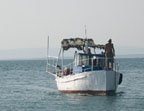
The Myth of Bolshevik
Network activists and friends of the medien.KUNSTLABOR want to travel by boat from Amsterdam to the Black Sea. Final destination of the journey is the island St. Anastasia, formerly known as Bolshevik (1945 - 1990). The boat is named after Franz Feigl, an Austrian artist and network activist who lived in Amsterdam and died in 2001 at a young age.
The boat will record on its journey all open wireless lan access points. This activity, if conducted by car, is called war-driving. The peaceful goals of the Motorship Franz Feigl aim at highlighting the possibility of opening up networks and creating a free infrastructure (see Funkfeuer, Freifunk,
Consume).
The boat will also communicate via packet radio and pictures will regularly be sent by GPRS to http://stroem.ung.at. MS Franz Feigl has already travelled from Amsterdam via Linz to Vienna. In Linz at the wharf of the Times Up collective repair work on the boat was done. It has travelled safely from Linz to Vienna under captainship of Franz Xaver.
Tomorrow, Wednesday August 9, the MS Franz Feigl is due to leave for Bratislava, where it will arrive om Thursday or Friday. On Monday, August 15, it will arrive in Budapest.
The project is carried out in collaboration with 05-trov and mobil.KUNSTLABOR.at
SMS Kontakt: 00436764902223
Chat: irc.kunstlabor.at#kunstlabor
E-mail:boot[at]kunstlabor.at
[via netbehaviour]
Posted by jo at 12:35 PM | Comments (0)
MEDIA ECOLOGIES:
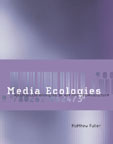
Materialist Energies in Art and Technoculture
In Media Ecologies, Matthew Fuller asks what happens when media systems interact. Complex objects such as media systems -- understood here as processes, or elements in a composition as much as "things" -- have become informational as much as physical, but without losing any of their fundamental materiality. Fuller looks at this multiplicitous materiality -- how it can be sensed, made use of, and how it makes other possibilities tangible. He investigates the ways the different qualities in media systems can be said to mix and interrelate, and, as he writes, "to produce patterns, dangers, and potentials."
Fuller draws on texts by Félix Guattari (and his "serial collaborator" Gilles Deleuze) as well as writings by Friedrich Nietzsche, Marshall McLuhan, Donna Haraway, Friedrich Kittler, and others, to define and extend the idea of "media ecology." Arguing that the only way to find out about what happens when media systems interact is to carry out such interactions, Fuller traces a series of media ecologies -- "taking every path in a labyrinth simultaneously," as he describes one chapter. He looks at contemporary London-based pirate radio and its interweaving of high- and low-tech media systems; the "medial will to power" illustrated by "the camera that ate itself"; how, as seen in a range of compelling interpretations of new media works, the capacities and behaviors of media objects are affected when they are in "abnormal" relationships with other objects; and each step in a sequence of Web pages, "Cctv -- world wide watch," that encourages viewers to report crimes seen via webcams.
Contributing to debates around standardization, cultural evolution, cybernetic culture, and surveillance, and inventing a politically challenging aesthetic that links them, Media Ecologies, with its various narrative speeds, scales, frames of references, and voices, does not offer the academically traditional unifying framework; rather, Fuller says, it proposes to capture "an explosion of activity and ideas to which it hopes to add an echo."
To order this book and to learn more about other titles in the Leonardo Book Series please visit the Leonardo Book Series website.
MEMBER DISCOUNT! Leonardo/ISAST Associate Members are eligible for 20% off all Leonardo Book Series titles and also receive a number of other membership benefits! Visit http://leonardo.info/members.html for more details.
Posted by jo at 12:19 PM | Comments (0)
CONNECTIVITY:
![]()
THE TENTH BIENNIAL SYMPOSIUM ON ARTS AND TECHNOLOGY
The Ammerman Center for Arts and Technology at Connecticut College is pleased to announce Connectivity: The Tenth Biennial Symposium on Arts and Technology, March 30 – April 1, 2006. The mission of the symposium is to present new works, research and performances in the areas of technology and the arts. The symposium will consist of commissioned works, paper sessions, panel discussions, art exhibitions, interactive environments, music concerts, screenings and multi-media performances. In an effort to demystify the artistic process and create a forum for dialogue, we are encouraging all presenters and artists to speak about their work at the symposium.
The Center seeks submissions in the general areas of Interactivity, Cognition, Compositional and Artistic Process, Social and Ethical Issues in Arts and Technology, Art, Music, Video, Film, Animation, Theater, Dance, Innovative Use of Technology in Education, Scientific Visualization, Virtual Reality, and other pertinent topics relating to arts and technology.
SUBMISSION CATEGORIES
COMMISSIONED WORKS: Proposals for new, original, interdisciplinary works will be accepted for a “Commissioned” category. Works must be created by a team consisting of two or more members, and must combine two or more areas of creative expression and contain a major technology component. Proposals will be accepted for performances, concerts, showings or installations; completed works will be presented during the symposium. Proposals must include detailed technical and production requirements, and a proposed budget. Limit of one proposal per team. The piece must not have been previously published, performed or exhibited. Awards will be granted at the discretion of the Center. Submissions not accepted for the commissioned category will also be reviewed for the general submissions category. Accepted commissions will be awarded a stipend of $3000 and a residency at Connecticut College between March 27 and April 1 that includes:
- performance or installation of the accepted work
- workshops with students
- attendance at the symposium
- presentation at the symposium
PAPERS: A two-page extended abstract or complete paper, including technical requirements, must be submitted by email or mail. Upon acceptance, revised papers must be submitted electronically by January 31, 2006 as a PDF. Complete technical requirements for presentation must be included. Papers will be published by the Center in the symposium proceedings. All rights will remain with the author. Papers will be selected for twenty-minute presentations as part of the daily schedule of speakers. Papers may be grouped by the Center in a panel discussion format.
PANEL DISCUSSIONS: Proposals for panel discussions are encouraged. Proposals should include names of prospective panelists and topic, which should address the general areas of the symposium. Papers may be grouped by the Center in a panel discussion format.
CREATIVE WORKS: In addition to academic and theoretical papers, submissions of technology-based or technology-oriented creative works are encouraged. Maximum one proposal per person or team, and we reserve the right not to review multiple pieces in a single submission. All submissions must be accompanied by a one-page description/abstract for presentation at the symposium about the work, a list of complete technical needs, biography and contact information. See specific categories for additional requirements. All presenters and artists are encouraged to speak about their work at the symposium. Symposium registration will be required for all symposium attendees.
MUSIC COMPOSITIONS: Music submissions (composition, performance, theory, interactivity, signal processing and music understanding) are encouraged. Works for instruments, digital media, CD or interactive compositions are also being solicited for “tape only” concerts or live performance. Works should not exceed 15 minutes in length and should be submitted with accompanying score, where appropriate. Music must be submitted on CD for review, with accompanying scores as required. Musicians, dancers and actors may be available for live performance pieces. All submissions must be accompanied by a one page description/abstract for presentation at the symposium about the work. Complete technical and performance requirements must be included.
ART: Submissions of digital art, web art and other technology-based or technology-oriented art forms are encouraged. Submissions of desktop interactive works, self-contained web works, time based work, performance and installations will be considered. Acceptance may be constrained by technical needs, security and financial considerations. Artworks will be reviewed on the basis of documentation of the work presented in the form of a website, CD, DVD, VHS or slides. Submissions must include a one-page description/abstract for presentation at the symposium about the work, portfolio (maximum 4 jpegs, no larger than 2 Mb each), brief biography, contact details, and complete technical needs and spatial requirements
VIDEO AND FILM: Submissions of short video or film works that include a significant 'technology' component in their creation, aesthetic or theme are encouraged. The 'tech' involved may be 'high' or 'low', ranging from digital animations and motion capture work on the 'high-tech' end to various methods of creating film without photography, or novel uses of the projector beam on the low tech side. Works that display worthy reflections on the nexus of art, society and technology, even if created by primarily 'conventional' means, are encouraged. Submissions in the category of 'expanded cinema' and projection performance will be accepted, but resources are limited and artists presenting such work should expect to bring all or much of their own essential gear. Submissions must include a one-page description/abstract of the work and VHS, DV or DVCAM tape, DVD (tape preferred). For works involving anything other than standard video or 16mm projection, a complete description of technical and space needs is required. Exhibition format will be DV, DVCAM, or 16mm film (no home-burned DVDs).Selection for screening may be made in part on the maker's willingness/ability to attend the symposium.
DANCE AND THEATER: Computer-generated or computer-aided dance compositions and theater works are being solicited for live demonstrations or for videotaped presentations. Specially produced dance or theater videos are of particular interest as opposed to concert tapes or other archival uses of video. Also of interest are proposals for workshops, demonstrations of software for dance or theater notation, choreographic analysis, interactive studies and/or multi-media studies of performance in dance and theater. Performances may be accepted, but will be limited by technical needs and financial considerations. All submissions should be accompanied by a web site, CD, DVD or VHS, and one page description/abstract for presentation at the symposium about the work, biography, contact details, and complete technical needs and spatial requirements.
IMPORTANT INFORMATION FOR ALL SUBMISSIONS:
DEADLINES (must be postmarked or emailed by date)
November 1, 2005: Commissioned Works Deadline
December 1, 2005: Commissioned Works Notification
December 1, 2005: General Submission Deadline
December 22, 2005: General Acceptance Notification
January 31, 2006: Final papers must be received as a PDF
March 27 – April 1, 2006: Residencies for Commissioned Works
March 30 – April 1, 2006: Symposium
RETURN: Submissions, art works, slides, CDs, DVDs, VHS, tapes or scores will only be returned if a self-addressed stamped envelope or packaging is provided.
SEND SUBMISSIONS TO:
Ammerman Center for Arts and Technology
Connecticut College
270 Mohegan Avenue – BOX 5365
New London, CT USA 06320-4196
phone: [860] 439-2001
email: cat@conncoll.edu
http://cat.conncoll.edu
The 10th Biennial Symposium is sponsored by Citizens Bank, USA.
Posted by jo at 12:08 PM | Comments (0)
TRANSITIO_MX 2005 (MÉXICO)
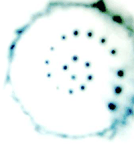
FIRST VIDEO AND ELECTRONIC ARTS CONTEST
Transitio_mx 2005 International Video and Electronic Arts Festival is a place for the expression of contemporary artistic creative practices through electronic media. The main focus of this festival is showing the current production and research in the field, in function of the constant mobility of its epistemological, technological, cultural, aesthetic and social boundaries. These dissolutions invite us to explore the nature, scopes and conflicts between, art, technology, sciences and humanities making the Festival a permanent site for the expression and reflection of the above mentioned relationships.
This first edition of the Festival has chosen the "Imaginaries in transit: poetics and technology" as its main theme. The thematic proposes to go deep into the paradigm that provides of contents and expands technology right from the poetics or sign's site, rather that emphasizing the research concerning technological support itself. "Imaginaries in transit: poetics and technology" seeks to explore the aesthetic and cultural re-signification modes that accompany electronic art production and research, inviting the participants of the contest to reflect about production within this context.
Transitio_mx will count with the presence of well known personalities such as Marina Grzinik, Rafael Lozano Hemmer, Arlindo Machado, Jorge Laferla, Príamo Lozada, José Luis Barrios, among others. The jury for the First Video and Electronic Arts Contest will also be made up of important artists and theoretitians in the electronic arts field. Three prizes will be awarded: first prize consisting in N$120,000.00, second prize consisting in N$90,000.00 and third prize of N$75,000.00. The previous amounts are in Mexican pesos.
The National Culture and Arts Council, through the Center for Multimedia of the National Center for the Arts, invites all artists of this field to participate in the First Video and Electronic Arts Contest that will take place within the framework of this Festival from December 6 to 11, 2005.
The deadline for the contest is September 30, 2005. For information on the required documents, and in order to complete the entry form visit: http://transitiomx.cenart.gob.mx or write an email to Ana Villa: concursoae[at]correo.cnart.mx
Posted by jo at 08:50 AM | Comments (0)
SMS Chatwall
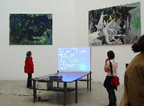
A Sculpture Replies
For this year's diploma exhibition of the Hochschule für Bildende Künste Dresden (Dresden's High School of art), Matthias Haase has presented a project using a special version of the SMS Chatwall event software. Haase installed the GSM-module, a computer and beamer equipment on a table with a projection screen, calling the installation "Bote" (messenger). Exhibition visitors can send short messages to the number shown on the screen. As a take-away gift for the visitor, the sculpture replies with an artist's "thank you" SMS, mentioning the art exhibition at the HfBK 2005.
People who want to take part, but can't attend the exhibition can send an SMS to +4915204912748. Thanks a lot Alex! More here if you speak german. [blogged by Regine on textually.org]
Posted by jo at 08:36 AM | Comments (0)
Super-i®
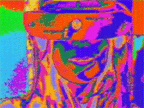
Real Virtuality™ System
Super-i® is made for those who want to see the world differently, - painted in fresh new colors. With Super-i® you'll be fascinated by what you see: the world as you know it will be looking absolutely different. Our goggles are equipped with the brand-new system of Real Virtuality™, which changes "real" world around us into a virtual one, and does it without a computer and in real time!
With our product you will not have to spend time sticking to your monitor and stressing your eyes; you will not have to wait long until the system boots up; you will not be unhappy with the image quality anymore! And, most importantly: with Super-i® you will finally reach unimaginable level of freedom - freedom to physically move around in the space in any direction, indoors or outdoors!
How does it work?
The heart of Super-i® is a microchip developed by our company on the basis of the newest technologies. It allows real-time (without delay) processing of a video signal and applying different effects on it. Other system components are: a video camera with a "human" angle of view, and a pair of excellent image quality micro-displays. The whole system is assembled inside a lightweight goggles that comfortably fits any head. The unit is absolutely autonomous and is powered by standard AA batteries, which can run it for few hours.
Effective algorithms, similar to those used in professional systems of image processing (such as Adobe Photoshop™) are embedded into Super-i®. The quality of the camera and micro-displays is so great, that not only you'll be able to explore the wonderfully altered reality, but also to get around easily. [via]
Posted by jo at 06:55 AM | Comments (0)
August 08, 2005
Remote-Controlled Humans
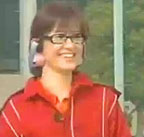
What Men and the Military Really Want
NTT has demonstrated a remote-control system for (women). The researchers outfit their subject with two electrodes behind the ears that “pull” her in one direction or another. As you can see in the video accompanying a Forbes article on the technology, the subject walks (and laughs) like she’s just hammered. This reminds of the Tele-actor, a project I worked on with Ken Goldberg, Eric Paulos, Judith Donath, and others several years ago. (Link to PDF.) One big difference is that we just asked our human robot to respond to our wirelessly-transmitted wishes. The NTT system is more, er, demanding. From Forbes:
This sort of electrical stimulation is known as galvanic vestibular stimulation, or GVS. When a weak DC current is delivered to the mastoid behind your ear, your body responds by shifting your balance toward the anode. The stronger the current, the more powerful its pull. If it is strong enough, it not only throws you off balance but alters the course of your movement…
The most persuasive commercial applications of (NTT researcher Taro) Maeda’s GVS device will most likely be in gaming; researchers put together a crude virtual racing game to demonstrate how GVS heightened the perception of centrifugal force as users watch the car wind its way around the track on a video screen. Manabu Sakurai, NTT’s marketing manager, says the company is currently investigating whether or not gamers would be interested in the device. Flight simulators are another area of interest.
“Many people talk about that,” Sakurai explained. “Because GVS causes you to feel the same kinds of motion as a large-scale flight simulator, it could be a much simpler and more cost-effective way to train people.” [via boingboing]
Posted by jo at 10:27 AM | Comments (0)
Shadow

Merged Shadows: 1/2+1/2=1
Shadow, by Adam Frank in collaboration with Zack Booth Simpson, projects a disembodied, autonomous, human shadow on the ground. This "living" shadow attempts to merge itself with the viewer's real shadow. If you run away, the shadows will follow. If you move towards the shadows, they will retreat. But if you stay relatively still, the shadows will slowly approach. The shadows will then position their feet directly on top of yours. This act merges your own shadows with the invisible figure. Once merged, the virtual shadows disappear.
Our shadows are with us constantly yet we pay little attention to them. These shadows are the absence of light due to our presence. Shadow merges viewer and artwork, the real and the virtual, into one entity. The feeling of both the presence and absence of another human being is visceral and ghostly. In a sense, this piece functions as a quiet, interactive, anonymous memorial. Video. Check also Lumen, a stainless steel shadow projector. Related: Tool's life, Lies, all lies, 3 minutes2. [blogged by Regine on we-make-money-not]
Posted by jo at 10:12 AM | Comments (0)
Heaven Seed
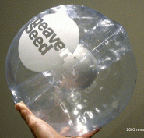
Populating Physical Spaces with Digital Sound Effects
Heaven Seed is a smart plastic ball that senses its movement and generates various sound effects in real time thereby enhances the game people play with it. The motion data sensed by the ball are wirelessly transmitted to a host computer to provide rich auditory experiences. For example, if you throw it upward, it makes a whiz sound; when you catch it, it makes a flopping sound. If it's left unused for a while, it starts snoring.
Ryota Kuwakubo, who created this artifact, says that he wanted to evoke in users the kind of feeling kids would have while playing with a miniature car – kids may make the sound of speeding with their mouths and they could get totally immersed in the play. Kuwakubo also suggests a possibility of making everyday life more "interesting" by populating our physical spaces with various digital sound effects. When you open the door, when you start a washing machine, etc. If the world around us will be the interface to the digital information spaces, Heaven Seed suggests unique possibilities of enhancing our embodied interactive experiences with creative sound design. Related websites: vector::scan; MyCom PCWEB. [blogged by manekineko on we-make-money-not]
Posted by jo at 10:05 AM | Comments (0)
Peekaboom
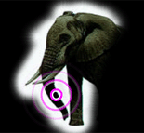
Peeking and Booming: Teaching Computers to See
Peekaboom Basics: you and a random partner take turns "peeking" and "booming." While one of you is peeking, the other is booming. The booming player (Boom) gets an image along with a word related to the image, and the peeking player (Peek) gets no image (see Figure below). Booming consists of clicking parts of the image; when Boom clicks a part of the image, it is revealed to Peek. The object of the game is for Peek to type the word associated to the image -- from their perspective, the game consists of a slowly revealing image, which has to be named. From Boom's perspective, the game consists of clicking on areas of the image so that Peek can guess the word associated to it. Once Peek guesses the correct word, the two of you move on to the next image and switch roles.
You and your partner should go through as many images as you can in 4 minutes. Every time Peek guesses the right word, both of you get a certain number of points. You can also choose to pass, or opt out, on difficult images. If you click the pass button, a message is generated on your partner's screen; you cannot pass on an image until both of you have hit the pass button. Boom can see all of Peek's guesses and can indicate whether they are "hot" or "cold."
Pings: In order to help Peek, Boom can also "ping," or point to, an area of the image. Pings tell Peek that the word is related to that particular area. In the Figure to the left, for instance, Boom has already revealed enough of the image for Peek to see that it is an elephant, but Boom still needs to point to the trunk, since the associated word is "trunk" and not "elephant."
Hints: Boom can also help Peek by giving hints about the word in question: does it refer to a noun in the image, to a noun related to the image, to a verb, or to text appearing in the image? Using the hint buttons gives you extra points. [via smartmobs]
Posted by jo at 09:49 AM | Comments (0)
Vis-a-Vis:
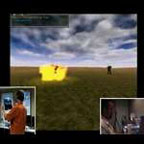
Mobile and Pervasive Electronic Gaming
After WiFi Bedouin and other mobile, location-based games, one of Julian Bleecker's current project along with Peter Brinson is called Vis-a-Vis. They’ve cobbled together a mobile gaming framework composed of light-weight, outdoor viewable TabletPCs, the Torque available source game engine, a GPS, a mil-spec 3D sensor that’s able to measure where one points the TabletPC. The plan with Vis-a-Vis Games is to take ordinary electronic gaming off the old fashioned video game console and desktop PC and moves it out into the real world. One of their current demos is an implementation of the Red Light, Green Light game. [blogged by fabian on 7.5th Floor]
Posted by jo at 09:25 AM | Comments (0)
Futuresonic 2006
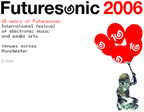
Independence: 10 Years of Futuresonic
Celebrating collaborative cultures and independence movements - from independent labels to peer-to-peer culture, from free parties to free networks, from locative media to local food.
The Futuresonic 2006 festival will explore the theme of Independence, looking at collaborative cultures and independence movements in art, technology and culture. Futuresonic was formed 10 years ago at a time when there was a emergent musical and digital culture that was outside the mainstream, collaborative and peer-to-peer. Today a centre of gravity has shifted towards the world of hackers, bloggers, free networks, open source, social software and civic technologies. What has remained constant has been the emphasis on social autonomy and independence of creative practice. Futuresonic 2006 will explore the state of independence today, and showcase independent music, arts and technologies that are open, emergent, collaborative and ad-hoc.
Futuresonic 2006 will also host the final exhibition and conference of PLAN - The Pervasive and Locative Arts Network.
Posted by jo at 08:49 AM | Comments (0)
VIDA 8.0
![]()
ART & ARTIFICIAL LIFE
VIDA 8.0 is the seventh edition of this international competition, created to reward excellence in artistic creativity in the field of artificial life. In previous editions, prizes have been awarded to autonomous entities able to bring us pleasure (Tickle 2.0, Tickle Salon 5.0), engage us in irrational conversations (Head 3.0) or invade our social space (Cour des Miracles 2.0); virtual ecologies that evolve with user participation (Autopoiesis 3.0, Electric Sheep and Remain in Light 4.0), autonomous systems that use the feedback obtained as a mechanism and metaphor for transformation (Appearance machine 3.0, Levántate 5.0) and works highlighting the social side of artificial life (Novus Extinctus 4.0, The Relative Velocity Inscription Device 5.0, The Central City 6.0 and Spore 7.0).
Other themes are addressed in works that have been given honourable mentions: avatars and players in their unique worlds (Iconica 2.0, Life Spacies II and Unconscious Flow 3.0), new interpretations of the roots of artificial life, such as cellular automatons (Sandlines 3.0, Dadatron 5.0) and system feedback or autonomy translated into simple familiar media (Breathe and Autistic-Artistic Machine 4.0, The Responsive Field of Lattice Archipelogics 5.0).
We are looking for art that reflects the panorama of the possible interaction between 'synthetic' and organic life, e.g. - Autonomous agents that shape and perhaps interpret the data-saturated environment we have in common. - Portraits of inter-subjectivity or empathy shared between artificial entities and ourselves. - Intelligent anthropomorphisation of the datasphere and its inhabitants. - User-defined exploration and interaction designed to reduce fear and stimulate interest in the emerging phenomena which, by definition, are beyond our control.
An international jury will award prizes to the most outstanding projects in electronic art which use techniques such as digital genetics, autonomous robotics, recursive chaotic algorithms, knowbots, computer viruses, virtual ecosystems and avatars.
There is a total of EUR 20,000 in prizes for the three projects selected by the jury:
First prize: EUR 10,000
Second prize: EUR 7,000
Third prize: EUR 3,000
There will also be special mentions for a further seven projects chosen by the jury. Each project must be submitted as a 5-10-minute video with voice-over narration describing the artistic concept and the technological realization of the project presented. The project must be post-September 2003. The jury's decision will be based essentially on the video.
Participants must provide a VHS tape (PAL, NTSC or SECAM format) or DVD for the jury. If your work is awarded a prize or a special mention, you will be asked to provide a video on professional-quality format (Dvcam, Betacam, U-Matic, MiniDV) for inclusion in The Best of VIDA 8.0 .
The competition is open to participants from all over the world; however, each participant may present only one project. To register, read the competition rules, complete and sign the application form and submit it together with the tape to Fundación Telefónica before 30 September 2005.
Posted by jo at 07:08 AM | Comments (0)
August 07, 2005
Sim Civics
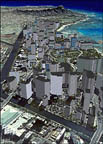
Public Participation in Regional Planning
Sim Civics by Jeff MacIntyre, The Boston Globe, August 7, 2005: New game-like computer software is empowering ordinary citizens to help design better cities. Can the professionals and the public learn to play well together?
[Image: SIM ISLAND--This 3-D image of Honolulu was created using GIS software from the company ERSI, as part of Honolulu's six-year planning initiative. (Courtesy of ESRI/City of Honolulu).]
"FIFTEEN YEARS AGO, the future of urban planning arrived in the form of a wonkish but strangely addictive new computer game. In SimCity, a player assumed the twin roles of mayor and city planner, creating elaborate cityscapes, managing zoning, transportation, and growth, while fighting off poverty, crime, traffic, and pollution..."SimCity...has probably introduced more people to urban planning than any book ever has."...Today, a new generation of GIS applications, known as ''scenario planning" or ''decision support" tools--which allow users to visualize, project, and manipulate a wealth of environmental data--have made citizens into major players in the gaming of urban futures. Across the United States...these tools are enabling an unprecedented level of public participation in broad regional planning initiatives..."
Posted by jo at 09:26 AM | Comments (0)
Two from nARCHITECTS
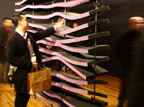
Vital Signs + Party Wall
Vital Signs, by nARCHITECTS, is an interactive installation project designed to disseminate breaking news about science to visitors in the Liberty Science Centre (NJ). A continuous moebius strip of LEDs interspersed with projections would allow visitors to view streaming information from all sides of the atrium. A ladder-rung structure consists of an outer aluminum edge rail joined together by intermittent rungs. Plexi ribs supporting the LED’s and translucent plexi projection surfaces span between the edge rails. Visitors can dynamically select topics or upload information from various points along the mezanine handrails.
Recently, nARCHITECTS had also created the Party Wall for the SoHo gallery Artists Space. The installation created a variable boundary in the gallery, dividing visitors into different sides of the room. The 5 cm-thick foam panels connect to servo motors, proximity sensors as well as pulleys and cables that react when the sensors detect motion nearby. The motors exert pression on the pulleys, lifting, depressing, expanding or compressing the foam into waves visitors can interact with. Future versions of Party Wall could respond to light, heat or sound, and correspondingly modulate optical, thermal or acoustic attributes of a wall. Movie. [blogged by Regine on we-make-money-not]
Posted by jo at 09:18 AM | Comments (0)
THRESHOLDS 31:
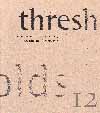
EPHEMERA
Thresholds, the bi-annual critical journal of architecture, art and media culture of the department of architecture at MIT invites submissions for issue 31 'ephemera': DUE: October 31, 2005.
We have accelerated into an age in which information is as fleeting as our response to it, and the capacity for its processing the new world currency. The relevance of the moment has become eclipsed by that of its own passage, and absolute position has become an easy sacrifice for the velocity on offer. We have been at last swept by the flux of our times into a time defined by its own flux. Time has become both the axis and the function.
Thresholds 31 seeks to explore this condition through identifying, suggesting, tracing and questioning the notion of ephemera* through time and cultural relevance. What role does ephemera play within current cultural practice and thought? What are its historical traces and its cultural import? What are the projects in which it has become manifest deliberately, or not and why? Are we longing for a future or a past, or neither?
Contributions from all fields including, but not limited to, scholarly works are welcome. thresholds 31 will be the first issue to accept both text and time-based media submissions. Time-based media submissions might include but are not limited to, video, sound, animation, etc. and will be published in digital format.
*ephemera, n., transf. and fig. One who or something which has a transitory existence. [Oxford English Dictionary, 2nd edition 1989]
SUBMISSIONS
Thresholds invites submissions, including but not limited to scholarly works, from all fields. thresholds attempts to publish only original material. Materials should be postmarked by October 31, 2005.
TEXT: Manuscripts for review should be no more than 2,500 words. Text must be formatted in accordance with The Chicago Manual of Style. Spelling should follow American convention and quotations must be translated into English. All submissions must be submitted electronically, via e-mail or disk, and accompanied by hard copies of text and images. Text should be saved as Microsoft Word or RTF format, while any accompanying images should be sent as TIFF files with a resolution of at least 300 dpi at 8" x 9" print size. Figures should be numbered clearly in the text. Image captions and credits must be included with submissions. It is the responsibility of the author to secure permissions for image use and pay any reproduction fees. A brief author bio must accompany the text.
MEDIA: Media submissions below 8MB can be submitted via e-mail to: thd[at]mit.edu and by disk. Submissions above 8MB must be sent on disk and/or posted on a server for download. Most common file formats will be accepted. Thresholds reserves the right to request reformatting of works for final publication. It is the responsibility of the author to secure permissions for proprietary media use and pay any reproduction fees. A brief author bio must accompany the work.
Please send materials or correspondence to:
Talia Dorsey, Editor
thresholds
MIT Department of Architecture
Room 7-337
77 Massachusetts Ave.
Cambridge, MA 02139, USA
http://architecture.mit.edu/thresholds/
inquiries: thresh[at]mit.edu
text/image submissions: thresh[at]mit.edu
media submissions (below 8MB): thd[at]mit.edu
Posted by jo at 09:15 AM | Comments (0)
The MARS PATENT
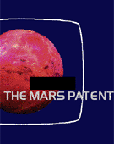
The First Interplanetarian Exhibition Space
The MARS PATENT--by Claudia Reiche and Helene von Oldenburg--is the first interplanetarian exhibition space. You are invited to experience culture on a fascinating and promising new site. Millions of miles away the red planet now lies within your reach – in an entirely new way. Since the early days the MARS PATENT committee has been working hard to find a discriminating place for your desires which allows a new sight on Earth: The MARS PATENT offers its MARS EXHIBITION SITE (MES) to you as a free experimental area and invites every thing which does not fit entirely on Earth but tends towards the MES. A thing? A real thing? Could be your idea, your object, your work, your question, your protest, your project, your desire. Mars – still untouched by human hands – is a dry, cold and poisonous place and often experienced to be of terrific beauty.
The Mars Exhibition Site (MES) is located near the equator in the north of a lowland area named Elysium Planitia. MES is a floating area. Its slightly changing form is a strung-out rectangle. Think of an area of approximately 3148 square kilometers offering a wide range of altitudes within a rocky landscape filled with incredibly shaped lava masses - exposed to storms and temperatures varying rapidly between -127 °C and +15 °C.
The MARS PATENT is a place for art and theory and sensible to its various concepts. With MARS PATENT's HRM_1.0n (High Reality Machine) we offer cutting edge technologies for installing sculptures, Internet relay chats, kinetic objects, art-and media theories, science fiction literature, telepresence systems, videos, sound installations, manifestos, web-art etc. by teleportation. This machine will become a potent device in your hands to place your things on the MES.
The main feature of the HRM_1.0n is the signal transmission with the ‘sender’ located on Earth and the ‘receiver’ located on Mars. The teleportation by the HRM_1.0n signifies an irreversible transfer from Earth to Mars. No matter treated by the HRM_1.0n will remain undamaged – from slight atomic disturbances to even more destructive effects. We differentiate a) Matter-Signal-Matter-Transformation (complete teleportation), b) Signal-Matter-Transformation (signal realization), c) Matter-Signal-Transformation (matter realization). HRM_1.0n’s Capacity of Signal Processing Rate: 1027 Tetra Flop/sec. Transmission Shaft Size is 32cm x 24cm x n cm.
As a controlling device THE MARS PATENT additionally provides an ongoing live-report from the local situation of the project’s area, the MES Attention: female first names only will be accepted! The question “If I'm not of female , could I register under a female name?“ is answered in the MARS PATENT’s Frequently Asked Questions: „The HRM_1.0n (High Reality Machine) is not able to control the biological identity. It's your commitment that counts“, even “ If they [the aliens] come up with a real e-mail address, they can always try. With a female first name we encourage every alien to participate.“ The „female privilege“ rule is thus carried out strictly symbolically and processed by the HRM_1.0n’s binary structure. Send your thing to the MARS PATENT!
CREDITS
Concept, content, design, performance: Claudia Reiche, Helene von Oldenburg.
Programming: Alexandra Bialas.
Contributors until July 2005: Ellen Nonnenmacher, Marina Grzinic, Dellbrügge & de Moll, Flora Urania Museum für werdende Kunst, Lena Eriksson, Judith Siegmund, i-love-u, Reva Stone, Gisele Bone, Maya Consuelo Sternel, Iana Krachounova, Stephanie Dean, Claudia Raddatz, Eugenia Gortchakova, Anna Pein, Doro Carl, Susan Chales de Beaulieu, Pio Diaz, Katherine Williams, Jamilia Jazylbekova, Saide Sesin, Paula Hasenzucker, Ma-tha-B Dao-in-space, Ursula Palla, Christina Goestl, Alice Bartle, Sandra Hastenteufel, Maria Deslibes, Maria Miranda, Norie Neumark, Out-of-Sync Collective, Valéry Grancher, Krista Beinstein, Phyllis Green,Chiara Passa, Louis Christian, Deb King, Amanda Steggell, Pernilla Platou, Anna Bardi, Ulrike Bergermann, Gisela Weimann, Sarah Smiley, Lowry Burgess, Naomi Nooteboom, Helen Varley Jamieson, Ada Frankiewicz Collaborations. [via rhizome]
Posted by jo at 07:48 AM | Comments (0)
m@terials:
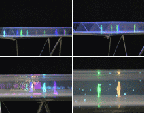
3D Theater on a Table
m@terials, developed by Jitsuro Mase, use an off-the-shelf LCD projector to display a "3D theater" on a table. A video clip available on the Digital Stadium website. It's amazing that this actually works because the hardware device looks deceptively simple. On the table top are transparent plastic strips standing diagonally at 45 degrees. The plastic strips make images stand up. The virtual people can be projected on to a strip closer to you or the ones further away from you.
Digital contents that can be effectively displayed on this device should conform to specific rules, however, "it is not so difficult" according to the creator of this device. This device could be used for many different kinds of things besides the "3D theater" especially if it could be made larger (possibly as big as a computer displays or a building floor?) with hi-fidelity realistic images. [blogged by manekineko on we-make-money-not]
Posted by jo at 07:05 AM | Comments (0)
August 06, 2005
The Matrix of Sensations
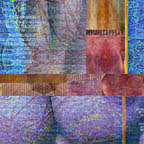
Art Grounded in Codes Rather than Images
"I present to you what I think is a radical thesis: that the period of avant-garde painting, which officially began with the so-called color patches of paint in Manet’s Music in the Tuileries Gardens in 1862, and climaxed almost a century later in the dynamic tachisme of European art informale and American modernist painting, was a time of transition from traditional analogue art to postmodern digital art, that is, to an art grounded in codes rather than images.
The status and significance of the image changes in postmodern digital art: the image becomes a secondary manifestation -- a material epiphenomen, as it were -- of the abstract code, which becomes the primary vehicle of creativity. Before, the creation of material images was the primary goal of visual art, and the immaterial code that guided the process was regarded as secondary. Now, the creation of the code -- more broadly, the concept -- becomes the primary creative act. The image no longer exists in its own right, but now exists only to make the invisible code visible, whatever the material medium. It makes no difference to the code whether it appears as a two-dimensional or three-dimensional image..." From The Matrix of Sensations by Donald Kuspit, artNet magazine. [via Rhizome]
Posted by jo at 09:39 AM | Comments (0)
The Company Keeper
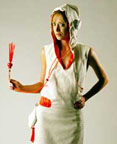
Systematic Self-Awareness
The Company Keeper--by Sara Diamond, Di Mainstone, & The Am-I-Able Design Team--acts as a virtual friend to amuse, comfort, and support its wearer with audio playback and to neutralize the occupant's nervous disposition. The wearer's mood is assessed by his/her body language (calculated with embedded touch sensors and an accelerometer in a hanging beaded tassel) and the level of sound in the environment. When moods such as wrath, awkwardness, and claustrophobia are detected, an antidotal soundscape is played through headphones in the hood. Via Wired. [blogged by Regine on we-make-money-not]
Posted by jo at 07:14 AM | Comments (0)
+336+
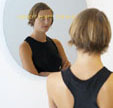
SMS Controlled Spy-Mirror
The +336+, designed by Robert Stadler, is a mirror able to receive SMS sent from a mobile phone. The messages appear as luminous text, running on the mirrors’ surface when one gets close to the mirror. [via textually.org]
Posted by jo at 07:01 AM | Comments (0)
August 05, 2005
Day Of The Figurines

A Single Day in the City
Day Of The Figurines--by Blast Theory and partners--is set in a model of a fictional city that is littered, dark and underpinned with steady decay. From the Gasometer to Product Barn, the Canal to the Rat Research Institute, up to 100 players roam the streets, defining themselves through their interactions. A gunship of arabic troops appears on the High Street. Scandinavian metallists play a gig at the Locarno that goes horribly wrong. How players respond to these events and to each other creates and sustains a community during the course of a single day in the city.
In order to play the game you will need to visit the model at Blast Theory's Studio. From Saturday 30th July - Thursday 18th August we invite you to Blast Theory's Studio in London to register yourself and your phone.
Posted by jo at 10:46 AM | Comments (0)
Trolley Spotting

Investigating the Private Lives of Shopping Trolleys
Trolley Spotting--by Adele Prince--is a project that uses an interactive map to display her findings from recent ‘trolley spotting’ trips. On 14 May 2005 Adele visited Nottingham, carrying out an extensive survey of trolley activity in the local area. She photographed and logged every single trolley she discovered. Jam-packed with trolley data, the website allows you an insight into the private lives of shopping trolleys which have escaped the local supermarkets. Adele is making three versions of the Trolley Spotting map, each localised around the different venues on the exhibition tour. In Nottingham, she is working with Marks & Spencer and special turquoise Trolley Spotting tags will be attached to their entire fleet of trolleys for the duration of the exhibition.
Posted by jo at 10:36 AM | Comments (0)
Air Vent: Call for Participation

The Relationship Between Sound and its Source
AIR VENT is a project that takes natural sounds out of their specific location, the sounds of peoples personal spaces [via mobile telephone] & places them live via radio senders or the internet into new contexts, into diverse locations, into both similar & contrasting environments.
The work stems from ideas based on the relationship between sound & the sound source; natural rhythms & patterns in everyday sound [background noise, dialogue, etc]; the fine line, & often friction between natural & synthetic sound in connection to space; audio & visual perception.
Air Vent is radio/telephonic project by k donovan for Radio LoRa in Zürich that will start on 1st august at 00:00 & end on 10th august at midnight. Five minute snippets of sound will be transmitted hourly for those 10 days, both pre-recorded & live via mobile/landline/internet phones from around the world. The idea is to take the background sound from a specific space & relocate it (mainly live) into other new, similar & contrasting environments through radio.
If you are interested in sharing the sound from your space live, you are gladly invited to participate by registering online & providing dates & times when it would be possible to call the studio in zürich, or connect via internet phone. You will then be contacted (via sms or email) with a confirmation.
Pre-recorded sound files (preferably recorded with a telephone, but other ways are also acceptable) of environmental/field recordings can be sent to:
spezialprogramm@lora.ch (mp3's) or by snail mail (be quick!) to: AIR VENT, Alternatives Lokalradio Zürich, Postfach 1036, CH-8026 Zürich, Switzerland.
Please include a short introduction about the place and time at the start of the recording.
Queries & questions? Contact: kdonovan_uk[at]yahoo.co.uk
Things to acknowledge: For live calls, don't forget time differences! The concerns of this project are the 'natural' background noises that are specific to a certain space/time/situation.. therefore, participants are asked to simply use their phone to transmit their given environment through sound, rather than to perform or contrive something for the listeners. And by the same token, pre-recorded pieces that have not be edited/layered/effected would be preferred.
Posted by jo at 10:20 AM | Comments (0)
Science and Art Conference
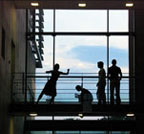
A Collision of Politics, Ethics and imagination
This international Science and Art Conference challenges the serene vision of art and science as a warm, fuzzy continuum and asks instead what really happens when different perspectives, expectations, interests and languages converge. Presented by Arts Council England, Yorkshire in partnership with CNAP, a bioscience research centre at the University of York, it will take place September 5-7, 2005 at University of York.
Art and science each hold the allure of a powerful cultural 'other'. Artists wish to appropriate science, scientists to harness art, for the benefit of their own practices. To what extent can this desire be collaborative or mutually beneficial? [see also Artists on Science: Scientists on Art, Nature, Vol. 434, No. 7031 pp293-324.]
When artists are natural transgressors and scientists trained to be cautious, are there risks as well as benefits? What happens when science is taken out of the lab, away from its safety procedures and cultural assumptions? Do artists have any responsibility towards scientific data, how it is manipulated and presented? In its interplay with science, is art contributing to knowledge, creating meaning or on a quest to change the world?
In this collision of politics, ethics and imagination--spanning ecology, bioscience and deep space--what are the Rules of Engagement?
Speakers and participants include: Andrew Stones; Lloyd Anderson (British Council); Oron Catts (SymbioticA); Nicola Triscott (The Arts Catalyst); David Buckland (Cape Farewell); Lise Autogena; Josh Portway; Brandon Ballengée; Adam Zaretsky; Lucy Kimbell; Simon Gould; Ian Hunter (Littoral); Jo Joelson (London Fieldworks); Darren Wright (Radio and Space Plasma Physics Group); Comma Press; Dianna Bowles (CNAP); Ruth Ben-Tovim; Lizzie Coombes; Andrew Cleaton; Lucy Cullingford; Lizz Tuckerman; Andy Gracie (Hostprods); Andrew Webster (SATSU)
Delegate fees: £165 full, £75 concessions (including refreshments, meals, accommodation and events). Prompt booking is advised.
For further information, please contact Arts Council England, Yorkshire:
Rachel Chapman, Science and Art Coordinator Email: yorkshire.science[at]artscouncil.org.uk
or Chloe Smith, Assistant Officer Tel: +44 (0)1924 486215
Posted by jo at 10:14 AM | Comments (0)
Brides of Frankenstein
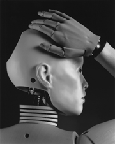
Animating Synthetic Creatures
Brides of Frankenstein will exhibit experimental work by a new generation of female artists working with video, installation, robotics, the Internet, computer animation, and other digital and traditional media, to animate synthetic creatures with virtual life. Presenting visually and conceptually compelling pieces by approximately fifteen artists, the exhibition will survey the diverse ways contemporary women artists animate synthetic creatures to investigate a range of humanistic and aesthetic concerns.
Creating living or lifelike creatures—often, the “ideal” woman—from inanimate materials has traditionally been viewed in Western culture as an exclusively male enterprise. Brides of Frankenstein challenges the notion that men are the prime movers in the project to fabricate animated, lifelike creatures (and by extension, art). It suggests that the impulse to create is more universal.
In Brides of Frankenstein, the artists are the “brides." As metaphorical consorts of Mary Shelley’s fictional, and archetypal, Dr. Victor Frankenstein, they engender lifelike creatures. Like his, their artificial progeny embody complex responses to the human implications of the technologies they use. Their projects incorporate critiques of the unreflective hubris that motivated Dr. Frankenstein, and explore the profound social, cultural and moral issues his activities raise. But they also address the potential for transformation and inquiry, and the new forms of identity, perception, movement, presence, representation, meaning and expression, that new technologies allow.
Participating artists include: Andrea Ackerman, Peggy Ahwesh, Erzsebet Baerveldt, Kirsten Geisler, Elizabeth King, Heidi Kumao, Kristin Lucas, Amy Myers, Patricia Piccinini, Sabrina Raaf, Tamara Stone, Camille Utterback, Gail Wight, and Adrianne Wortzel.
Posted by jo at 09:56 AM | Comments (0)
Printball
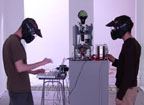
Recyclism, aka Benjamin Gaulon
"I urge you all to go and check out the work of Recyclism, aka Benjamin Gaulon, fantastic stuff. Here are two projects that I want to post separately. The first is Printball. Imagine an inkjet printer, but instead use a paintball gun and shoot dots at a wall to print the image. Created using Max/MSP and an Atmel board. There is a good 32mb mpeg4 to download (in the projects section). I (also) introduce you to The Res® (Recycling Entertainment System). 6 NES controllers, midi signals and Max/MSP allow players to jam together. There are 4 videos in the project section of the Recyclism site. [via]. Digital Recycling was Spotlighted on Turbulence in 2004.
Posted by jo at 08:58 AM | Comments (0)
ELO’s Born-Again Bits Released
![]()
A Framework for Migrating Electronic Literature
Following up on its pamphlet Acid-Free Bits: Recommendations for Long-Lasting Electronic Literature, ELO has released online Born-Again Bits: A Framework for Migrating Electronic Literature by Alan Liu, David Durand, Nick Montfort, Merrilee Proffitt, Liam R. E. Quin, Jean-Hugues Réty, and Noah Wardrip-Fruin. Part of a continuing series of publications by ELO’s Preservation, Archiving, and Dissemination (PAD) initiative, Born-Again Bits is a white paper that presents a conceptual, technical, and institutional framework for imagining how electronic literature — more experimental and harder to preserve than many other kinds of digital materials — can follow standards-based paths of migration into future technical environments. Two main kinds of migration strategies are addressed under the titles: “Interpreter Initiative” and “X-Lit Initiative.” (For a printed copy of this publication, contact Carol Wald at ELO.) [via]
Posted by jo at 08:31 AM | Comments (0)
August 04, 2005
Call for participation:
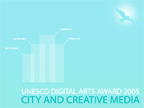
UNESCO Digital Arts Award 2005
Young artists from around the world are invited to take part in this year’s award devoted to the theme of "Cities and creative media." Organized in collaboration with Art Center Nabi, the Award would be delivered to non-realized project proposals in order to embrace a wider audience of creators, who have the innovative artistic ideas but not necessarily the means.
The call specifically aims at encouraging young emerging artists to cultivate new forms of expressions using new media and technology in reflecting on how urban spaces and city environments could be transformed into creative outlets.
The submission deadline is 14 September 2005. All project proposals should be submitted online at the official website of submission, where participants will also be able to find further detailed information (description of sub-themes, general guidelines, submission criteria, etc). All submissions should be in English.
The total prize money is US $10,000, which would be divided into and given to more than one laureate, in some cases a group of artists. In addition, the Nabi center (Seoul, Republic of Korea) is organizing a “special honorary mention” category to the Award, targeting realized projects that could be re-embodied within the urban context of the city Seoul.
The award-winning projects would be selected by an international jury, assembled on this occasion representing the five geo-cultural regions (Africa, Arab States, Asia/Pacific, Europe/North America, and Latin America/Caribbean).
For more information, contact: unesco_award[at]nabi.or.kr; digiart[at]unesco.org. UNESCO DigiArts portal.
Posted by jo at 07:20 PM | Comments (0)
Virtual Playa Project
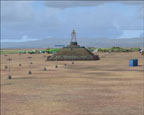
Burningman Cybercamps
The VIRTUAL PLAYA PROJECT is a navigable 3d digital Burningman environment using Microsoft Flight Simulator as a platform. It is intended to be an open-ended project that invites participation at various levels. It can be downloaded for home use; played on a giant screen at a Burningman event, or even be used as a design tool for a theme camp or artist wishing to plan an installation before it ever gets to Black Rock City.
The ultimate wish for the project however, is for the Virtual Playa to be the Burningman Cyber Regional. Using multi player technology, it can become a portal through which we can meet on line, and share experience with other cyber burners from anywhere in the world in real time. This takes the project from just being a cool piece of collaborative digital art, to a true meeting place for the cyber-tribe. Download it for free, copy it, send it to pals, leave it on buses, give it away as a gift.....spread the word.
Posted by jo at 07:01 PM | Comments (0)
EA's m/M
Six Hour Continuous INSTALLATION-PERFORMANCE
EA's m/M: [1] As computers keep offering us the ability to play with numbers in increasingly complex ways, our perception of proportional relationships is being exponentially challenged. We begin to realize our involvement in a ubiquitous hyper-game where reality fades into its own representation. [2] Even time is no longer regarded as an absolute parameter to which safely anchor ourselves. With the realization of these, ever-shifting dynamics comes the desire to take on an active role and to start interacting with the idea of relative magnitude, and with the way in which we perceive proportions. Microphones and amplifiers, optical lenses and projectors are some of the instruments that make it possible for us to monitor, analyze and redefine ourselves within our environment. Such technical tools, as well as philosophical hypotheses, are abundant and allow us a wide range of exploratory possibilities.
This exploration is the scope of m/M, EA's installation/performance in Williamsburg's Galeria Galou and its surroundings. During six hours, sounds and images will be collected from near and far, processed and re-presented in our first attempt to formally engage with the fluctuating interface that lies between the micro-bound and the macro-bound. An empirical test bench equipped with various electronic devices will be installed inside the snug space of the gallery. Its function will be to collect and process the sensorial information and to send it back to the outside world - the gallery's bare industrial surroundings and further on, eventually reaching EA member Andre Goncalves who will participate to the event via Internet connection from Lisbon, Portugal. Guest sound artist Brendan Murray, visiting from Boston, will provide yet another "outside perspective" to be internalized in the performance. Rather than a specific sound or an image, EA's piece will be constituted by the whole machine/environment. m/M is the whole functional apparatus designed to create dimensional loops and to attempt a short-circuiting of the conceptual extremities of inward and outward subjective planes. Passers-by will be attracted to the core of the performance space, and encouraged to participate in this empirical and expansive process.
EA is Gill Arno, Richard Garet, Andy Graydon, Andre Goncalves (performing from Portugal via internet), Brendan Murray (special guest from Boston) and Gil Sanson.
Galeria Galou: 237 Kent Ave. (bet. North 1st and Grand), Williamsburg, Brooklyn, NY 11211. Take the L train to Bedford - about 5 minutes walk from the train. Tel: 718-486-3730
Posted by jo at 12:14 PM | Comments (0)
Sending and Receiving
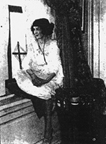
The matrix...net of all nets
"...Indeed, radio — and therefore the beginning of all electronic mass media — is invented by receivers, not by broadcasters. One might modify Duchamp's famous quote that the onlookers make the pictures: "Ce sont les récepteurs, qui font les médias." And even though today it seems as if the broadcasters alone possessed all power over the mass media, there is an almost anarchical criterion, on which all is based and in which the power of the receivers has been preserved: In TV ratings are everything.
How could the power of the receivers be great enough to turn the entire media machine upside down and change it from a strategic into a distributive system? What fascination initiated all that constitutes our present-day electronicized worldview?..." From Sending and Receiving by Dieter Daniels, tout-fait, issue 2. [via]
Posted by jo at 12:06 PM | Comments (0)
Radio_Copernicus

Commissioned Works
Radio_Copernicus @ garage, Stralsund, July 15th – August 21st on 93,0 FM Stralsund. Commissioned works:
Radio the Receiver by Robert Piotrowicz: Wednesday, 27.7.2005, 20.30. "Radio the Receiver" is an electro acoustic composition, which works with sounds, which are lost in the linearity of radio transmission. Besides all the voices and stations on the ether there are sites of fracture of technical perfection, which are adopted by Robert Piotrowicz. Where the listener can’t influence the transferred signal or can elude the signal only by leaving the wave band itself, "Radio the Receiver" transforms the passivity of the radio listener into a process of creation.
"Radio the Receiver" creates a new ether made up of unidentified noises, distorted transmissions and those particles of the transmission signal, which do not contain information. The soundscape recordings are partly processed with an analogue modular Synthesizer, partly left in their shape. The composition distillates a narration from the infinity of information, which is contained in the radio signal, a narration which gives voice to the therein hidden and to the aesthetics of the sounds, the signals and their dynamics.
Two Way Radios (2WR) by Guy van Belle: Thursday, 28.7.2005, 20.30--“Two Way Radios (2WR)” is a project of the Belgian Guy von Belle, who develops multimedia-technologies for artistic use since 1990. He works with several bi-directional audio streams for “2WR”. Four performers (Guy van Belle, mxHz.org, Akihiro Kubota, Tokyo, Barbara Huber, Linz, Aymeric Monsoux, goto10.org Rotterdam) generate and mutually change their 4 Livestreams and thereby tie up to the manifold history of artistic radio utopias. In spirit of these utopias radio shall create a simultaneous connection between the here and the elsewhere, establish communication and response in both directions. [Related]
The Future Of Radio Art by LIGNA: Friday, 29.7.2005, 16.00--The group LIGNA from Hamburg designs experimental situations, which use the potentials of radio that are inherent to this medium, but which are forgotten and ignored. With “The Future of Radio Art” the radio-activist group conceives a 55-minutes radio play, which works at the same time as a discourse on radio and as a performative intervention in public space. The radio play (German/English) broaches the issue of “radio” and is about that listening to radio always changes the situation in which it happens. It deals with the constellation of listeners created by radio and the potentials of these constellations. It will recommend simple exercises to the listeners to help them to comprehend these potentials of radio. The performative part takes place in the pedestrian area of Stralsund. There the broadcast becomes audibly scattered and thus the acoustic situation in public space is changed.
P. und Wolf (Die Theorie des Durchschnittlichen) by Tomasz Gwiñciñski. Wednesday, 3.8.2005, 20.30--Tomasz Gwiñciñski ties in the Polish tradition of readings and radio plays with “P. und Wolf (Die Theorie des Durchschnittlichen)“ (P. and the Wolf. The Theory of the Average). It is a musical fairy tale, which is assembled on dialogues between instruments, but refers also to the use of voices and noises in old Polish child records published in the 70's and 80's as sound radio plays. The pre-produced composition is realized by a chamber orchestra, Elektronica and a voice. Krzysztof Gruses "Die Theorie des Durchschnittlichen" contributes the text basis.
Der Versuch über etwas anderes als mich selbst zu sprechen by Marc Degens/Jarek Grzesica: Tuesday, 9.8.2005, 20.30--"Der Versuch über etwas anderes als mich selbst zu sprechen" ("The attempt to speak about something else than me"), a text by the Berlin author Marc Degens meets the sound world of the Polish sound artist Jarek Grzesica. The text tells three small episodes of the childhood of a boy in the 70's/80's. In three situations the boy meets other people on the roads or in his neighbourhood. Obviously these meetings play an important role in his growth. Recordings of the text in German, Polish and English are the basis of Jarek Grzesica's work, who arranges three versions and integrates them into his sonic material.
Energistic Radio by Michal Górczyński, Jan Duszyński, Tomasz Duda; Wednesday, 10.8.2005, 20.30--The radio performance “Energistic Radio” is a 50-minutes cooperation of the young polish composer and improviser Michal Górczyński with the composer and interpreter Tomasz Duda. What begins sonically as an abstract radiostudio, develops into a piece of improvisation, whose scenario is based on Michal Górczyński’s „Energistic Manifesto”. Inspiration from different music directions, noises of everyday life and the sonic characteristics of certain geographic areas are processed in a way, that the listener is able to recognize already well-known within the plentitude of the sound material. According to the „Energistic Manifesto” this happens on a level, which wants to approach to the sources of inspiration on an emotional level. „Energistic Radio” merges thereby the listener into the sound world of the medium radio in a subtle way and creates connections beyond an attitude of perceiption, as it is promoted in format radio: being only offered sounds which could easily be deciphered.
Posted by jo at 11:14 AM | Comments (0)
Capture the Flag
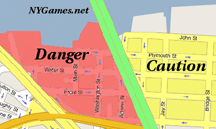
TONIGHT!
Since many of you love the game of Capture the Flag so much we are playing it again, in DUMBO. Just take the F train to York street or simply meet at the corner of Jay and York. The Map is the playing grounds. Bridge street remains neutral territory. Meeting time is at 7:30pm. Game starts at 8pm, this Thursday, 8/04/2005. Remember, the game is cellphone enabled, so bring one! Rules will be provided at the game. Hope to see you all on Thursday!
Posted by jo at 09:46 AM | Comments (0)
Nomadology in Architecture:
Ephemerality, Movement and Collaboration
"ABSTRACT: This thesis investigates the theoretical and practical importance of nomadic ways of life for architecture. Nomadology is a construction of Deleuze and Guattari's 'counter-philosophy', challenging authenticity and propriety, in this case, in the context of architecture. This thesis describes how nomadology may serve contemporary architectural practice and criticism; challenging static, permanent, and heroically solitary ways of working and dwelling. Nomadology in architecture proposes ways for thinking and working temporally, dynamically, and collaboratively. The thesis suggests strategies – diagramming, ephemerality, movement, and collaboration – as ways of reconciling nomadism and architecture..." From Nomadology in Architecture: Ephemerality, Movement and Collaboration by Gregory Cowan [via]
Posted by jo at 08:51 AM | Comments (0)
Hyperfabric
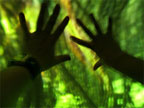
Haptic Magical Mystery Tour
The Hyperfabric fabric-based interface lets you reach beyond the screen. This "touchable" touchscreen, made out of an elastic latex-like fabric warps like rubber, and can sense how hard your press it, where you press it, even when several people use it at once. It feels like you are going "through" the screen.
You can press, grab, twist, punch and play with the screen. It can even support your full bodyweight. The Hyperfabric screen is specially designed to communicate with a computer to generate interactive computer graphics, in realtime.
Adam Montandon and the team at HMC MediaLab created a 7 feet high Hyperfabric installation for the Artytechs parlour this summer at the Port Eliot literature festival. Taking place in a hidden dungeon underneath the stately home, visitors had the chance to come face to face with the magical and mysterious interactions. [blogged by Regine on we-make-money-not]
Posted by jo at 08:28 AM | Comments (0)
August 03, 2005
Pico-Peering

Building the Community Wireless Uber-Network
Imagine a wireless network stretching from Kladno to Buenos Aires; from London to Johannesburg; from Urbana-Champaign to Sydney; to more and more places around the globe. Beginning in 2000, a group of dedicated community wireless developers sat down to figure out a way for a heterogeneous group of Community Wireless Networks to cooperate and affiliate. FreeNetworks.org has led the way — crafting a simple, accessible, 1-page “Pico Peering” agreement that any free network can adopt. I bring this up, not because it’s a new idea (in fact, it’s been pondered, discussed, revised, and refined over multiple years), but because it offers an opportunity for the myriad wireless networks to collaborate. [via MuniWireless]
Posted by jo at 01:02 PM | Comments (0)
Ramesh Raskar
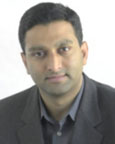
Spatial Augmented Reality
The goal of Augmented Reality (AR) is to insert computer-generated virtual objects in the real world and the challenge is in creating an illusion of consistency between the real and the virtual environments. Traditional AR approaches involve head-mounted, eye-worn or hand-held displays. But we can draw parallels between the displays techniques used for virtual reality (VR) and AR, and speculate about the alternative approaches for AR.
In this talk--Friday, August 5th, 10am-12pm--Ramesh Raskar will discuss new practical alternatives using spatially augmented displays. The spatially augmented reality (SAR) approach exploits video projectors, cameras, radio frequency tags such as RFID, large optical elements, holograms and tracking technologies. The underlying techniques in SAR overcome some of the annoyances of the eye-worn AR in authoring, identification and image registration. He will discuss enabling techniques and describe our experience with applications in industrial maintanance, entertainment, art, education and various forms of human computer interactions.
Ramesh Raskar joined MERL as a Research Scientist in 2000 after his doctoral research at U. of North Carolina at Chapel Hill, where he developed a framework for projector based displays. His work spans a range of topics in computer vision and graphics including projective geometry, non-photorealistic rendering and intelligent user interfaces. Current projects include composite RFID (RFIG), multi-flash non-photorealistic camera for depth edge detection, locale-aware mobile projectors, high dynamic range video, image fusion for context enhancement and quadric transfer methods for multi-projector curved screen displays.
Dr. Raskar received the TR100 Award, Technology Review's 100 Top Young Innovators Under 35, 2004, Global Indus Technovator Award 2003, instituted at MIT to recognize the top 20 Indian technology innovators on the globe, Mitsubishi Electric Valuable Invention Award 2004 and Mitsubishi Electric Information Technology R&D Award 2003. He is a member of the ACM and IEEE. [via]
Posted by jo at 10:18 AM | Comments (0)
Hitching Stealth with Trevor Paglen
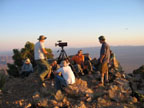
Experimental Geographer
"...Experimental lecturer and all around academic outlaw Trevor Paglen is a new breed of researcher for the University of California at Berkeley. He has been more aptly called by his peers an underground geographer, armed with a telescope, a GPS device, some light field military listening equipment, a car trunk full of cameras and maps, and one hideously nondescript corporate infiltration suit. Swapping between his other outfits as an intervention artist, and investigative journalist, a prison-abolition activist, punkrocker and total sound head, not to mention a third degree master in the art of panoptic trespass, he takes a wildly experimental approach to studying the strategic and practical boundaries of contested public/private space.
Altogether, he's concocted his own strain of what he prefers to call 'experimental geography' that he uses to trace the immense networks of undisclosed borders, shadow lairs and underground finanscapes edified by corporate, state and national defense collusion..." From Hitching Stealth with Trevor Paglen; Text by Bryan Finoki/Photos by Trevor Paglen, Bryan Finoki, & Bill Luoma, Archinect. (2005) [via]
Posted by jo at 10:12 AM | Comments (0)
INTERACTIVE FUTURES 06:

Audio Visions
CALL FOR PAPERS, PANELS, PERFORMANCES, & INSTALLATIONS
INTERACTIVE FUTURES is a forum for showing recent tendencies in new media art as well as a conference for exploring issues related to technology. The theme of this year's event is Audio Visions. IF06 will explore new forms of audio-based media art from a diverse body of artists, theorists, and sound practitioners. Sound poetry, web-based audio and multimedia, mobile audio performance, new forms of music theatre, synaesthetic performance, hybrid forms, sound-based installation, video and sound, and environmental sound are all of interest to Audio Visions.
The proliferation of audio technologies, audio-visual collaboration, and hybrid forms of live performance in the new millennium is striking. Audio artists are exploring the areas of mobility, virtuality, performance, and audience interaction from an experimental point-of-view. Audio Visions invites scholars, sound-artists, and performers of all stripes to submit paper, panel, performance or installation proposals in one of the three following categories.
1. "Sound and Vision" lecture and panel series - Scholars, artists, and practitioners working in audio or audio-visual-based new media are encouraged to submit proposals for IF06. We are interested in a broad range of audio including: computational, interactive or generative audio; the creation of digital audio tools; synchronization between sound and visuals; performative art that explores language, voice and body; streaming radio and mobile sound works. Presentations should be, in part, demonstrative. We recognize that sound art is evolving and that categories have become increasingly irrelevant - we encourage proposals that push the boundaries of the traditional conference paper.
2. "Earshot" performance series: "Earshot" is seeking experimental audio-based performances that challenge assumptions about audio forms and performance conventions. Avant-garde, post-avant-garde, techno, electro-acoustic, synaesthetic production, liminal art and hybrid performance are all within our desired range. "Earshot" is primarily interested in new types of electronic audio-visual performance as well as models for audience participation in sound works. "Earshot" will run performances at Open Space for each night of IF06.
3. "Tangible Frequencies" installations. We are interested in audio installation works that consider site, space, vision, volume and perception and how physical location 'matters' to the reception of audio frequencies. IF06 has identified areas within Open Space Gallery to function as controlled locations for sound installations.* We welcome proposals that respond to the particular characteristics of these locations through their acknowledgement of private and/or public space and use. Installations may provide audio continuity to the existing locations, or respond as intervention and critique.
INTERACTIVE FUTURES is part of the Victoria Independent Film and Video Festival and applicants are encouraged to check the Festival website for more information on the broader program.
CONFIRMED SPEAKERS / ARTISTS
Greg Hermanovic of Derivative software is a visionary software-engineer involved in the creation of real-time visual tools. In 2003 he received an Academy Award for the pioneering of modeling in the film industry with PRISMS and Houdini. Greg coordinated the realtime animation at SIGGRAPH 98's Interactive Dance Club, and directed special effects for Michael Snow's Corpus Callosum. Derivatives Touch software, a range of tactile interfaces, brings advanced realtime animation tools to a diverse cross-section of artists, including Richie Hawtin and Rush. Greg will perform live visuals with Toronto-based DJ Tom Kuo.
Tom Kuo uses a grounding in techno to pursue a varied range of precise electronic strains. Tom was recently named one of Toronto's Top Ten DJs by NOW magazine.
Atau Tanaka is known for his work in interactive music, including performances with biosignal gesture systems. He has conducted research at IRCAM in Paris and was Artistic Ambassador of Apple Computer Europe. His work with sensor-based musical instruments and network audio installations have received prizes and support from Ars Electronica, the Fraunhofer Institute, the Japan Foundation, and the Daniel Langlois Foundation. His current research at Sony CSL Paris focuses on harnessing collective musical creativity on mobile devices.
J=FCrg Gutknecht is a computer scientist with a passion for new hybrid art forms. He has actively participated in culturally-oriented "wearable computing" projects, including "Instant Gain in Grace" (motion tracking of a Butoh dancer), "Going Publik" (distributed orchestra based on mobile electronic scoring), and "On the Sixth Day" (multi-channel video system for interactive storytelling). Together with Sound Artist, Art Clay, he organizes the Digital Art Weeks which offers performances and provides courses in the areas of computer-aided art and music.
Art Clay is a specialist in the performance of self-created works with the use of inter-media, and has appeared at international festivals. Recently, his work has focused on large-scale performative music-theater works and public art spectacles using mobile devices.
Jim Andrews publishes vispo.com. It is the centre of his work as a visual poet, audio artist, programmer, and critic. His work in interactive audio and word-based web media has been published and shown widely in such venues as turbulence.org, rhizome.org, and the trAce Online Writing Centre.
SUBMISSION GUIDELINES
INTERACTIVE FUTURES is interested in artistic and theoretical work that relates to audio performance, production and hybrid forms.
Papers, Panels, and Presentations can include DVDs, audio CDs, video tapes, games, web-sites, etc. and should be 45-minutes in length. Proposed artwork for exhibition may take the form of performances ("Earshot"), installations ("Tangible Frequencies"), or audio-related screenings ("Earshot" or "Tangible Frequencies"). Applications should not exceed 500 words. Applicants should indicate one of the three festival categories in the subject of the message. Please include a 200 word max bio. All proposals must be submitted in text only format either as an attachment or within the body of the email message. Please present examples of your work as a URL to a web-site. If your presentation requires specific technologies please describe your needs in detail.
Proposals should be submitted electronically to ONE of the following persons:
"Sound and Vision" lecture and panel series - Randy Adams runran@runran.net
"Earshot" performance series - Steve Gibson sgibson@finearts.uvic.ca
"Tangible Frequencies" installations - Julie Andreyev lic@telus.net
* SPECIAL NOTE FOR INSTALLATION ARTISTS APPLYING TO TANGIBLE FREQUENCIES:
Open Space has the following areas available to install sound installations:
Parallel gallery (opens onto the street)
Bathrooms (2)
Back Stairs (opens onto the back alley)
Main gallery (low volume or headphones only)
A floor plan for Open Space can be downloaded at
http://www.openspace.ca/img/floorplan.pdf
Please indicate a preference for one of the above areas in your proposal. Artists should keep in mind that Open Space is a shared space and therefore low volume will be required. Other venues may be organized by special arrangement if louder volume is required.
FUNDING
INTERACTIVE FUTURES does not have funding for travel or accommodation. Presenters and artists are expected to apply for travel funding from their home institutions and/or granting bodies. INTERACTIVE FUTURES is applying for funding for performance and installation artists exhibiting at Open Space. If this funding is obtained, performance and installation artists will receive a modest fee according to CARFAC (http://www.carfac.ca/) regulations.
All presenters and artists will be given a pass to all INTERACTIVE FUTURES events and will have access to the Hospitality Suite at the Festival hotel (food and drinks). All presenters and artists will be eligible for the conference rate at Festival Hotels (between $40-110 per night).
DEADLINE FOR ALL PROPOSALS: Friday, September 23, 2005.
Notification of acceptance of proposals will be sent out on or before October 7, 2005.
EQUIPMENT ACCESS
Laurel Point Inn--Presentations
The following equipment will be made available for all presenters:
Mac computer with Monitor, keyboard, DVD/CD-ROM drive.
Data/Video Projector.
VHS Player.
Sound system with amp and two speakers.
Wireless high-speed internet access.
Open Space--Performances and Installations
The following equipment is available for artists at Open Space. Artists should be aware that equipment will have to be shared and therefore should not propose to use all of the below devices simultaneously. Installations and performances should be easy to set-up and take down. Wherever possible artists should apply their own technology.
2 Data/Video Projectors.
VHS Player.
DVD Player.
3-4 Macintosh computers.
Sound system with amp, 16-channel mixing board, mics, and four speakers.
Cable modem internet connection.
For a full list of resources available at Open Space go to: http://www.openspace.ca/space/resources.htm
CONTACTS:
Victoria Independent Film and Video Festival Director: Kathy Kay director@vifvf.com
INTERACTIVE FUTURES Co-Curators: Steve Gibson sgibson@finearts.uvic.ca; Julie Andreyev lic@telus.net
INTERACTIVE FUTURES Paper Editor: Randy Adams runran@runran.net
OPEN SPACE New Music: Tina Pearson newmusic@openspace.ca
Victoria Independent Film and Video Festival
Co-sponsored by Open Space Artist-Run Centre
Parallel event Digital Art Weeks, Summer 2006, Swiss Federal Institute
of Technology
Conference hotel - Laurel Point Inn
Victoria Independent Film and Video Festival:
Mailing Address - PO Box 8419, Victoria, BC, V8W3S1, Canada.
Office Address - 808 View Street, Victoria, BC, V8W1K2, Canada.
Tel: (250)389.0444. Fax: (250)389.0406. E mail: festival@vifvf.com
Posted by jo at 08:43 AM | Comments (0)
The age of surveillance:
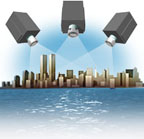
a new "dot com boom?"
The age of surveillance: a new “dotcom boom”? by William Davies 2 - 8 - 2005, [via sarai]: Will the era of digital networks and terrorism produce the worst of both worlds: a society of mass surveillance that increases insecurity? William Davies maps a new political-technological frontier.
"The most important lesson that marketers and futurologists can learn about new technologies is not to extrapolate too far from the “early adopters”. Be it cars, telephones, televisions or computers, the long-term implications of new tools are never apparent at the outset, but only emerge once they have become ubiquitous across society. [Related 1, 2, 3 and more]
The car began life as a rich man’s toy, but its most profound long-term consequence was the growth of suburbs. The television was initially an object of fascination for the family to congregate around, rather than the perennial and solitary experience that it has become for many individuals. In recent years, we’ve witnessed what happens when mobile phones and internet connections shift from the margins of society to the mainstream.
Marketers use the term “tipping-point” to describe the moment when a product makes the transition from being unusual and eye-catching, to being pervasive and invisible. One minute an item is being paraded like a trophy, of rarity and novelty value. The next it is a necessary accoutrement, without which modern living would seem impossible.
The language of “early adopters” and “tipping-points” is generally used when looking at the fast-moving though ultimately frivolous world of consumer habits. But perhaps we can identify something analogous to a tipping-point that took place on a more historically significant level, around five years ago, in the eighteen months that followed the dotcom crash.
Speculation about the shape and politics of the “digital age” had been rife for decades. The tipping-point in question occurred between the collapse of the Nasdaq and that of the World Trade Center, when one narrative about the function of digital networks in our society stuttered to a halt, and another one emerged. The underlying purpose of mass digitisation changed.
Same technology, different story
The purpose of digital networks is not something that the IT industry likes to dwell on too much. It is very often quite happy letting hype sell its products for them. But one doesn’t need to scratch beneath the surface too far to recognise that the Bill Clinton era of the “information super-highway” and stock-option millionaires was driven by a very different type of sales-pitch than the George W Bush era of iris-scanning and data retention. An economic narrative of wealth creation has been firmly replaced by a political narrative of control, yet each is rooted in the same technologies.
In the wake of the London bombings of July 2005, the pessimistic question has to be asked: did that period between April 2000 and September 2001 represent a tipping-point? As moronic and greedy as the dotcom boom and its associated fripperies may have been, there was an innocence about all of that investment and innovation, as if the benefits would flow later somehow or other.
But having been drawn into the digital age by the allure of its newness – just like any “early adopters” – we may now be settling down into a surveillance society where privacy is at best conditional, and contingency is monitored and dealt with. Historians may one day reflect on the bizarre coincidence by which westerners exuberantly flooded their societies with digital technology for very little reason whatsoever, just in time for it to be put to use as part of the largest international policing programme ever.
This is not to say that the economic narrative for digital modernisation never stacked up at all. There are plenty of areas where businesses and public services have been made more efficient or effective, but there are also many that have fallen at the hardest hurdle of innovating the social and managerial processes through which productivity gains are made.
Compared to the surveillance possibilities that this infrastructure has opened up, the business case for pervasive computing looks comparatively weak. After the first London attacks on 7 July, the British home secretary Charles Clarke defended plans to track internet and email records, saying: “the more we can survey the way in which people operate, the way in which they make their phone calls, the better your chance of identifying patterns of behaviour which are a threat.”
The IT industry will be relatively unconcerned by this transition. Like the stock markets, technology companies are unlikely to do much more than shrug, and shift additional capital into biometrics and out of e-commerce. In academic departments, meanwhile, debates between Nietzscheans and Marxists, which dominated 20th century European philosophy, seem to have been won for the time being by the former. Marxists such as Giovanni Arrighi struggle desperately to explain how contemporary politics is still explicable in terms of the logic of capitalism, but common sense suggests that, à la Nietzsche, it is far easier to explain in terms of the primeval desire for control.
So were we duped by the story about the “information society” and the “digital revolution”? Many companies certainly feel so, and as these digital networks become a growing battleground between extremists and internationally coordinated police forces, many citizens may be wishing we could turn the clock back. As one blogger, Lee Maguire, jokes grimly on his website:
“Homepages, eh? I've always suspected there was a huge 'Big Brother' database containing everyone's private details ... and now I'm responsible for writing my own entry.”
The high-tech
Both libertarians and capitalists – always fairly comfortable bedfellows –have been pushed to the margins of the digital age for the time being. The worry, but also in a way the hope, is that we will now charge headlong into a high-tech surveillance society. Why is this both a worry and a hope? Because it won’t work. In fact it could potentially make our security situation worse.
As the American security guru, Bruce Schneier puts it:
“technology will continue to alter the balance between attacker and defender, at an ever-increasing pace. And technology will generally favour the attacker, with the defender playing catch-up.”
Ever more complex technology can not only produce new security threats, as the internet itself has demonstrated, but also create distractions for security services, as they become more focused on spotting patterns in complex systems, and less on human judgment.
It could be that we are about to enter the equivalent of a dotcom boom in surveillance technologies. There will be no shortage of suppliers eager to join in, even if they hesitate to become too openly enthusiastic about this bubble compared to the previous one. But a boom would inevitably be followed by a crash in confidence in technology. Just as companies discovered that productivity gains depended on improving their social processes, and not on infrastructure alone, security services will have to learn the same lesson. The question is whether they will have to go through the same painful process of boom and bust to get there.
The primary hope must of course be that terrorism is dealt with effectively, which will be a political feat not a technological one. In the same way that we hope we have not entered a sustained era of terror, we must also hope that surveillance, tracking and pattern-spotting does not turn out to be the long-term role of digital networks in society. If police forces and governments put their faith in IT and under-invest in social capabilities in the same way businesses did a decade ago, they will get the same nasty shock as those businesses did. But then, hopefully, another phase of the digital age might begin."
William Davies is a senior research fellow at the Institute for Public Policy Research (ippr), and author of a new report, Modernising with Purpose: A Manifesto for a Digital Britain.
Posted by jo at 07:55 AM | Comments (0)
August 02, 2005
Mirror
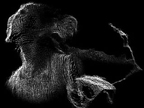
Interact with Your Own History
The excellent United Visual Artists have recently created their first gallery installation titled Mirror, showing at the Kemistry Gallery in London 2nd - 30th August. "UVA's first gallery installation, Mirror inhabits an area between portraiture, sculpture, and the motion studies of pioneers such as Eadweard Muybridge. A stereo camera pair creates a moving three-dimensional image of the viewer, projected in real time into the space.
Snapshots of the space are combined to create a fluid history of all movement in the space. A viewer can therefore interact with their own history, creating new spatial forms as if painting with their body. The scene is rendered from a shifting viewpoint, allowing the viewer to see themselves from unusual angles. At the same time, the stereo process introduces unexpected errors and distortions, forcing us to consider that the machine has its own way of seeing, and thereby foregrounding the limitations of our own perception". [blogged by Chris on pixelsumo]
Posted by jo at 10:42 AM | Comments (0)
Christopher Strachey:

The first digital artist?
"Christopher Strachey is rightly viewed as a pioneer of modern computing. He’s not usually, however, viewed as the creator of the first work of digital literature. Research toward my submission for DAC, however, has lead me to believe that he was — and that his initial digital literature project was also, quite probably, the first piece of digital art. I’d be quite interested to hear any thoughts (or refutations) from GTxA readers.
To begin with, however, I should explain that when I use the terms “digital literature” and “digital art” I mean something in particular by them." Continue reading Christopher Strachey: The first digital artist? by Noah Wardrip-Fruin and get involved in the discussion (blogged by Noah on Grand Text Auto].
Posted by jo at 10:29 AM | Comments (0)
August 01, 2005
R*Emote Mirror
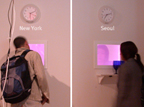
Hole in Space Update
R*Emote Mirror--by Yeonju Shim--is a pair of networked interactive lighting installations that creates communication between isolated people in urban cities and their loved ones who live far away. The telepresence installation re-creates feelings of togetherness and physically connected interaction between distances and spaces, allowing each person to interact through the expression of his or her movement. r*Emote Mirror has two functions: one is a mirror, and the other is interactive color lighting. Each r*Emote Mirror will have an initialized color representing the user, and trigger the movement of the person with different colors. When two persons stand at the same position in front of their installations, r*Emote mirror makes them see color changing and blending of their individual colors.
If you are living in Seoul and are close to the mirror, you can see your own shape on the panel in red light. At the same time, your friend living in new york can see your red color on his or her panel at home. if your friend is close to the panel, s/he can see his or her own body shape as blue light. If you are both in front of each mirror, the overlapping of color will hopefully evoke feeling of togetherness. For instance, if red overlaps with blue, it makes purple. [blogged by Regine on we-make-money-not]
Posted by jo at 11:35 AM | Comments (0)
Rob Shields
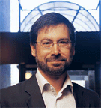
Thinking Space: Exploring the Social Dimension
"Even when we enter a physical space, we enter a virtual space as well; we cannot experience or comprehend any space without the filter of memory and consciousness. It is also, according to Shields, difficult to 'imagine futures which are other than the way things are.' How can the sociologist help in this process? When the warp and weave of the fabric of our lives becomes visible to us, we are able to see more clearly the values, power structures, rituals, and myths at play even in the supposed 'empty' spaces in which we circulate and live our lives. Then, Shields argues, we have a better understanding of where we, as individuals and as communities, stand in relation to those competing discourses, values, and power systems and how we are defined by them. Armed with this understanding of the virtual spaces in which we exist, we can be empowered to engage, resist and alter them, and perhaps then imagine a future which is just a little bit different than the way things are today..." From Thinking Space: Exploring the Social Dimension by Anne Bailey, University of Alberta's Work of Arts magazine, pp.4-5. [blogged by Rob on Space and Culture]
Posted by jo at 10:43 AM | Comments (0)
Surveillance
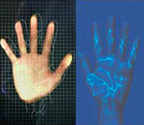
The Holy Grail Is A Universal Sensor
Here's the good stuff from a massive and chilling report on the future of surveillance from Business Week Online:
"Britain has 4 million video cameras monitoring streets, parks, and government buildings, more than any other country. London alone has 500,000 cameras watching for signs of illicit activity. [...]
Research laboratories envision tools that could identify and track just about every person, anywhere -- and sound alarms when the systems encounter hazardous objects or chemical compounds. Many such ideas seem to leap from the pages of science fiction: An artificial nose in doorways and corridors sniffs out faint traces of explosives on someone's hair. Tiny sensors floating in reservoirs detect a deadly microbe and radio a warning. Smart cameras ID people at a distance by the way they walk or the shape of their ears. And a little chemical lab analyzes the sweat, body odor, and skin flakes in the human thermal plume -- the halo of heat that surrounds each person. [...]
Camera phones, nanny cams, and even satellite photos are commonplace. Biological sensors are flooding into households in the form of tests for HIV, pregnancy, and diabetes -- some of which can relay data to a doctor -- and soon there will be far more sensitive DNA-based tests. Next up are radio-frequency identification (RFID) tags. They're showing up in stores to help track inventory, and 50 people in the U.S. have had them planted under their skin to broadcast their ID and medical data, in case of an emergency. [...]
One great worry is that those who stand out from the norm or express unpopular views, minorities, the poor, or just the ill-mannered, may get stomped in new and surprising ways. A recent incident in South Korea shows how this can play out. A subway commuter posted on the Internet some cell-phone photos he took of a passenger who had refused to clean up after her dog relieved itself during the ride. In no time, a vigilante mob on the Web identified her by her face and the purse she was carrying, and she became the object of national vilification. “You can move into a surveillance society one tiny camera at a time,” says Deirdre Mulligan, director of the Samuelson Law, Technology & Public Policy Clinic at the University of California at Berkeley. [...]
Experts disagree about when the most visionary tools to thwart terrorist acts will arrive on the market -- and whether they will deliver on their promise. Sensors that can detect bombs, radiation, and toxins exist today, and will be far more sophisticated a decade from now. But strewing them across every city in America would cost untold billions of dollars. High-tech electronic eavesdropping on communications networks can be effective, but only if terrorists use telecom systems. And even with improvements in cameras, biometric devices such as iris scans, bomb sniffers, and tracking software, it will be years before they can pick a terrorist out of a crowd. In short, the march toward a surveillance society may be inevitable, but no simple cost-benefit equation can assure us that the sacrifices will be worth it. We'll be debating the point for decades to come. [...]
In the quest to sort bad guys from good, scientists are poking ever more intimately at the core of each person's identity -- right down to the DNA. One day people's distinctive body odor, breath, or saliva could serve as an identifier, based on the subtle composite of chemicals that make up a person's scent or spit. [...] scientists are creating super-sensors to pick up myriad molecules released at low concentrations that constitute human scents, including carbon dioxide, acetone, ethanol, and sulfur. To capture them, they poke tiny pores into glass -- as many as 10,000 on a chip the width of a pencil eraser -- each tailored to the size of the molecule. Excited by a laser, the chemicals trapped in the pores emit different colors, and computers can then analyze the resulting pattern.
Dental researchers are attacking the challenges of identification and diagnosis from another vantage point -- the mouth. They're studying whether saliva contains markers for various diseases. If the technology works, it has additional potential for biometric applications, too. Spit contains many of the proteins, nucleic acids, and other substances that are found in blood. While they are present in fainter quantities, they can also be sampled less intrusively. [...] they can detect in human saliva some 3,000 messenger RNAs, molecules that carry genetic information within a human cell. These molecules perhaps can serve as markers for disease, or perhaps for identity, just like DNA. And they are often easier to detect. About 180 RNA markers are common across all individuals, but the remainder can differ. [...]
Biometrics bring a host of other troubles. As they become used more and more in office access, ATM passwords, passports, and ID cards, their value increases, and so do efforts to steal or spoof them. And because biometrics are cloaked in science, matches may acquire an unearned aura of dependability. Recently, cryptographers in Japan showed that common fingerprint-based systems can be easily duped using simple molds of melted Gummi Bear candies. [...]
Despite the many failings of biometrics, the federal government is encouraging scientists to fashion them into covert surveillance tools. Face recognition -- the most obvious way to track people because it's how humans do it -- is still dogged by problems matching images that may be distorted by a smile or ill-placed shadow. While scientists work out those glitches, others are improving iris-based technology for surveillance at a distance. Though computers can easily find eyes on a face, today's systems can't scan irises from afar as people rush through a crowd. [...]
Another hope is that certain characteristic movements may be recognizable at a distance. Taking a page from Monty Python's Ministry of Silly Walks, the U.S. Defense Advanced Research Projects Agency, the research body credited with inventing the Internet, funds work on software that could identify individuals by their strides. Researchers measure the silhouette of the torso, the swinging of the shoulders and legs, and the time it takes to move through a single step. [...]
The most serious privacy breaches are almost all linked to the proliferation of fast and inexpensive data processing and storage systems. The worst problems arise when each bit of information an individual gives up over the course of a day -- from the E-ZPass scans on the morning commute to the credit card purchase at Starbucks (SBUX ) to the logging of PC keystrokes at work -- get tied across various databases to create a detailed dossier of an innocent Joe's daily activity. [...]
This is just one of many measures that trigger a Big Brother alert. One of the hot buttons is eavesdropping. An emerging wireless technology called software-defined radio has the power to make cellular phones compatible with any network standard, but also opens new frontiers of snooping. The commercial merits of the technology are self-evident: Say good-bye to dead zones and lack of interoperability between police and firefighter radios. But the technology also enables superscanners that can be tuned to pick up the images on your neighbor's computer. That's possible because all computers emit stray radiation. With software-defined radio even amateurs could probably design equipment that could spot somebody porn-surfing in the next apartment. The technology can also make it easier to turn the cell phone of a spouse into a bug when it's not in normal use. [...]
Advances in many surveillance technologies piggyback on progress in fields such as wireless signal processing, nanotechnology, and genomics. Even plain old digital cameras are hotbeds of innovation. The imaging sensors in consumer cameras have been achieving ever-higher resolutions, while plunging in price. Because the gadgets are so engaging, crowds end up participating in surveillance efforts. Witness spectators holding cameras and phones aloft whenever news breaks -- an act that may aid investigations, or hold police misbehavior in check. [...]
Improved picture quality has given a boost to Viisage rival Identix Inc., allowing it to add in minute details of the skin to increase the accuracy of facial recognition. It divides a small area on the face into a 400-block grid, and then inspects each block for the size of skin pores, wrinkles, and spots. And using an infrared camera, researchers at A4Vision Inc., a Sunnyvale (Calif.) startup funded in part by In-Q-Tel, the CIA's venture fund, cooked up a 3D approach. Its system creates a topographical map by projecting a grid pattern of infrared light onto a face, and matching the features.
Strides in wireless signal processing are bringing the power of astronomical instruments to homeland security. Giant radio telescopes today listen to the faint energy waves emanating from stars billions of light years away. The first earthbound applications of this electronic wizardry will be airport scanners that scrutinize passengers' bags. The principle is simple: All matter gives off so-called background radiation, or millimeter-wave heat, whether it's a supernova or a switchblade. [...]
A kindred technology can “see” the molecular composition of matter using extremely short wavelengths of energy. When a machine made by Picometrix Inc. shines these terahertz waves on a target, its molecules resonate at a telltale frequency. One plastic explosive, for instance, vibrates at 800 gigahertz. T-rays pose no radiation hazard because they don't penetrate human skin. But people being scanned will appear naked on the monitor unless the system is programmed to cover up private parts. [...]
The Holy Grail is a universal sensor, small and cheap enough to scatter in public places, and smart enough to sniff out anything that comes its way, without being preprogrammed to find specific molecules. Nobody is close to that goal yet, but Sandia National Laboratories has designed a lab-on-a-chip that detects a variety of both chemical and biological agents. It has skinny microchannels etched in its surface. When a gas or liquid moves through the tiny pipes, it collides with special material, and how much that slows the flow betrays the identity of the fluid. Sandia is now developing this technology to monitor the Contra Costa County (Calif.) water supply.
U.S. Genomics Inc. in Woburn, Mass., claims that it is hot on the heels of a universal sensor. Its prototype uses particular molecules to tag important DNA sequences in the genes of lethal pathogens, such as anthrax. Then, primed with a fluorescent dye, those sequences light up, and a photo detector compares the pattern of illumination with a library of known bioagents." [blogged by John on Ratchet Up!]
Posted by jo at 10:20 AM | Comments (0)
Flexilis
![]()
Predict the Future by Inventing It
The fellows from Flexilis went for a world record attempt on reading RFID tags from a distance. The end result was a bit over 69 feet on top of the roof of DEFCON. Project details will be in our audio show, for now, a photo gallery of the gear....[via] [Speaking of world records, check out iFiber Redwire, winners of the Wifi Shootout Contest]
Every day new discoveries make it possible for hackers to steal data from mobile devices. You are at risk no matter what you carry. Cellphones. PDAs. Smartphones. All are potentially vulnerable to data theft.
Flexilis, Inc. starts as something simple and stunning: an idea. Through our collective vision and creative nurturing, the idea continues to grow, a concept metamorphosing into reality. The key to revolution is imagination; without it, change is impossible. By employing emerging technologies, flexilis possesses the potential to create entirely new industries or inexorably alter the course of existing ones. In short, we are capable of influencing the movement of technology, and, by extension, society itself.
Flexilis believes in the inherent necessity of taking controlled risks, actively seeking opportunities to create new markets and develop new avenues for implementation. The possibilities are restricted only by the limitations of our imaginations. flexilis will not only respond to the changes in emergent technology, but help to steer its course.
Posted by jo at 09:27 AM | Comments (0)
Isabella Bordoni
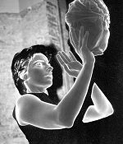
Language is the First Creative Act
"Isabella Bordoni: My first language is my body. Body is a language into temporal and spatial coordinates. I always felt and feel the need to enlarge my body's borders and explore the experience of sharing. A digital network is an enlarged body. In my entire work micro- and macrocosmos are engrafting one into the other, making thicker and thicker the grid of different glances. Everything appears, in its own nature, as being "point" and "place". Then, whatever creative act means: art for me is to create a place. To write, to walk, to follow a rhythm with words or music, whatever: the existence looks for a place to stay. A digital network is the enlarged body that explores a new concept of border and territory. Its geographical references move to the community of ideas, and this community of ideas is the main interest for me in art and net..." From Language is the first creative act: Isabella Bordoni in Conversation with Sabine Breitsameter, AudioHyperspace, March 2003.
Posted by jo at 08:53 AM | Comments (0)
HyperSense Complex
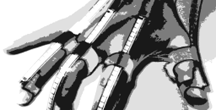
Exploring Ways of Interacting with the Computer
HyperSense Complex--the collaborative trio of Alistair Riddell, Somaya Langley, and Simon Burton--have been working together since 2002. They've been exploring the notions of collaborative interactive performance in a networked computing space (essentially where members of the trio - dependant on configurations of specific performances - can influence each other's sound, for example: by sampling each other's output, adding effects etc). HyperSense has also been developing an alternative HCI's using flex sensors worn on the hands (and strapped into a jacket arrangement). The project utilises data sent from the sensors through microcontrollers and passed via USB to some python scripting which handles what the sensor data should do. They then implemented OSC and are using this to send information to SuperCollider running on a separate laptop, which handles the samples and audiobased materials.
Posted by jo at 08:31 AM | Comments (0)
Ruccas.org
![]()
As Good as the Community Makes It
Today, Ruccas.org celebrates the end of its first year of operation, and the start of the next. A year ago, ruccas.org launched with a handful of artists. Today, it features the works of over seventy artists and collaborative projects, nearly all of which are available under a Creative Commons license.
Its growth and success are due entirely to the community, who have taken advantage of how easy it is to add their own page and share their work with one of the largest online audiences for unconventional electronic art. Ruccas.org's allowing of anyone to edit the site and add their own pages, as well as its offering of free hosting for aural, visual, and software art, has enabled this to happen. The ruccas.org philosophy is that the best way to create a site of this type is to give the community as much control as possible, and artists from all around the world have stepped up and proven that our philosophy is correct.
In the coming year, I personally hope that the site will continue to grow at the rapid rate it has been. Ruccas.org is a unique hub in the sense that is it only as good as the community makes it. Therefore, I urge all of you out there who are are trying to do something "new" to come share your artwork with us, and to encourage others to do the same. I know that I speak for the entire ruccas.org community when I say that we're looking forward to the next year of new additions, new directions for the site, and new community members.
- John Nowak, Ruccas.org
Posted by jo at 08:20 AM | Comments (0)
Exploration of TIME + Delay Phone
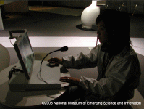
Delay as a New Communication Style
The Exploration of TIME exhibition poses the question "(i)s it "time" that produced humans, or is it humans that created "time"? "Humans are inseparably bound up with "time." Time assumes diverse, multi-layered forms in the world ranging from the micro- and macro-world of science such as the universe, living organisms, life, and materials, to the world of cultural representations such as Our explorations and experiences in a new world of time will certainly provide us with a hint for humans' future lifestyle or ways to deepen our thinking."
Delay Phone, by Ryota Kuwakubo, is a video phone system that allows users to intentionally increase or decrease the delay in audio communication. This system is designed to experience how subtle changes of the delay in audio communication may affect our inter-personal communication. It may also allow users to see how new communication styles may emerge with a certain amount of delay.
One of Kawakubo's major interests is in how technologies may change the way people communicate. R/V and PLX clearly reflect his interests in this area. Even, a knocking machine Duper/Looper is inspired by the way we communicate in a specific context: bathrooms. Imagine a machine like this inside a bathroom, which knocks back the door copying exactly the way you knocked…Related websites: vector::scan and Time Travel Exibition at YCAM (in Japanese) [blogged by manekineko on we-make-money-not]
Posted by jo at 08:03 AM | Comments (0)
August on -empyre- soft-skinned space:

Wearable Technologies
This month on -empyre-, we venture into the world of wearable technologies in the context of social and public art practice. Katherine Moriwaki (US) is an artist and researcher investigating clothing accessories as the active conduit through which people create network relationships in public space. Florian 'Floyd' Mueller (AU) designs interfaces that deliberately require intense physical effort to facilitate social connectedness between remote participants. Heidi Kumao's (US) incisive feminist practice currently investigates the RFID tags that industry is adopting for product tracking, the government for border control and public libraries for automatic checkout.
Katherine Moriwaki is an artist and researcher investigating clothing and accessories as the active conduit through which people create network relationships in public space. After receiving her Masters degree from the Interactive Telecommunications Program at New York University's Tisch School of the Arts, Katherine co-developed and taught the ground-breaking collaboration studio "Fashionable Technology" at Parsons School of Design. Currently a Ph.D. Candidate in the Networks and Telecommunications Research Group at Trinity College Dublin, her work has appeared in IEEE Spectrum Magazine, and numerous festivals and conferences including numer.02 at Centre Georges Pompidou (02), Break 2.2 (03), Ubicomp (03,04), eculture fair (03), Transmediale (04), CHI (04), ISEA (04), Ars Electronica (04), Wired NextFest (05), and Siggraph (05). She is a 2004 recipient of the Araneum Prize from the Spanish Ministry for Science and Technology and Fundacion ARCO.
Florian 'Floyd' Mueller is a Principal Scientist in the ICT Centre, leading the "Connecting People" group at CSIRO - Commonwealth Scientific and Industrial Research Organisation, Australia. His research interests are in novel interfaces that help people to connect, to media as well as to other people, creating a more seamless connection between humans and technology. He proposed the concept of Exertion Interfaces: interfaces that deliberately require intense physical effort to facilitate social connectedness between remote participants at
Heidi Kumao is an artist who dissects ordinary social interactions using new media and animation, kinetic/electronic sculpture, and performance art. Her work takes the form of intimate robotic/kinetic installations, single channel videos and animations, and wearable electronics. She uses technology to address feminist issues and insert a femal point of view into the world of high-tech innovation. "WiredWear" consists of the research, design, and creation of one-of-a-kind articles of women's clothing equipped with custom electronics and an accompanying informational video. Each article enhances the wearer's everyday life by transforming the smallest social interaction or relationship into a performative exchange or by providing the wearer with important vital information (words of encouragement, bio feedback, etc.). Kumao also works collaboratively with Preemptive Media, a group of artists, activists, and technologists to create projects around emerging technologies and their corresponding policies such as RFID (Radio Frequency Identification). Their most recent project, Zapped!, investigates the RFID tags that industry is adopting for product tracking, the government for border control and public libraries for automatic checkout.
Posted by jo at 07:08 AM | Comments (0)

